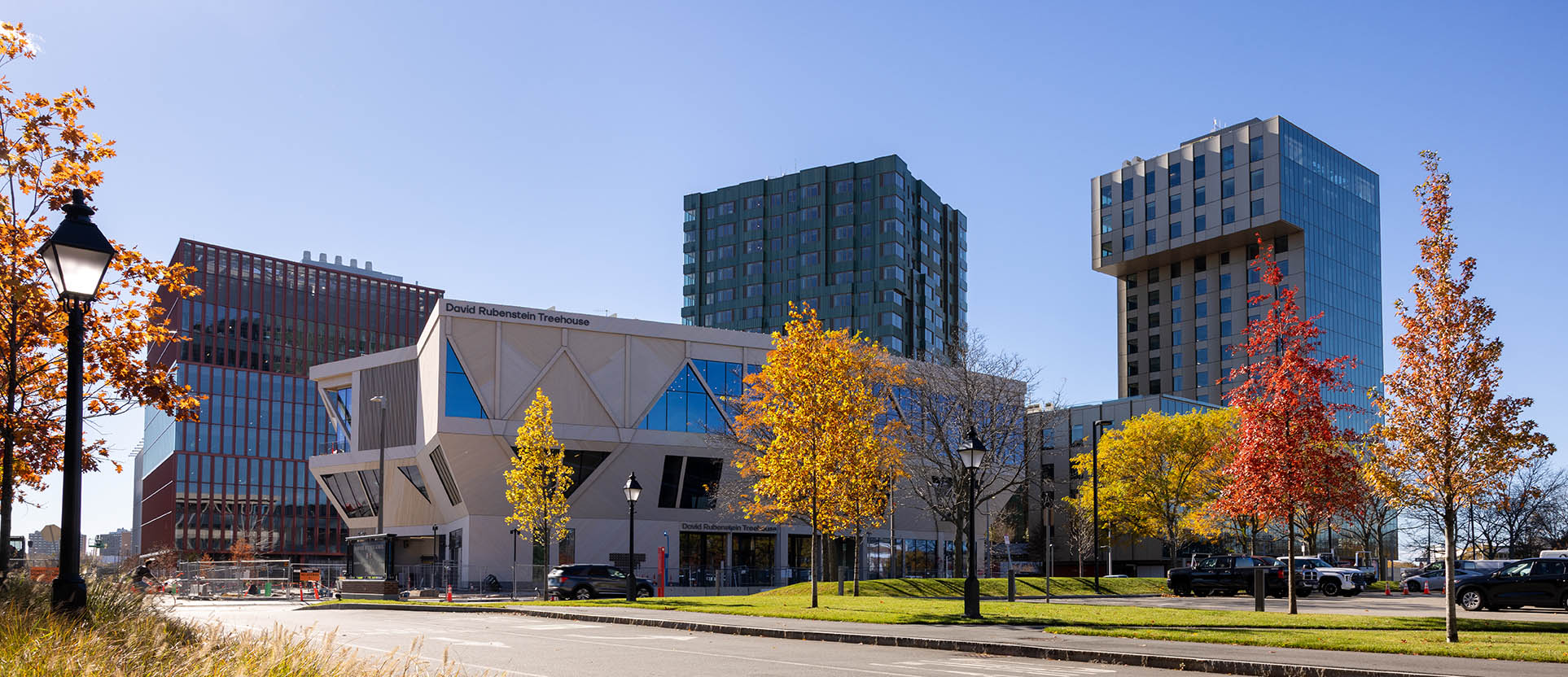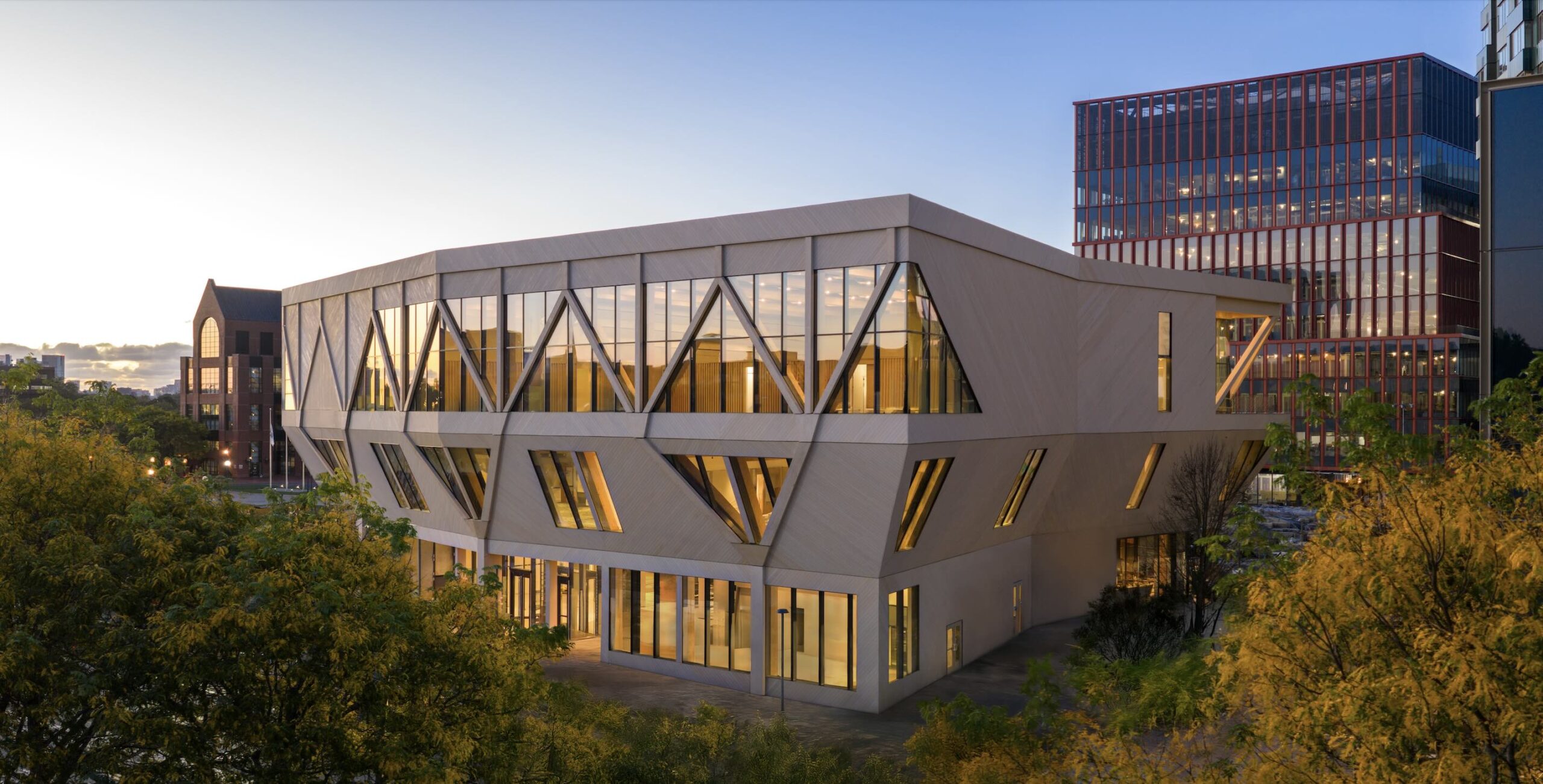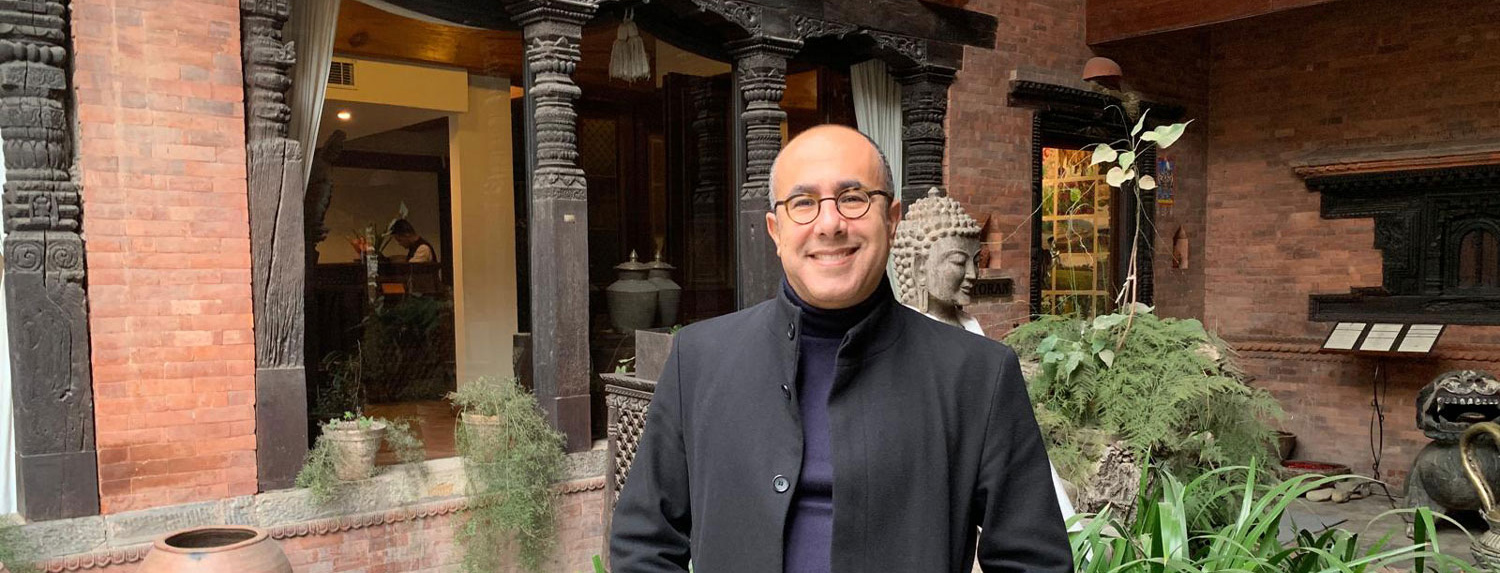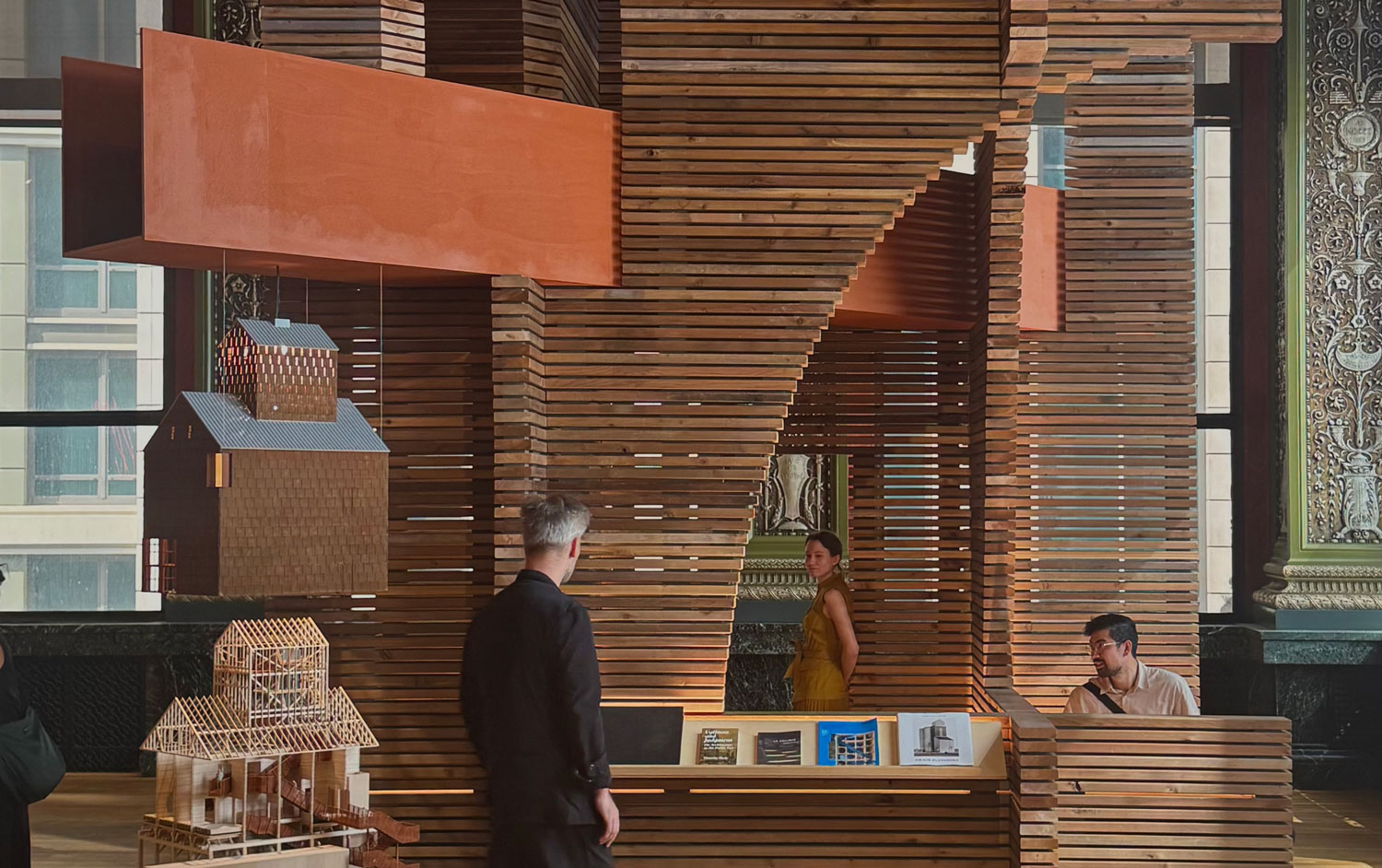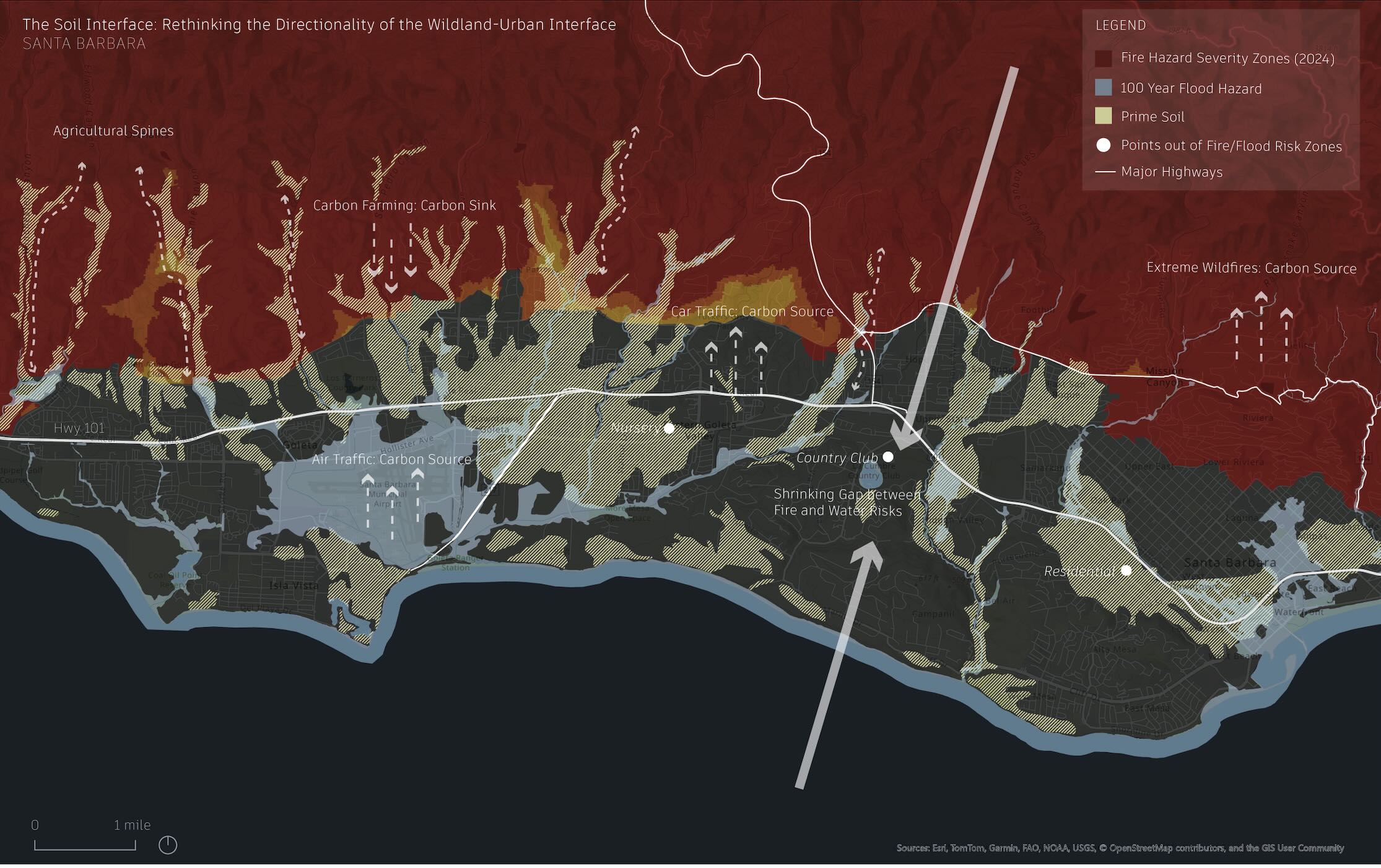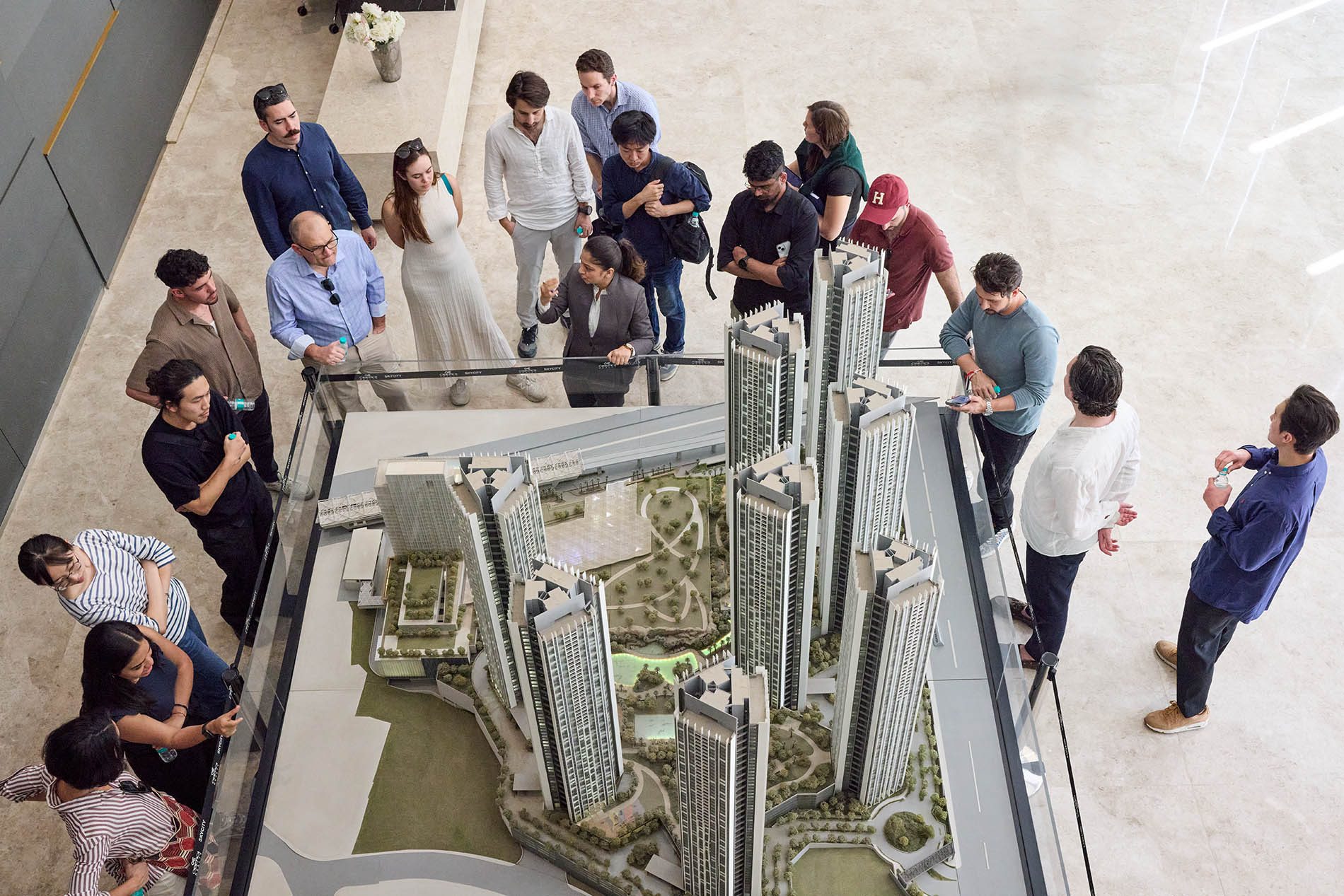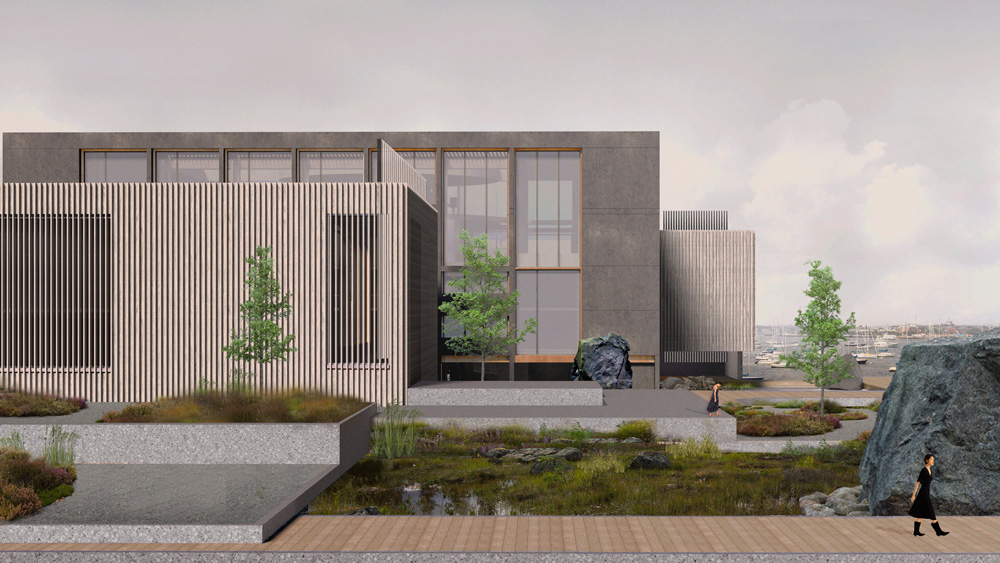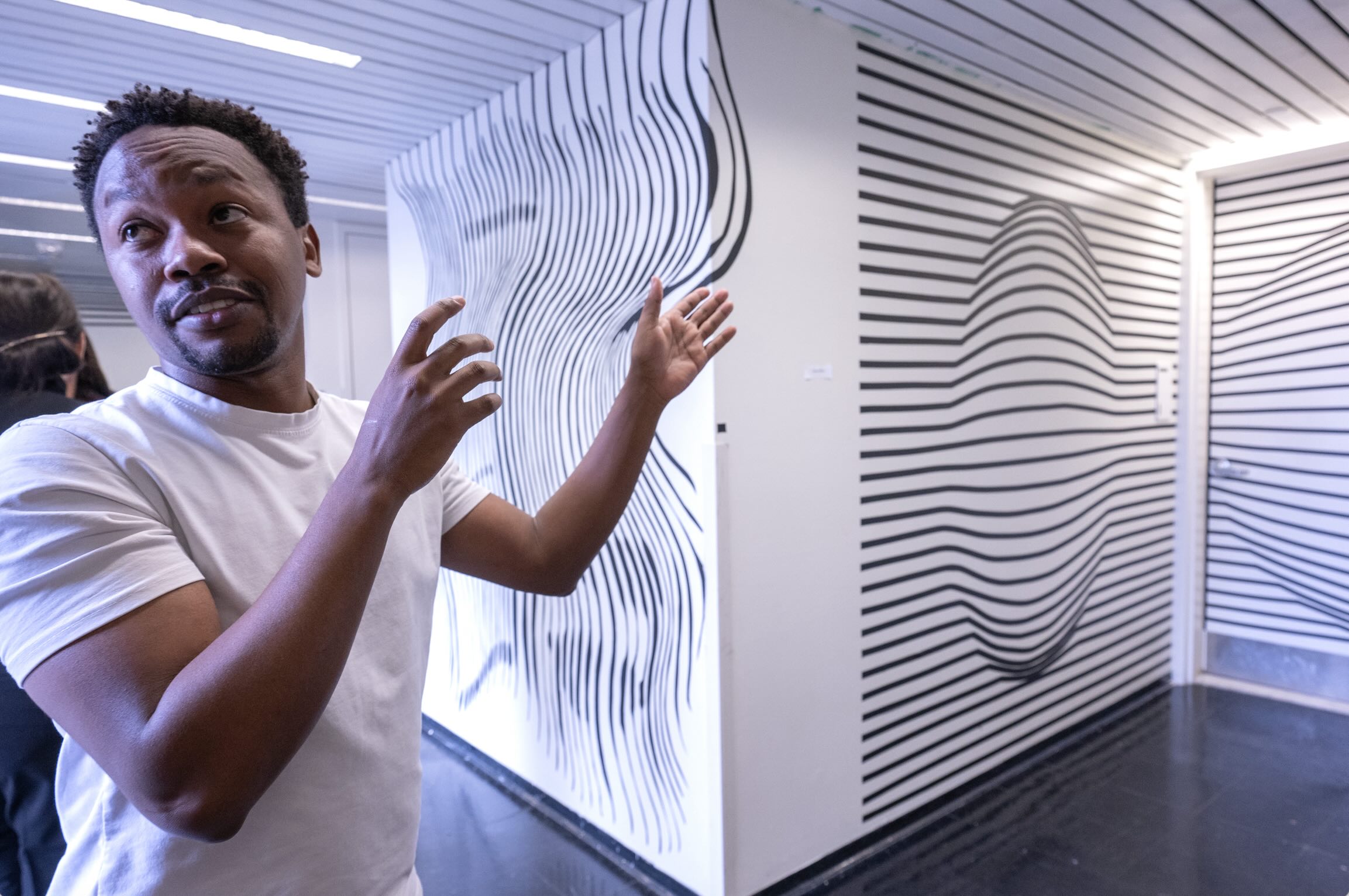GSD Faculty and Alumni Integral to the Creation of Harvard’s Enterprise Research Campus
After more than a decade of orchestration, the first phase of Harvard’s Enterprise Research Campus (ERC) —a vibrant mixed-use district in Boston’s Allston neighborhood—is nearing completion, culminating the coordinated efforts of stakeholders from Harvard University, the City of Boston, local resident groups, and design professionals. Notably, faculty and alumni of Harvard’s Graduate School of Design (GSD) have played integral roles in the ERC, from conceptualization and planning through design and construction.
Envisioned as an innovation hub to foster collaboration among academia, industry, and the surrounding community, the ERC occupies a 14-acre swath of land across the Charles River from Harvard University’s historic campus in Cambridge, Massachusetts, adjacent to the university’s Business School and the Science and Engineering Complex. GSD faculty have contributed significantly to the ERC, including Jeanne Gang of Studio Gang , which led the master plan of the neighborhood-scale project with Henning Larsen ; Tim Love of Utile , which served as master plan coordinator; and Alexis Landes (MLA ’10) of SCAPE , responsible for landscape design throughout the project.

Stewarded by Harvard Allston Land Company (HALC) and developed by Tishman Speyer , the ERC encompasses two phases. Construction on the first portion, Phase A, officially began in November 2023; its 900,000 square feet of facilities began opening this summer and will continue into early 2026. This includes:
- David Rubenstein Treehouse: a university-wide conference center offering meeting and special event space
- One Milestone East and One Milestone West: two cutting-edge laboratory buildings offering 440,000 square feet of lab and office space
- Residences at Verra: 343 residential units over two buildings, an 8-story mid-rise tower and a 17-story high-rise that feature a green roof-top terrace, ground-floor retail, and resident amenities
- The Atlas Hotel: 246-rooms in a 16-story tower with ground-floor restaurants, shops, and cafes
- Greenway and flexible outdoor space: more than 2 acres of publicly accessible green space to host events including farmer markets, musical performances, and fitness classes
ERC’s Phase B, located on a 4.8-acre parcel to the west and south of Phase A and not yet scheduled for construction, will contain an additional 720,000 square feet of lab and office space, 320,000 square feet of residential housing with a mix of ground-floor retail and community spaces, and public landscaping.
With a variety of contributions, GSD faculty and alumni have helped shape the ERC through all stages of its evolution.
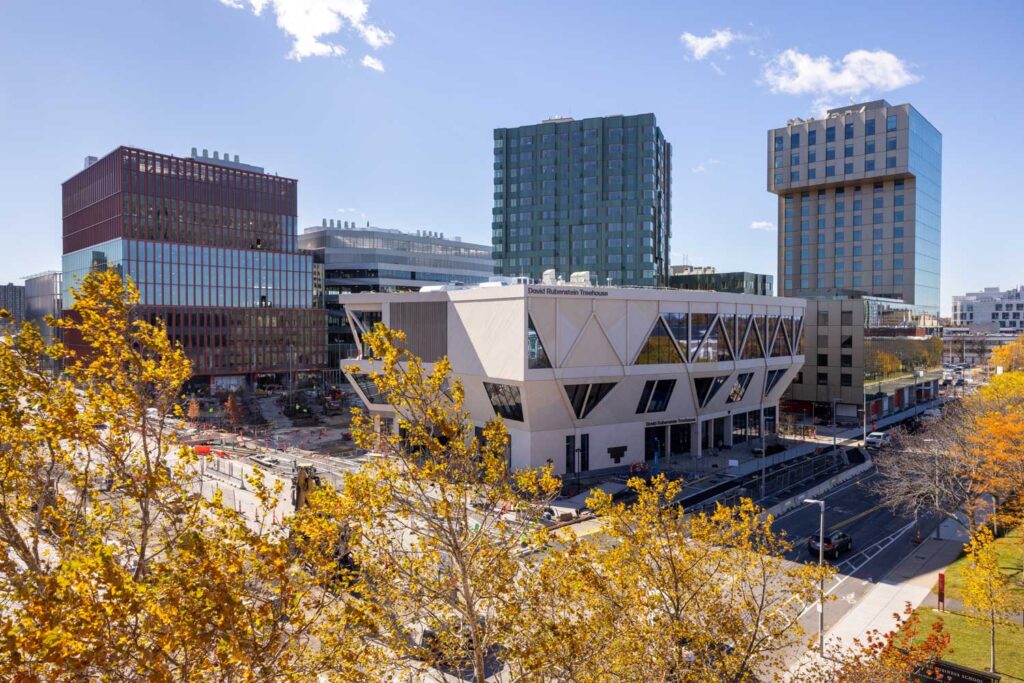
Conceptualization and Overall Development
Alex Krieger (MCU ’77), professor in practice of urban design, emeritus, was deeply involved in the conceptualization and evolution of the university’s Allston strategy and properties, including the School of Engineering and Applied Sciences complex, the American Repertory Theater, and the ERC. Krieger consistently served on design advisory, review, and selection committees related to the Allston expansion. A close advisor to former Harvard president Drew Faust and executive vice presidents for administration Sally Zeckhauser and Katie Lapp, Krieger co-led Harvard’s Allston Work Team, whose 2011 recommendations established the groundwork for, among other things, what would become the Harvard Allston Land Company.
Stephen Gray (MAUD ’08), director of the Master of Architecture in Urban Design program, associate professor of urban design, co-director of the Master of Landscape Architecture in Urban Design degree program, is founder and principal of Grayscale Collaborative . Gray worked with HALC to explore detailed development scenarios prior to drafting the developer request for proposals (RFP); help select Tishman Speyer, the design team, and the master developer; lead a cross-team facilitated process across various client heads and designers, including a reimagined design review; and provide direction from the ERC equity and inclusion framework.
Mohsen Mostafavi, Alexander and Victoria Wiley Professor of Design and Harvard University distinguished service professor, served as dean of the GSD from 2008 to 2019 and took part in university-wide advisory committees on Allston’s development.
Shaun Donovan (MArch/MPA ’95) worked directly with President Faust and Harvard leadership to establish the vision and planning for Allston, as well as create the land company that is now developing that vision. This includes projects such as the ERC, American Repertory Theater, and more affordable housing.
Harvard Allston Land Company (HALC): In 2018, Thomas P. Glynn III was named founding chief executive of the HALC, a wholly owned subsidiary of Harvard University established to develop the ERC. Under Glynn, who taught at the GSD in urban planning and design as well as at the Harvard Kennedy School, HALC issued a call for developers in 2019 and selected Tishman Speyer the following year.
Following Glynn’s retirement in 2021, Carl Rodrigues, GSD lecturer in real estate, became chief executive officer of the Harvard Allston Land Company. Rodrigues has overseen securing project entitlements, construction financing and financial close on the ground leases, construction, and the opening of Phase A buildings.
Tishman Speyer : For more than five years, Rustom Cowasjee (MAUD ’82) has directed the overall development of the ERC and all aspects of the project’s design and construction for Tishman Speyer, a global corporation in real estate investment, development, and management. This includes orchestrating the distinct design and construction teams responsible for the ERC’s Phase A buildings alongside the cohesive landscaping approach that unites this new mixed-use neighborhood.
Halls Lane Studio : As a consultant to Tishman Speyer working closely with Cowasjee, Halls Lane Studio—led by Jay Berman (MArch ’98)—served as a strategic design and planning advisor, helping to select and onboard architecture and engineering teams, map design processes, frame stakeholder engagement, and guide design evolution of lab/office, residential, hotel, conference center, and overall site planning during program confirmation, concept, schematic, and design development phases of the project.
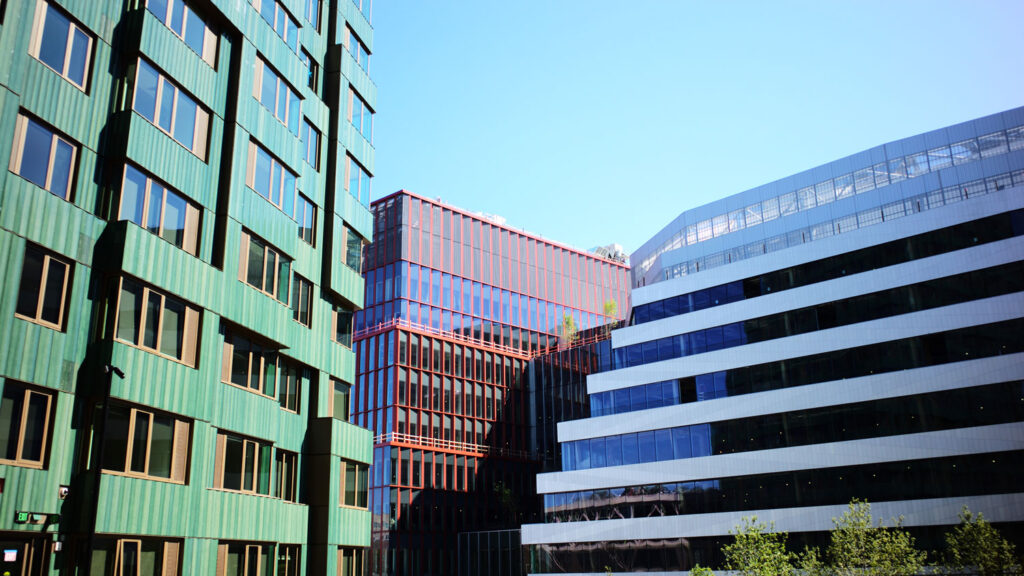
Urban Design and Landscape
Studio Gang : Led by founding partner Jeanne Gang (MArch ’93), Studio Gang took part in multiple facets of ERC including serving as co-design lead with Henning Larsen for the mixed-use district’s master plan, covering 14 acres of land adjacent to the Harvard Business School and Harvard’s Science and Engineering Complex. Other GSD alumni at Studio Gang who contributed to the ERC plan include design director Ana Flor (MArch ’10), Arthur Liu (MArch’13), and Spencer Hayden (MArch ’17).
Henning Larsen : With Studio Gang, Henning Larsen served as co-design lead for the ERC’s master plan as well as the architectural design for One Milestone East and its connector. Harvard alumni engaged in one or both aspects of the project include Bomin Park (MAUD ’20), as senior designer; Kritika Kharbanda (MDes ’23), on sustainability; Evan Shieh (MAUD ’19), as urban planner; and Ece Comert-Fisher (MArch ’18), as designer.
Utile : Utile, founded by Tim Love (MArch ’89), coordinated the master plan for the ERC. Love—GSD lecturer and senior fellow in real estate and urban planning, and assistant director of the Master in Real Estate program—is Utile’s principal-in-charge on master plan coordination; Jessy Yang (MAUD ’17), project manager; Loren Rapport (MAUD ’18), urban designer; and Andrew Nahmias (MArch ’16; now at Boston Planning Department), urban designer.
SCAPE : Established by founding principal Kate Orff (MLA ’97), SCAPE is responsible for the greenway, central plaza, open space surrounding multiple buildings and on-structure landscapes, multi-modal streetscapes incorporating stormwater management infrastructure, and a laneway connecting Western Avenue to the greenway. Gena Wirth (MLA/MUP ’09) is SCAPE’s design principal-in-charge of the ERC; Alexis Landes (MLA ’10), management principal; Brad Howe (MLA ’15), design lead; and Rose Lee (MLA ’18), designer and construction administrator. Adopting a creative palette of pavers, plantings, and other elements, SCAPE’s landscaping strategy unites One Milestone East and West, the Verra Residences, the David Rubenstein Treehouse, and the Atlas Hotel into a cohesive, vibrant mixed-use development.
Sasaki : As an urban design principal at Sasaki, Martin Zogran (MAUD ’99) has actively led planning and urban design support for Harvard University’s Planning and Design (HUPAD) Allston Initiative (AI) planning group. Alongside the leadership of Marika Reuling of HUPAD AI, Sasaki has been engaged for over five years, helping to shape Harvard’s long-term land planning and community engagement objectives for the ERC, areas within the Institutional Master Plan, Beacon Park Yards, and greater Allston. GSD alumni at Sasaki also involved with this work include Dennis Pieprz (MAUD ’85), Mary Anna Ocampo (MAUD ’10), Laura Marett(MLA ’06; now at SCAPE), Rodrigo Guerra (MAUD ’17), and Gabriel Ramos (MUP ’19).
Gamble Associates : Founded by David Gamble (MAUD ’97), Gamble Associates has been an urban design consultant for the HALC since 2018. In this capacity, the firm has consulted in the review process, conducted urban design studies, collaborated with selected architecture and landscape designers, and have been involved with design review.
Level Infrastructure : Level Infrastructure, led by founding director Byron Stigge (MDes ’08), acted as infrastructure consultant for the ERC master plan.

Architecture
Studio Gang : Led by founding partner Jeanne Gang (MArch ’93), Studio Gang designed the David Rubenstein Treehouse and One Milestone West. Managing partner Mark Schendel (MArch ’89) contributed to the David Rubenstein Treehouse. Eric Zuckerman (MArch ’18), Art Terry (MAUD ’14), and Shunfan Zheng (MAUD ’20) took part in designing One Milestone West.
Henning Larsen : Henning Larsen designed One Milestone East, the connector between One Milestone East and West, and served as co-design lead with Studio Gang on the district’s master plan. Harvard alumni engaged in one or both aspects of the project include Bomin Park(MAUD ’20), as senior designer; Kritika Kharbanda (MDes ’23), on sustainability; Evan Shieh (MAUD ’19), as urban planner; and Ece Comert-Fisher (MArch ’18), as designer.
Marlon Blackwell Architects : Led by Marlon Blackwell, former visiting faculty at the GSD, Marlon Blackwell Architects designed the Harvard ERC Hotel, formally called the Atlas Hotel.
Moody Nolan : In his current role on the Harvard ERC Hotel/Atlas Hotel with Moody Nolan, Kevin Y. Lee (MArch ’09) has applied his design expertise to the construction administration process coordinating with HALC, Tishman Speyer, and construction manager Consigli-Smoot to ensure Marlon Blackwell Architects’ design vision is faithfully executed, bridging conceptual rigor with technical precision.
MVRDV : Nathalie de Vries, former visiting faculty at the GSD and one of the founders of MVRDV, led the firm’s design team for the ERC’s residential complex, Verra.
Arrowstreet : For One Milestone West, Arrowstreet served as architect of record and sustainability consultant. Amy Korte (MArch ’01), president of Arrowstreet, worked as a consulting partner, contributing early in the project during the entitlement phase as well as supporting the coordination with HALC. Andrea Brue (MAUD ’91), senior associate, provided early-phase design support as a project architect, contributing to programmatic layout and the development of schematic designs. Architectural designer Chi-Hsuan (Vita) Wang (MArch ’19; no longer at Arrowstreet) also contributed to the project.
Acentech : Benjamin Markham, president of Acentech and formerly a lecturer on acoustics at the GSD, led the firm’s involvement as acoustic consultant for One Milestone West.
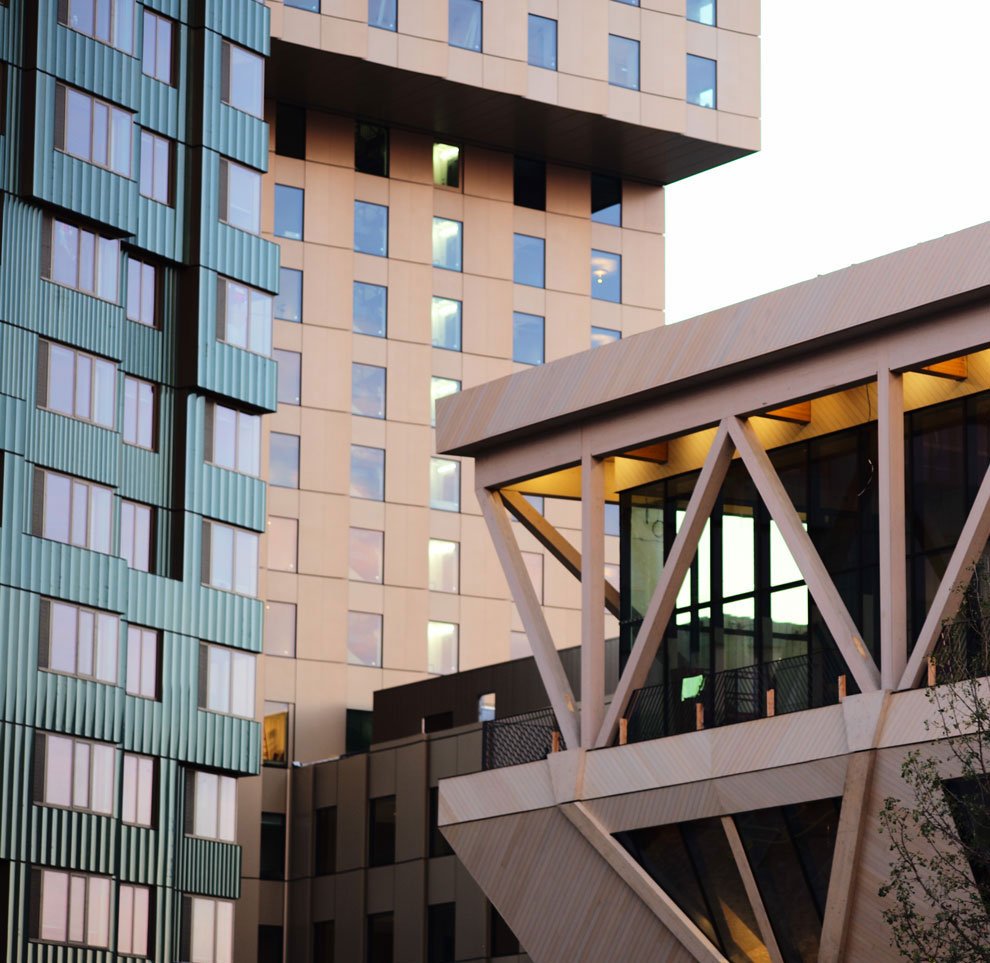
*Please contact us if you or your firm should be included in this article.
Jeanne Gang on the David Rubenstein Treehouse and the Future of Sustainable Design
As a child, architect Jeanne Gang built treehouses in the woods of her hometown— Belvidere, Illinois—so it was, perhaps, inevitable that she would one day design a building inspired by a place where she once felt so free.
“Growing up, I loved building treehouses,” Gang said. “There were several trees I’d climb to hang out in—and then,” she laughed, “I’d jump down when I was farther up than I’d realized. I love trees and feel there’s a deep connection between trees and humans.”
That sense of wonder and freedom became central to her design of the David Rubenstein Treehouse conference center for Harvard’s Enterprise Research Campus (ERC) in Allston. It is the university’s first project employing mass timber, an engineered wood product used in the structures of large-scale buildings. Walk into the ground floor, and you will find an open central atrium, with wooden columns that rise and seem to branch out to the ceiling, operating as structural supports—but with the lightness of tree branches, notes Gang (MArch ’93), Kajima Professor in Practice of Architecture at the Graduate School of Design (GSD).
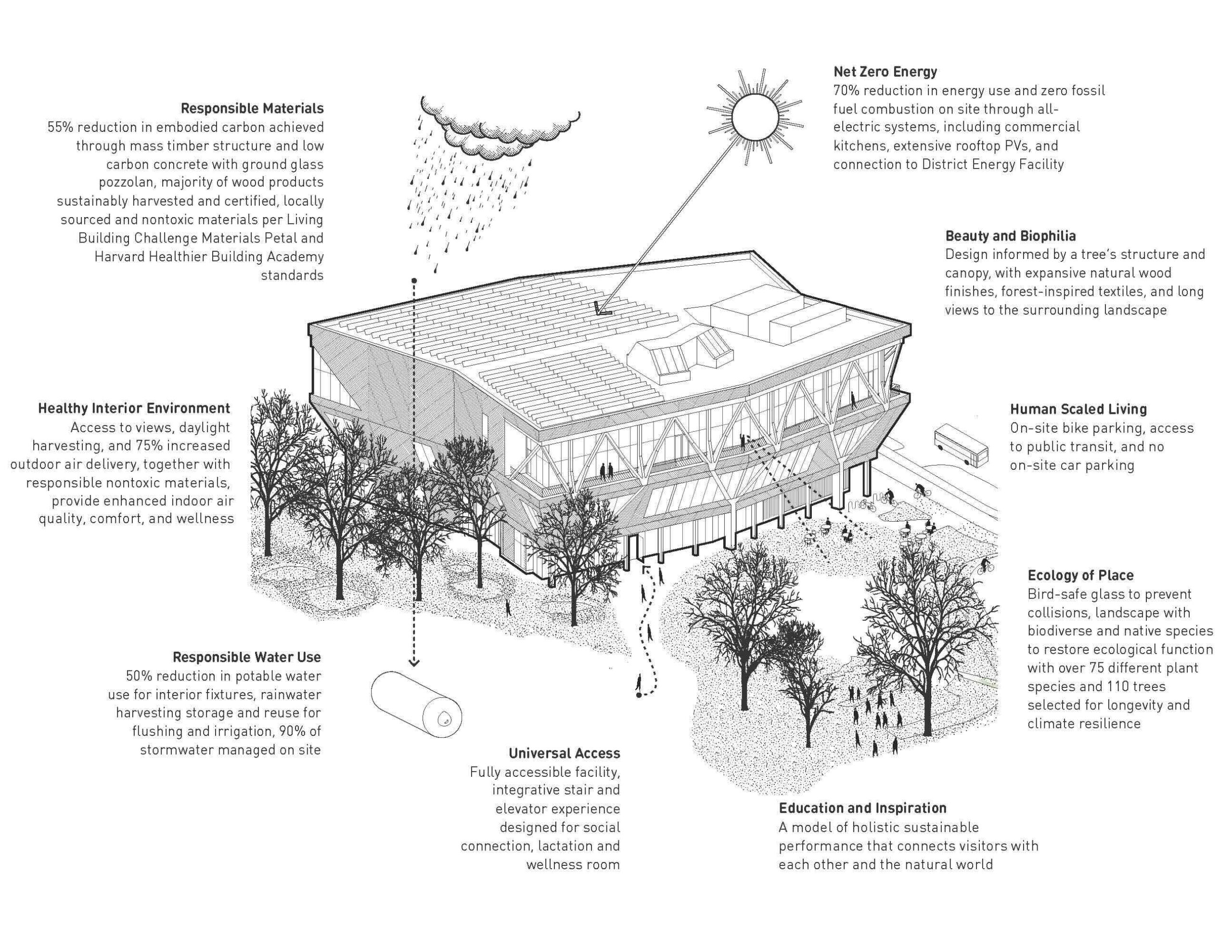
“Mass timber not only allowed us to make the building visually lighter, but also reduce its mass,” she explained. “As we explored the idea of using mass timber, it made sense to let our design be informed by trees. The structure has a logical yet dynamic quality to it that creates this feeling of being in a forest while you’re inside,” she said.
Gang has always been inspired by relationships found in the natural world. Her recent book, The Art of Architectural Grafting, explores how the horticultural practice of grafting can be used as a metaphor for adapting existing buildings into architecture with increased longevity. Her recent studios at the GSD have focused on the cultural and environmental aspects of buildings’ reuse. This past spring, she taught “Grafting the Aquarium,” prompting students to create an “expanded, flourishing, and distinctive work of architecture” using her concept of architectural grafting. In 2020, she taught “Béton Brut and Beyond,” a studio that focused on extending the life and capacity of an existing Brutalist mixed-use social housing complex in Paris’s La Défense neighborhood, and in 2018, she taught “After the Storm: Restoring an Island Ecosystem” in St. Thomas, following Hurricanes Irma and Maria in 2017. This fall, with historian Lizabeth Cohen, she guest edited issue 53 of Harvard Design Magazine , on “Reuse and Repair.

Recent projects completed by her firm, Studio Gang , based in Chicago with offices in New York, San Francisco, and Paris, include the Richard Gilder Center for Science, Education, and Innovation at the American Museum of Natural History in New York. The building’s central atrium, whose design is informed by geological formations shaped by wind and water, draws visitors in, encouraging them to explore and learn. The Arkansas Museum of Fine Arts , with a design that recalls a very different form found within nature, was “conceived of as a stem that blossoms to the north and south.” Both projects are an example of her grafting technique, which expands the capacity of existing structures with new and strategic additions. And, the design for Populus , a hotel in Denver, draws from the characteristic patterns found on the region’s Aspen trees to create a distinctive façade. Her iconic Aqua Tower, in Chicago, offers opportunities for connection to the city and neighbors along its exterior balconies.
Gang is not only inspired by nature but also has a keen interest in “how the things we do as architects can either support or harm the living beings around us.” She is an avid hiker who loves bird nests for their “beauty, humility, and efficiency” as structures, and advocates for biodiversity and protection of creatures with whom we share the natural and urban environments. For instance, architectural elements such as fritted glass can be deployed to protect migratory birds from collisions with windows that are often fatal—especially as they navigate through cities on waterways like Boston and Chicago.

In the Rubenstein Treehouse’s central, open atrium, natural light filters in from the upper floors and tensile members from upper beams help to support the tree-like branches of the lower beams, creating an “organic,” airy quality in the space. The ground floor welcomes the public with a soon-to-open cafe and casual spaces for meeting or studying, while conference-goers can ascend winding stairs to the top floor.
Often in conference centers, Gang noted, the meeting hall is on the ground floor for its ease of access, but she felt strongly that locating it on the top floor and infusing the space with the feeling of climbing a treehouse’s rungs, would help people access their own sense of wonder and creativity. At the top, the hall offers expansive views across Boston and Cambridge.
“I’m interested,” said Gang, “in the feeling of being up in the canopy. Within the crown of a tree, you get both a vista to beyond and a sense of protection at the same time.”
The building is intended to serve as the welcoming point of the ERC, a decades-long project. Once the first phase of the campus is completed, it will also include a hotel, residences, and commercial lab space (including one designed by Gang), all intended to be connected by Allston’s Greenway, which will extend from the west, through the ERC, and onto the Charles River. At the Rubenstein Treehouse, Gang and her team wanted to leave room for human-scaled spaces between the building and the neighborhood around it. These include the Laneway, a pedestrian corridor between the Rubenstein Treehouse and the hotel. She emphasized the importance of fostering a sense of community in the neighborhood and creating opportunities for the public to take advantage of the conference center and ERC more broadly.
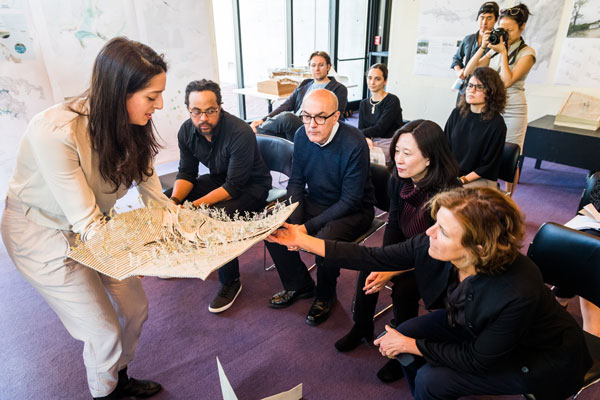
The Rubenstein Treehouse marks Harvard’s first mass timber building and Gang’s most ambitious use of the material. For over two decades, she has used mass timber, most recently in projects such as the expanded campus of the California College of the Arts as well as academic and residential buildings at Kresge College at UC Santa Cruz. When she began designing the Rubenstein Treehouse, the “idea of creating social spaces around the vertical circulation, came first,” said Gang, “and very soon thereafter, we considered using mass timber.”
In addition to the aesthetic potential of mass timber, of course, it gives Harvard the opportunity to meet its high environmental standards. The wood structure helps to reduce the building’s embodied carbon by 55 percent compared to a similar building. Using the material for a large conference center has its challenges. “The hardest thing about using mass timber,” Gang said, “is that you want to expose it,” which requires a great deal of organization of the various building systems that would otherwise be hidden behind closed ceilings. The team had to balance the airy aesthetic of the mass timber design along with the complex mechanical systems required to support the building with the most sustainable means.
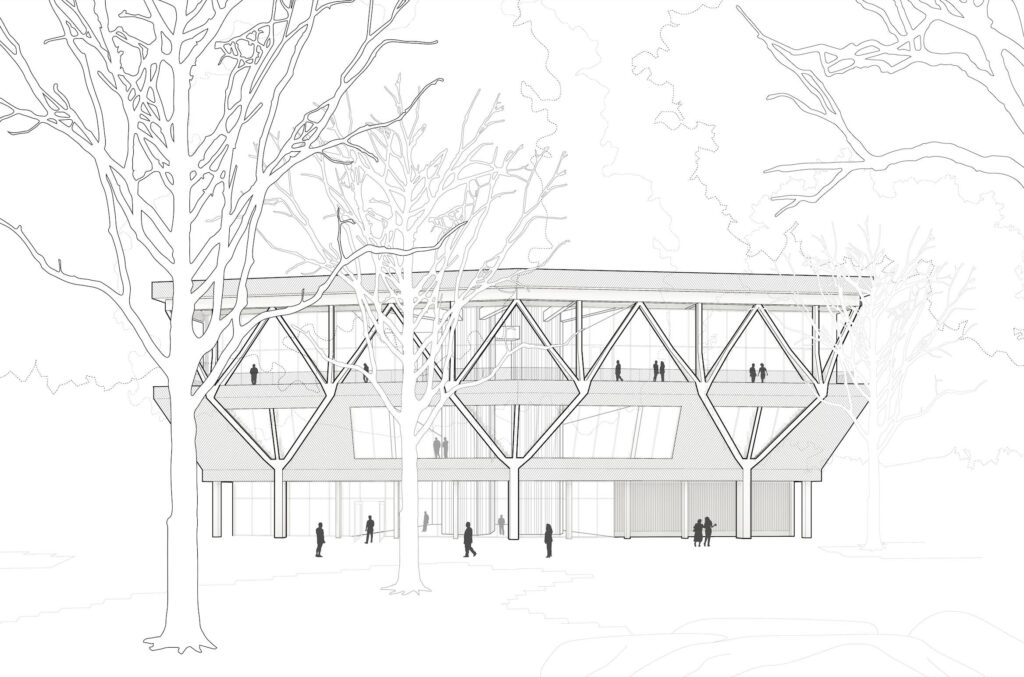
The Rubenstein Treehouse is also one of the first buildings in Massachusetts to use concrete made with ground glass pozzolan, another element that helps reduce the building’s embodied carbon. Modern pozzolan is a glass aggregate that reacts with water, not unlike the volcanic pozzolan that ancient Romans added to concrete, Gang explained. The pozzolan employed in the Rubenstein Treehouse is derived from post-consumer glass containers, making the material cleaner than fly ash, a byproduct of coal combustion often used in concrete.
The conference center’s design minimized basement space in order to use less concrete, and, to reduce energy, also makes use of solar panels, natural daylighting and self-shading, and a connection to Allston’s District Energy Facility.
“It was really exciting,” said Gang, “to work on something that offers a peek into the future of what sustainable buildings can achieve.”
International Conference Takes a New View on Latin American Cities
This month, scholars from the Harvard Graduate School of Design (GSD) gathered with researchers from across the Americas to explore how new approaches to visualizing Latin American cities can produce insights about the historical, geographic, social, and economic factors driving urban growth. The conference “Visualizing, Representing, and Interrogating Latin American Urbanism: Buenos Aires, São Paulo, and Mexico City” suggested both the contexts these cities shared and the specificity required to understand their unique histories.
The GSD’s Diane E. Davis, Charles Dyer Norton Professor of Regional Planning and Urbanism, and Eve Blau, adjunct professor of the history and theory of urban form and design, co-organized the colloquium with Heliana Angotti-Salgueiro of the IEA-University of São Paulo. Presentations spanned topics from the use of satellite imagery to assess urbanization in the Amazon to creative activations of archives related to São Paulo’s growth to the cultural imagination of water in Mexico City. Introducing cutting-edge digital tools while reassessing historical sources, the colloquium overall pointed to new trajectories in understanding Latin America’s largest and fastest-growing metropolises.
The Harvard colloquium, co-sponsored by the Mahindra Humanities Center at Harvard, the David Rockefeller Center for Latin American Studies (DRCLAS), and the GSD, built on a previous conference on a similar topic that took place in São Paulo in 2024. Both had roots in longstanding research undertaken at the GSD as well as Angotti-Salgueuiro’s time at Harvard, first in 2018 when she was researching the representation of cities, and then as a visiting scholar at DRCLAS in 2021–2022.
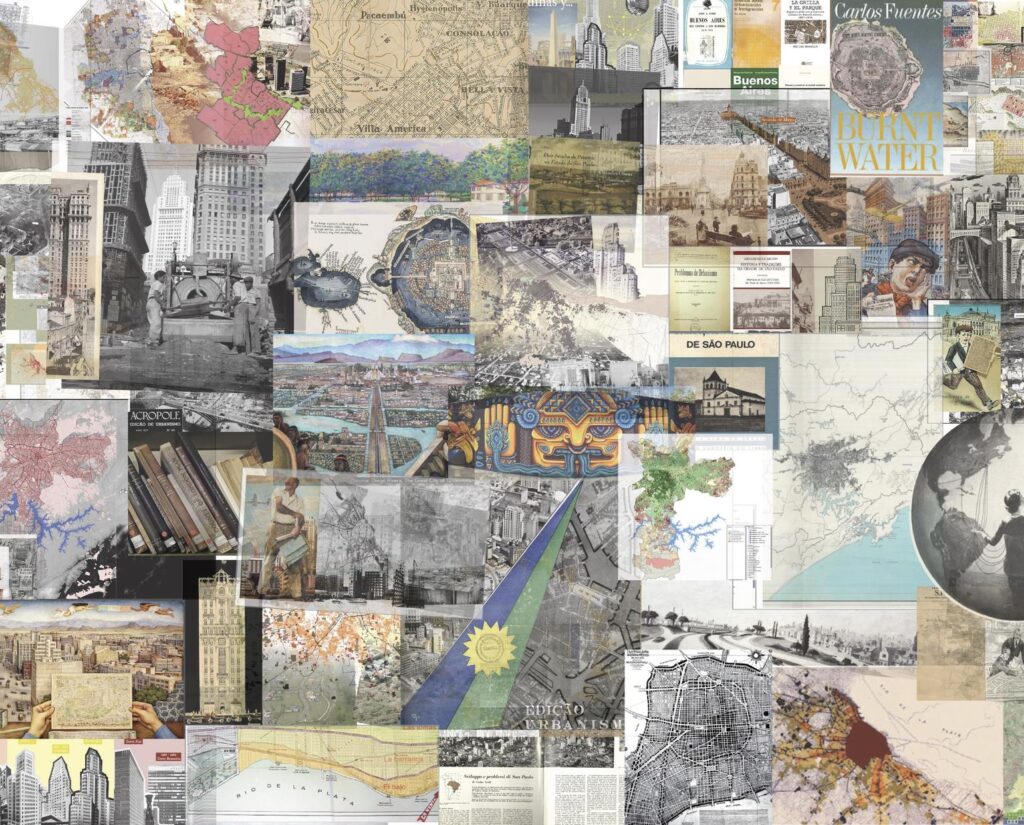
In 2018, she encountered the Druker Design Gallery exhibition Urban Intermedia: City, Archive, Narrative . That media-rich presentation was the culmination of the four-year Harvard Mellon Urban Initiative, co-directed by Blau. Focused on bringing together scholarship, design, and new media, the Harvard Mellon Urban Initiative fostered interdisciplinary research on four cities: Berlin, Boston, Istanbul, and Mumbai. The project aimed to use new media tools to better understand patterns of growth, migration, and the tensions between urban design and unplanned human behavior. One outcome of this Harvard Mellon Urban Initiative, the 2018 exhibition featured rich animations that wove together maps, drawings, photographs, films and textual accounts to represent complex, multilayered urban centers.

Speaking at the plenary session of the conference, Blau provided a methodological foundation for the convening, describing how the approach behind Urban Intermedia could be applied to Latin American cities. As the conference brief explained, the aim of the gathering was two-fold: “understanding of media as a tool for storytelling, argumentation, and reinterpretation in urban studies,” as the Harvard Mellon Urban initiative demonstrated, as well as “the interrogation of particularities of Latin America’s cities and environments as captured through imagery.”
Some of the project shared at the conference could be as visually stunning as they were informative about urbanism. Gabriel Kozlowski, a doctoral candidate at the GSD and founding partner of POLES–Political Ecology of Space, shared his research on “critical cartography.” Using satellite imagery and new mapping techniques, Kozlowski captures vivid representations of the urbanization of the Amazon to counter prevailing myths about the area. “The project makes visible the multiple layers composing the region,” he notes. “From the footprint of present societies to centuries-old territorial manipulation, the mapping presents the Amazon as a complex, human-shaped landscape rather than a homogeneous, pristine forest.” Produced as a collaboration between POLES and AO—Architects Office, the maps, presented as “Forest Gens” in this year’s Venice Biennale, convey vital knowledge about the region and stand as compelling aesthetic objects.

The particulars of Latin American urbanism were the focus of a conference session, moderated by the GSD’s Ana María Léon Crespo, associate professor of architecture, devoted to comparing urbanization in Buenos Aires and São Paulo, noting how “progress” in each context was often accompanied by violence and destruction. Beatriz Picollotto Siqueira Bueno of the University of São Paulo examined the city’s explosive growth during the early twentieth-century coffee boom. Using university archives, Bueno visualized the rapid urbanization of São Paulo as a metaphorical piano. She presented an animation that represented different buildings rising or being demolished (sometimes within as little as seven years) as keys on a cityscape keyboard. Virginia Bonicatto of the Universidad Nacional de La Plata, examined the development of skyscrapers in Buenos Aires and the kinds of cultural products—advertisements, films, even songs—that emerged in tandem with the profit-driven creation of the city’s skyline.
The emphasis on images in the conference also raised questions of what might be overlooked in visual histories of urbanization. Most directly, Davis presented research about the historical place of water in the cultural imagination of Mexico City, part of a larger project to narrate “the history of urbanization through the entanglement of cities and water.” As Davis described it, the development of Mexico City from an ancient pre-Colombian capital on a lake to a sprawling metropolis involved the infrastructural and visual suppression of water. Vast infrastructure projects removed water from the urban core as the role of water in everyday life receded from the cartographic representations of the city. Yet, in a changing climate, this collective overlooking has come at a cost, with water returning in the form of catastrophic flooding.
Bueno’s archival history of Brazil’s largest city also sought to reveal hidden aspects of urban development. The archive she oversees includes detailed construction photography depicting the multiracial members of the working class—Afrobrazilians and Japanese immigrants prominent among them—who actually built the city, yet whose contributions have been largely written out of narrative histories.
Following the conference was an exhibition of video works focused on Latin American cities, including work by filmmaker Pablo Martínez-Zárate, who had previously led a workshop for students at the GSD. In his talk at the conference, “The City Through Its Cracks,” he argued for the “crack” as a compositional strategy to visualize aspects of urban life that had previously been invisible. Looking back at the history of radical filmmaking, he proposed a “liquid montage” to emphasize fissures of meaning between images. Martínez-Zárate’s evocative approach to documentary film served as an appropriate capstone to a conference focused on interrogating historical lacuna. The scholars convened by Davis, Blau, and Angotti-Salgueiro sought out blank spaces and omissions from the historical record, areas that today urgently need to be seen.
Sameh Wahba: Expanding the Canvas of Sustainable Development
Sameh Wahba (MUP ’97, PhD ’02) navigates one of the most complex landscapes in global development. As the World Bank’s Regional Director for Sustainable Development in Europe and Central Asia, Wahba heads efforts to eradicate poverty and promote inclusive development in an area stretching nearly 5.5 million square miles, from Kazakhstan’s desert and steppes to the Mediterranean coasts. Within this vast territory, his mandate covers a diverse population and an extraordinary range of issues—helping countries strengthen agriculture and food systems, manage water and natural resources, adapt to climate change, build resilient cities, and foster social inclusion. With a $10 billion portfolio and a team of 200 experts over 23 regional offices, Wahba is tasked with creating a vision of sustainable growth that can withstand both the pressures of today and the uncertainties of tomorrow.
“For me, the Harvard Graduate School of Design (GSD) was a good entry for this work; it gave me a place to build on my background in architecture while pushing me toward new ways of thinking,” Wahba reflects. Indeed, over the course of his studies in the GSD’s master of urban planning and doctoral programs, he came to embrace design as inseparable from economic, sociological, and environmental concerns. Whether in his efforts with the World Bank or his sustained engagement with the GSD, this expansive framework continues to guide Wahba’s work today.
The GSD as Springboard: From Architecture to Global Development
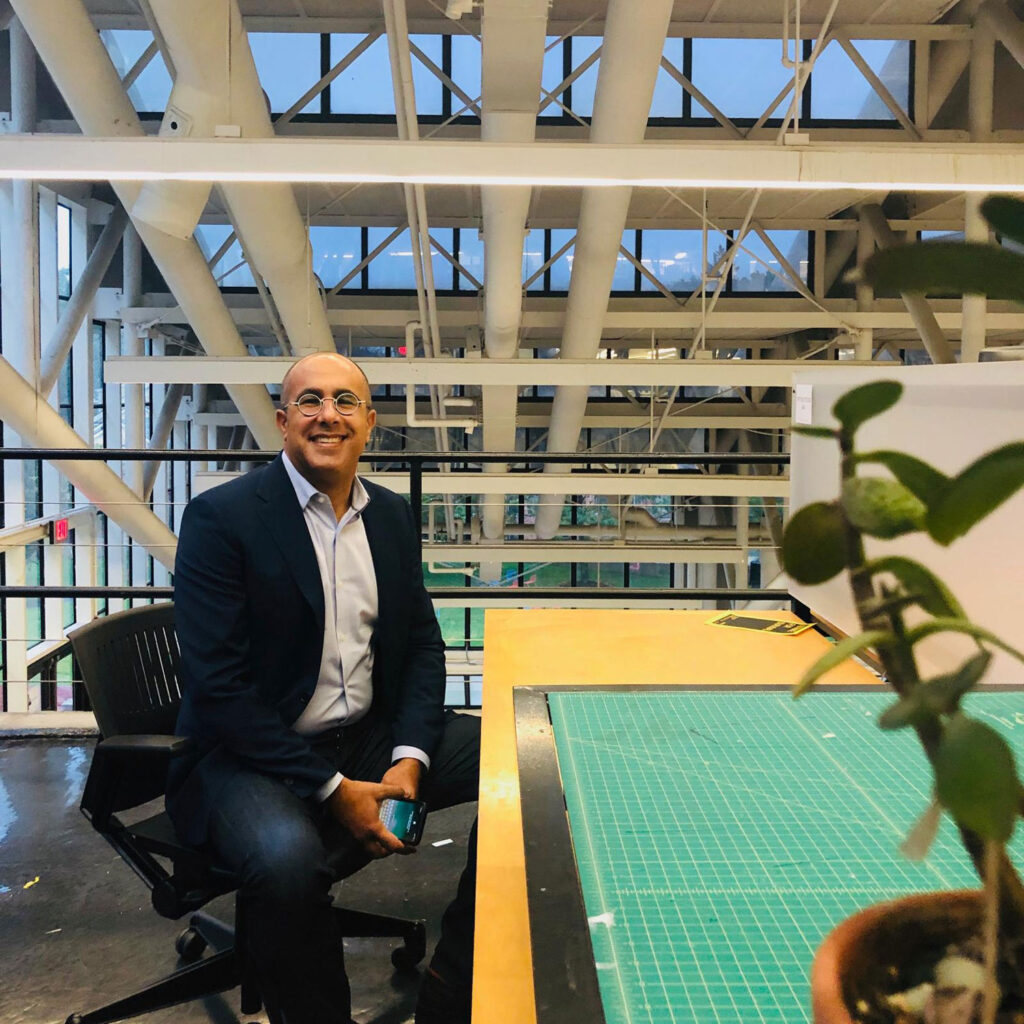
Wahba’s professional path began in Cairo, Egypt, where he completed a master’s degree in architecture with a focus on engineering. Interested in housing, he was inspired by the work of Hassan Fathy, whose pioneering low-cost housing projects demonstrated that affordability, culture, and beauty could align. But Wahba also recognized the limitations of such community development initiatives; for example, Fathy’s vernacular-inspired work didn’t always resonate aesthetically or functionally with the needs of those for whom he designed.
Arriving at the GSD, Wahba began to further explore the complexities of housing and community development. “My first couple of years, I complemented my existing design and spatial perspective with more quantitative tools, understanding the economics, the real estate finance dynamics, and the urban politics,” he recalls. The academic freedom allowed him to experiment broadly as he deepened his knowledge, drawing from design studios, planning courses, and policy seminars at the GSD, other Harvard schools, and the Massachusetts Institute of Technology (MIT). This latitude proved transformative. “The GSD was a place where I could take Alan Altshuler’s ‘Urban Politics and Planning’ at the same time as Rem Koolhaas’s ‘Harvard Project on the City,’ and then take Rafael Moneo’s ‘Design Theories in Architecture,’” Wahba notes. For his PhD committee, Wahba assembled diverse thinkers, working with Jerold Kayden on public-private development, Bill Doebele on international development, and Tony Gómez-Ibáñez on economics and public policy. Drawing from all three areas of expertise, he ultimately devised his own formula for work on land and housing policy. “The breadth of choice, within the GSD as well as across Harvard and MIT,” Wahba reflects, “gave me the intellectual flexibility that continues to shape my work.”
Overall, at the GSD, Wahba reframed his approach to urban and development challenges. “The school became a springboard for me; it let me experiment and connect design with the real forces shaping cities,” he explains. Wahba began to see design as a framework that could connect with economics, policy, and governance to create holistic solutions. As Wahba notes, the GSD’s multidisciplinarity “allowed me to expand the canvas. Whether it’s working on land policy, housing, or resilience, I’m always drawing from that foundation of ‘design-plus’.”
Integrating Insights to Create Solutions
Through his work with the World Bank, Wahba applies this “design-plus” concept within an amazingly broad context. While he currently directs efforts in Europe and Central Asia, throughout his 22 years with the institution he has been part of sustainable growth initiatives in regions around the world facing the pressures of rapid urbanization, environmental degradation, social inequality, and the intensifying impacts of climate change. Reflecting this complexity, Wahba’s portfolio encompasses projects across sectors, from improving land administration to supporting agricultural resilience to advancing energy and water sustainability. His work also includes helping governments strengthen disaster preparedness and recovery, a responsibility that has grown in urgency as extreme weather events increase in severity.

Crucially, Wahba emphasizes cooperation across domains, balancing technical expertise, policy advice, financing, and diplomacy—aspects that draw directly on the intellectual foundation he built at the GSD. “You cannot solve the housing crisis only with architecture,” he observes. “You have to think about finance, about land markets, about politics, about resilience, and you must integrate them all.” It is this perspective that Wahba brings to the World Bank. “Mainly we’re financiers,” he explains, “so we support governments in doing things. Yet with our research and the analytics, we’ve expanded the boundaries of the practice. And I’ve managed to introduce a stronger design lens to our work.” Since Wahba has joined the World Bank, he has helped countries grow significantly into issues of climate action, decarbonization, and adaptation. “We have moved into urban design, public spaces, nature-based solutions such as wetlands and mangroves—which serve decarbonization and flood mitigation purposes, but also in terms of creating green spaces, accessible spaces, thinking about mobility in the city.”
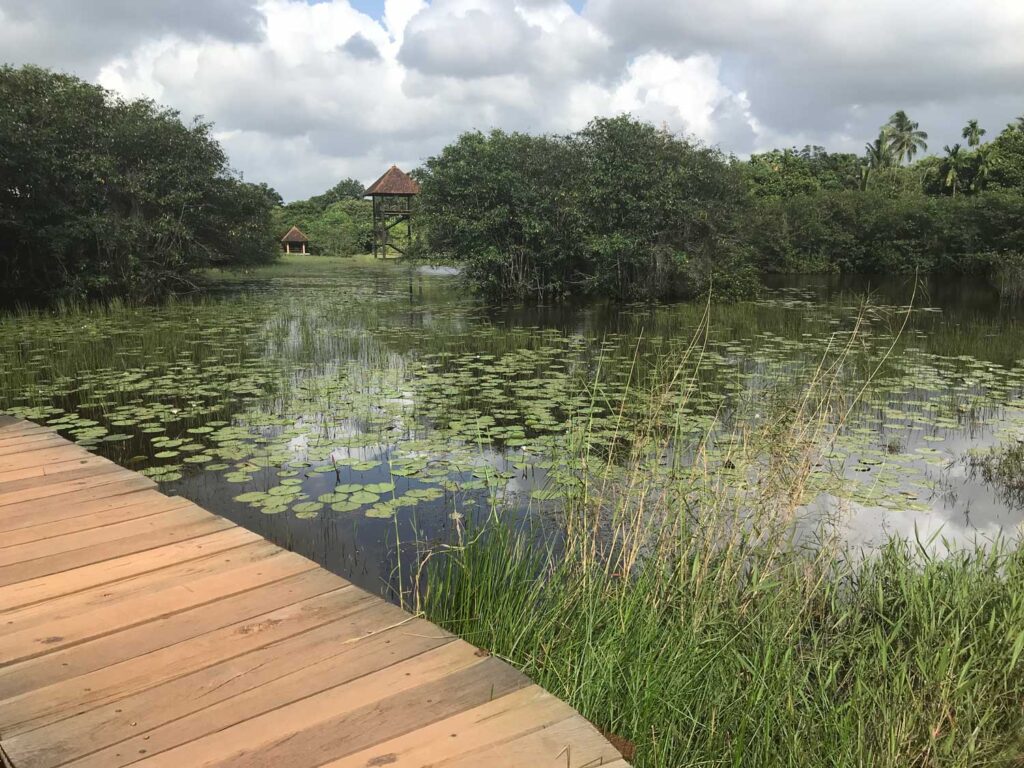
For Wahba, “expand the canvas” is more than a metaphor—it is a method of integrating insights across disciplines to generate practical, impactful solutions. It also means rethinking systems rather than simply delivering projects. For instance, in disaster prevention efforts, Wahba’s team helps rebuild infrastructure with embedded resilience measures that allow communities to emerge stronger. An example of such work is Beddagana Wetlands Park , part of the larger Metro Colombo Urban Redevelopment Project in Sri Lanka, which Wahba headed during an earlier role as Global Director for Urban, Resilience, and Land at the World Bank. His team transformed an 18-hectacre garbage strewn area into a thriving urban wetland that provides a recreational zone, regulates flooding, moderates atmospheric temperatures, and hosts an array of flora and fauna. At the same time, this regenerated wetland offers educational opportunities for local children and, through the development of concessions, generates revenue. Envisioned as a nature-based solution for flash floods, Beddagana Wetland has become a major amenity in the city, increasing biodiversity, residents’ property values, and their quality of life.
Another remarkable project occurred in Freetown, the capital of Sierra Leone, following a massive mudslide that killed hundreds of people and displaced thousands more. In addition to rehousing the affected population, the Sierra Leone Urban Resilience Program involved planting more than a million trees in the city for soil stabilization. This tree planting and care campaign simultaneously doubles as an income transfer program to alleviate poverty, with poor households engaged as environmental stewards. In exchange for pay, they plant the trees, grow them, and document their growth. Such creative programs support urban improvements while bolstering opportunity.

In many cases, Wahba’s team introduces new practices—such as the recently established Türkiye Water Circularity and Efficiency Improvement Project , which expands wastewater treatment and addresses water scarcity through the reuse of that water for agriculture and irrigation. And even seemingly small interventions can have a huge impact. Wahba cites an informal settlement upgrading program in Kenya where the installation of high mast lighting has changed communities: shops stay open later, kids without electricity at home bring books and study under the light, and crime rates drop. “It’s a complete transformation just because you put in a single light pole,” Wahba says.
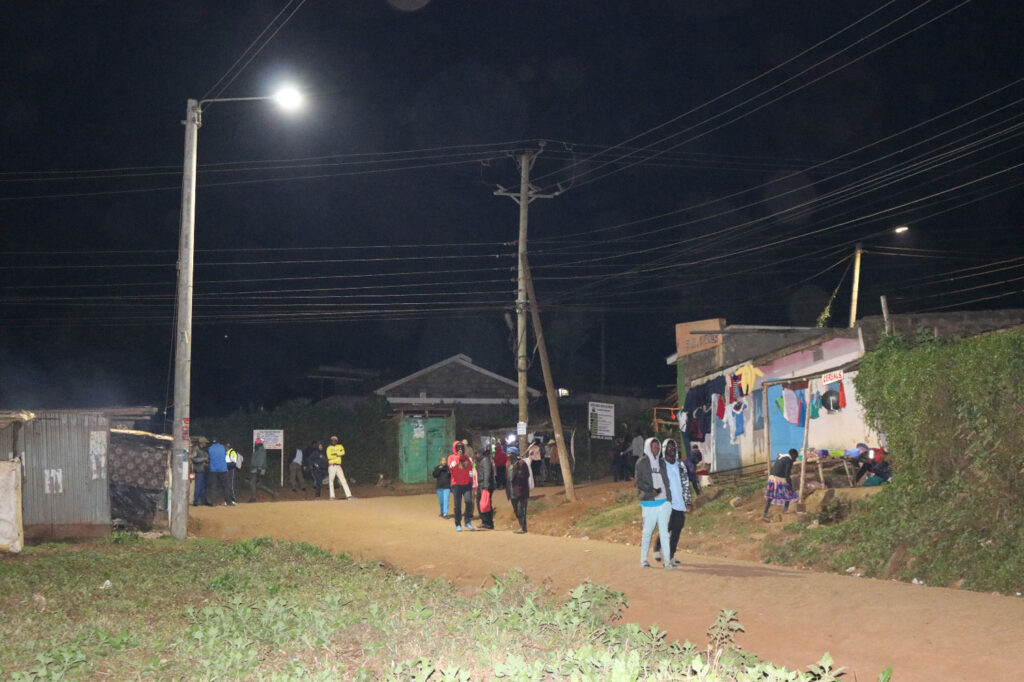
These initiatives reflect the interconnectedness of sustainable development and the imperative to bridge realms that, at times, have been treated as distinct. They also echo the GSD ethos of design as a framework that unites physical form with social, economic, and political realities.
A Continuing Conversation with the GSD
Even as he leads an expansive portfolio at the World Bank, Wahba remains closely connected to the GSD. Since July 2024 he has served as co-chair of the GSD Alumni Council, first with Nina Chase (MLA ’12) and now with Alpa Nawre (MLAUD ’11). Through the Alumni Council Wahba co-created Design Impact —a global speaker series in which practitioners share their visionary work on critical yet often overlooked topics, including upgrading slums and accessible design. Wahba is also a member of the Dean’s Council, through which he takes part in high-level discussions that help further the GSD’s reach within the university and beyond. He also recently began as an appointed director of the Harvard Alumni Association, representing the GSD. Indeed, Wahba sees the GSD as a vital incubator for the next generation of urban and development leaders—individuals who will tackle the increasingly complex challenges of climate adaptation, migration, housing crises, and social equity.
Looking back, Wahba positions his GSD experience as a reframing of design and the opportunities it brings. His wide-ranging explorations prepared him for a career where architecture merges with policy, spatial design intertwines with economic systems, and resilience demands creativity across disciplines. As Wahba affirms, “that multidisciplinary approach formed at the GSD comes to life in everything I do now.”
Harvard GSD Faculty and Alumni Feature Prominently in Chicago Architecture Biennial
As a Loeb Fellow at the Harvard Graduate School of Design (GSD) more than a decade ago, Florencia Rodriguez (LF ’13) researched modes of architectural criticism. This theme remains uniquely relevant to Rodriguez in her current role as artistic director of the sixth Chicago Architecture Biennial (CAB), on view September 19 through February 28, 2026. An editor, writer, and assistant professor and director of the School of Architecture at the University of Illinois Chicago, Rodriguez has fashioned the biennial—titled SHIFT: Architecture in Times of Radical Change—as an exploration of our uncertain era’s generative and transformational possibilities.

“Architecture is fundamentally about engaging with change—understanding it, responding to it, and proposing ways to improve the conditions we inhabit,” Rodriguez explains . “We always have choices, and the decisions we make define what becomes possible tomorrow. As Artistic Director of the Chicago Architecture Biennial on its 10th anniversary,” she continues, “I hope to foster a critical platform where bold, imaginative ideas can surface and be shared with the public.”
For the next five months, SHIFT will present installations, capsule exhibitions, programming, and events throughout Chicago, collecting the work of over 100 creative designers, practitioners, and artists who hail from 30 countries. This international assemblage features contributions by more than two dozen GSD affiliates that investigate new, alternative models for our built environment, housing, future resiliency, and more.
FACULTY (in alphabetical order)
Stan Allen, design critic in architecture, presents Building with Writing, an installation of Allen’s work examining the relationship between drawing and the written word. Specifically, 48 drawings from 12 buildings and 12 pieces of writing are (re)presented as pamphlets and displayed in an installation designed by Michael Meredith (MArch ’00) and Hilary Sample, conceived as a reading room. Writing and design are distinct yet parallel practices, usually kept separate. This exhibition presents writing and buildings together, juxtaposed on folded metal bookstands. Visitors are encouraged to engage with the work—rearrange the drawings, take down the pamphlets, sit and read, and spend time in the space, together. Originally shown at the Princeton School of Architecture Gallery, for this iteration at the CAB, the reading room is installed on the second floor of the Graham Foundation.
Associate professor of architecture Sean Canty (MArch ’14) presents Regal Reverb, a semi-circular public forum designed for the CAB’s Speaker Corners. The project draws from the Regal Theater (by Edward Eichenbaum, 1928), once a celebrated center of Black performance and cultural life in Chicago’s Bronzeville neighborhood. Adorned with velvet drapes, gilded ornament, and a monumental proscenium, the Regal regularly featured musical performers such as Nat King Cole, Ella Fitzgerald, Sarah Vaughan, Duke Ellington, and Louis Armstrong, securing the theater’s place on the Chitlin’ Circuit and in the cultural memory of Chicago’s South Side. Demolished in 1973, the theater remains an enduring figure of collective experience and architectural presence.
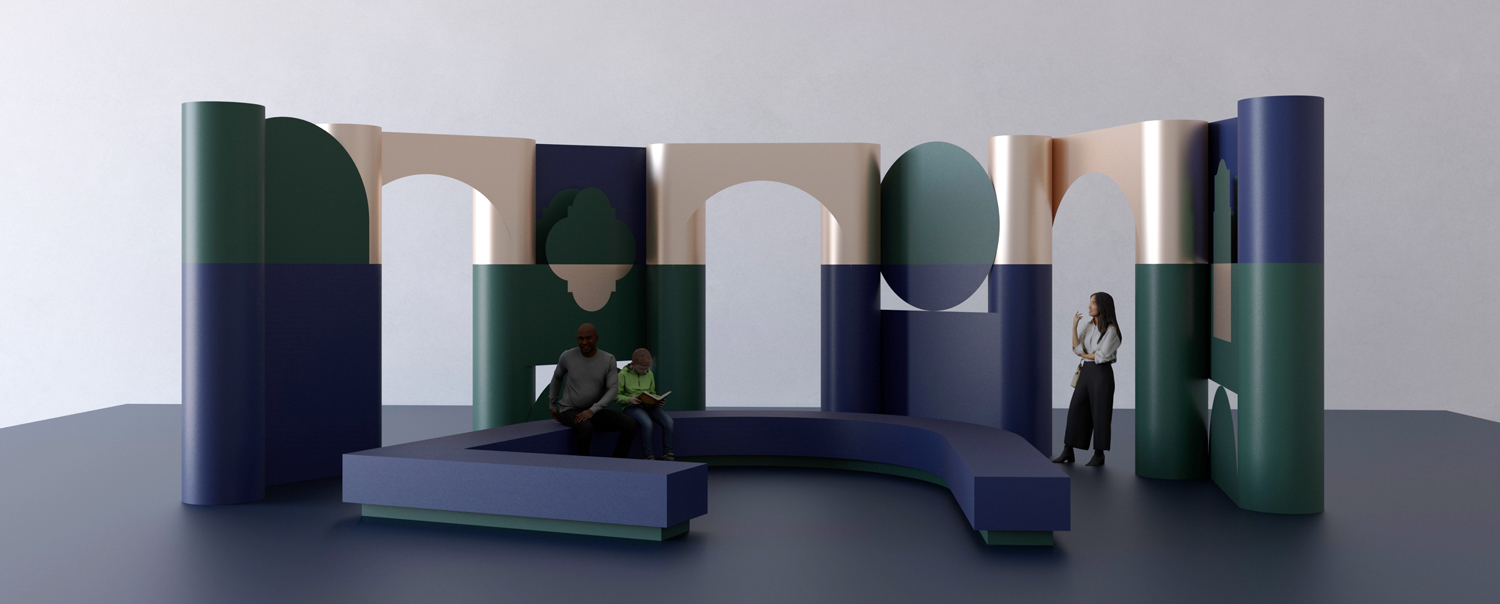
Canty’s installation translates this history into a contemporary spatial register. A sweeping arc, drawn from the theater’s façade and proscenium, organizes the plan. In elevation, three brass-edged, color-blocked arches open onto the central space, evoking the ornamental profiles and window figures of the demolished theater. The composition is structured by a consistent datum that links each module, establishing order while leaving room for open occupation. Regal Reverb is not a reconstruction but a reverb: an architectural echo of a vanished landmark.
Grace La (MArch ’95), professor and chair of the GSD’s Department of Architecture, and James Dallman (MArch ’92), co-principal of LA DALLMAN Architects, present SHIFTING REUSE AND REPAIR: the Door County Granary. The installation contemplates emerging strategies to reuse and repair derelict buildings—not only to prolong their useful life but to transform and extend their historical and civic meaning. Using the reclamation of an abandoned granary in Sturgeon Bay, Wisconsin, as a case study, LA DALLMAN demonstrates how strategic excisions and insertions within existing structures produce new modes of habitation. A comprehensive architectural model suspended within an occupiable fragment of a grain storage bin comprises the installation. LA DALLMAN’s exhibition team includes Elias Bennett (MArch ’25), Oonagh Davis (MArch ’23), Belle Verwaay Delatour (MArch ’18), Sigmund Seongyun Jeong, Min Ho Kim (MArch ’26), Brian Lee (MArch ’22), and Go Nakao (MArch ’28).
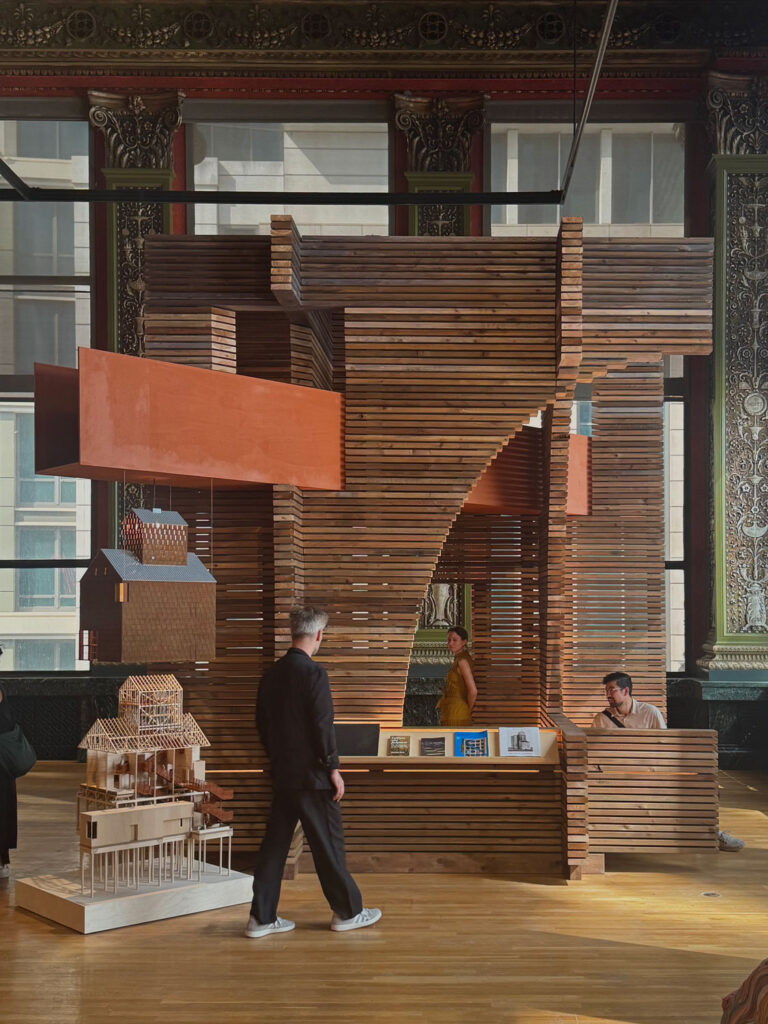
Iman Fayyad (MArch ’16), assistant professor of architecture, presents In The Round, part of a larger line of work that deals with the effects of standardization in building materials on architectural typology, addressing formal exploration as a function of material waste. This installation invites visitors to contemplate the spatial potentials of material transformations from thin, planar sheets to volumetric form. The space is composed exclusively of uncut 4-ft x 8-ft rectangular sheets of plywood bent into composite cylindrical forms. The radial assembly allows the membrane to operate as a compressive structure in both plan and section (similar to a dome), while the oculus opens the interior to its surroundings above. Seating elements around the interior and exterior serve as structural anchor points for people to rest and gather. The structure offers an intimate, collective inward-facing space as well as outward-facing individualized spaces that are simultaneously contemplative and exposed.
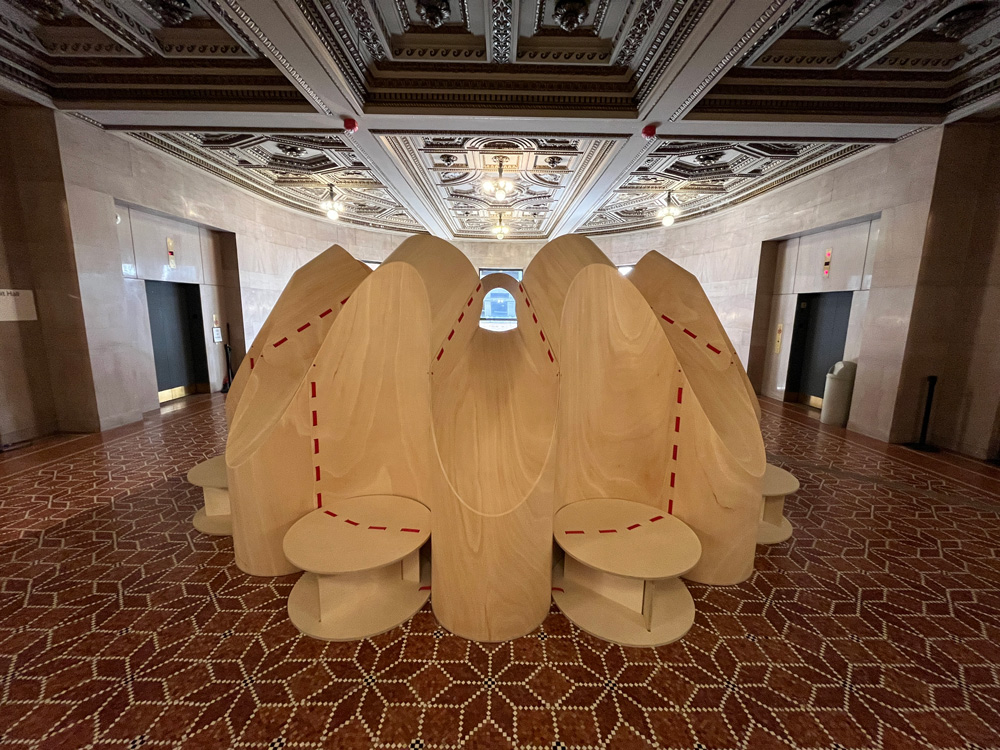
The capsule exhibition Inhabit Outhabit brings together over 30 housing projects from around the world that explore new solutions and challenge traditional models in response to contemporary needs. French 2D, led by assistant professor in practice of architecture Jenny French (MArch ’11) and Anda French, contributed material on Bay State Cohousing, a 30-unit community developed by its residents in Malden, Massachusetts. Each individual unit provides the amenities of a private home, while shared spaces and resources promote the creation of a vibrant, multigenerational community.
To mark the 10th anniversary of the CAB, Harvard Design Magazine and biennial leadership invited GSD design critics in architecture Lap Chi Kwong (MArch ’13) and Alison Von Glinow (MArch ’13) to imagine a new future for the Chicago Horizon, a temporary pavilion—by the architecture firm Ultramodern and structural engineer Brett Schneider—commissioned for the inaugural CAB that, despite original intentions, still exists. Kwong Von Glinow’s proposal, Forget-Me-Not, preserves the pavilion’s essential structural character while responding thoughtfully to its site, materiality, and context. Kwong Von Glinow consulted closely with the original team, modeling a collaborative approach to architectural practice that considers a building’s evolution from conception through execution and beyond.
With Living Histories: Space for Reckoning, Mónica Ponce de León (MAUD ’91) of MPdL Studio, Mark Lamster (LF ’17 ), and STOSS Landscape Urbanism—founded by Chris Reed, GSD professor in practice of landscape architecture and co-director of the Master in Landscape Architecture in Urban Design program—propose a new way of approaching commemorative space. Their installation addresses questions of how public space might tell the complex and interconnected histories that shape culture and inform who we are vis-à-vis a proposal for memorializing political and racial violence at Dealey Plaza and Martyr’s Park in Dallas, Texas.
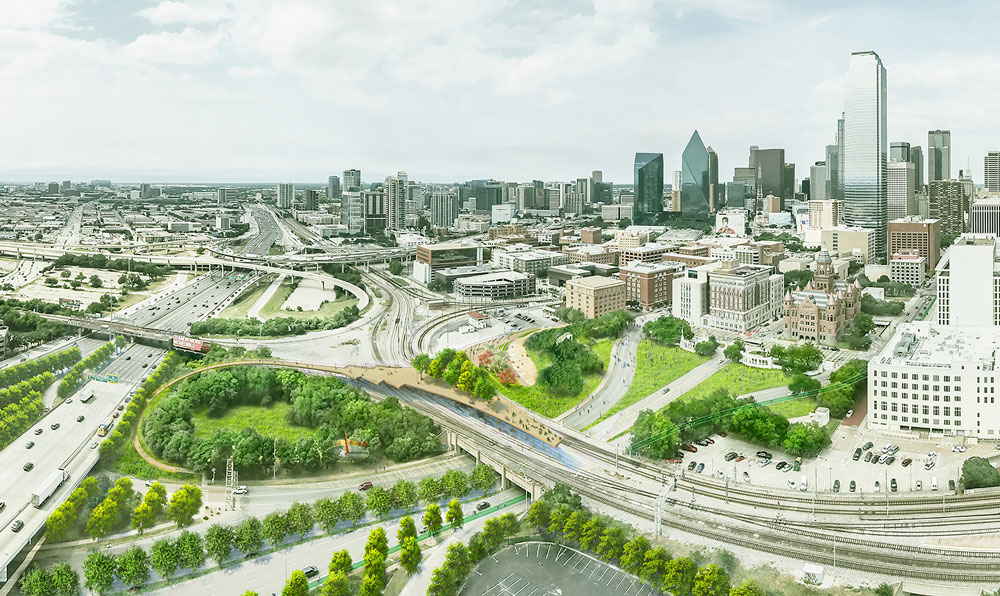
ALUMNI (in alphabetical order)

RADDAR, led by Sol Camacho (MAUD ’08), presents the glass pavilion Our Second Skin. More than 2,200 glass pieces comprise the pavilion, forming a translucent skin that simultaneously evokes the omnipresence of glass facades in contemporary cities and the invisible materiality of the industrial process that produces them. Inside the pavilion, an audiovisual essay presents excerpts from several interviews Camacho conducted with 23 leading international architects, engineers, and artists whose expertise spans design, research, construction, and technology. These individuals reflect on our contemporary indiscriminate use of glass, highlight its unparalleled and enigmatic qualities in architecture, and propose ideas for the material’s future.

Abigail Chang (M Arch ’16) presents Liquid Glass for the CAB exhibition Melting Solids, located at the Stony Island Arts Bank. Liquid Glass examines a larger question about the boundary between our interior and exterior worlds. The work reflects on water as a resource whose invisible presence in air and vapor has the potential to materialize as condensation on windows. The installation, composed of hanging resin objects with various lenses, asks visitors to reflect on the fragility in our ever-changing surroundings as they move between and peer into opaque windows that seemingly stream, drip, and puddle.
Ignacio G. Galán (MArch ’10) with David Gissen and Architensions (Nick Roseboro, Alessandro Orsini) offer Fragments of Disability Fictions. Presented as a discontinuous description of a fictional disability world mixing different scales and times, Fragments of Disability Fictions highlights how disability and impairment offer alternatives to conventional representations of the past and future. The installation’s fragmentary character also disrupts the connection between the crafting of physical models and the pursuit of totalizing forms of control that produce “model” (i.e., “ideal”), streamlined worlds. The latter are often ableist (if not eugenic) representations of life. Unlike many visions of urban health and well-being, the architectural and urban histories we explore include messier, more complex, and more inclusive embodiments, materialities, cultures, socialities, technologies, and ecologies. Developed with the guidance of a group of disabled scholars, activists, and policymakers, such histories conceptualize physical and emotional well-being in complementary, contrasting, and even contradictory ways.

Fragments of Disability Fictions includes contributions by Neta Alexander, Victor Calise, David Serlin, and Eman Rimawi. The exhibition team includes Sharona Cramer and Yotam Oron, Thomas Gomez Ospina, Lauren Jian, Norman Keyes, Yuna Li, Lajja Mehta, Natalia Molina Delgado, Nur Nuri, Aistyara Charmita Shaning, Sherry Aine Chuang Te. Voice is provided by Sophie Schulman; ASL interpreting is provided by All Hands in Motion / Diana Abayeva (DI on screen) and Maria Cardoza (HI).
SHIFT’s curatorial team includes co-curators Chana Haouzi (MArch ’14) and Igo Kommers Wender and artistic director Florencia Rodriguez (LF ’13).
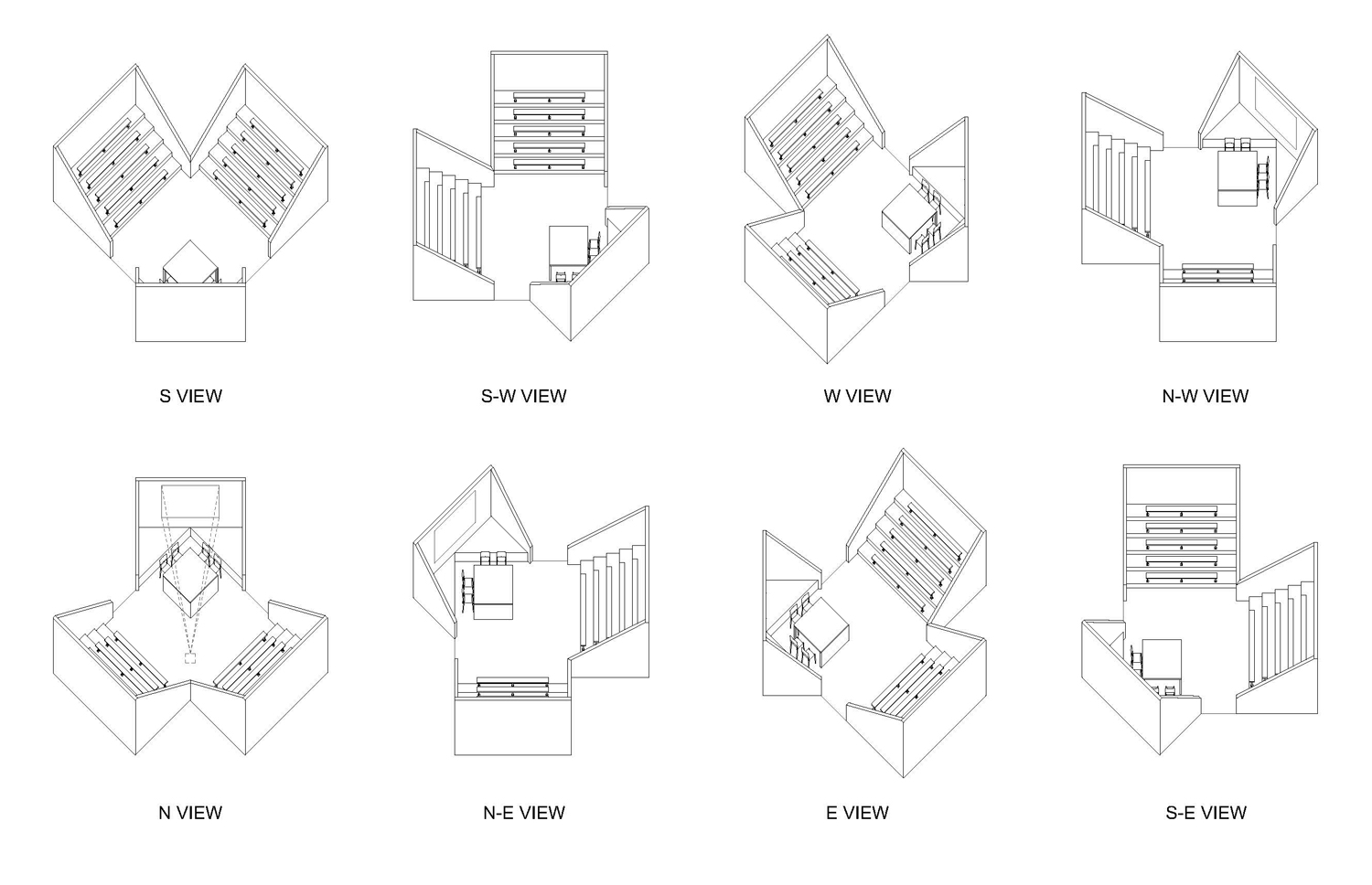
Johnston Marklee, led by Sharon Johnston (MArch ’95) and Mark Lee (MArch ’95), presents Speaker Corners. Located on the second floor of 840 N. Michigan Avenue, this project takes the form of a grandstand with seating for more than 50 people. This small arena will host talks, panels, and other public events during the full run of the CAB. Speaker Corners was conceived as part of a series of spaces that promote discussions, presentations, and exchange, which began with Speakers’ Corner—an installation by Christopher Hawthorne, Florencia Rodriguez, and Johnston Marklee—one of the featured curator’s special projects at the 19th International Architecture Exhibition of La Biennale di Venezia 2025.
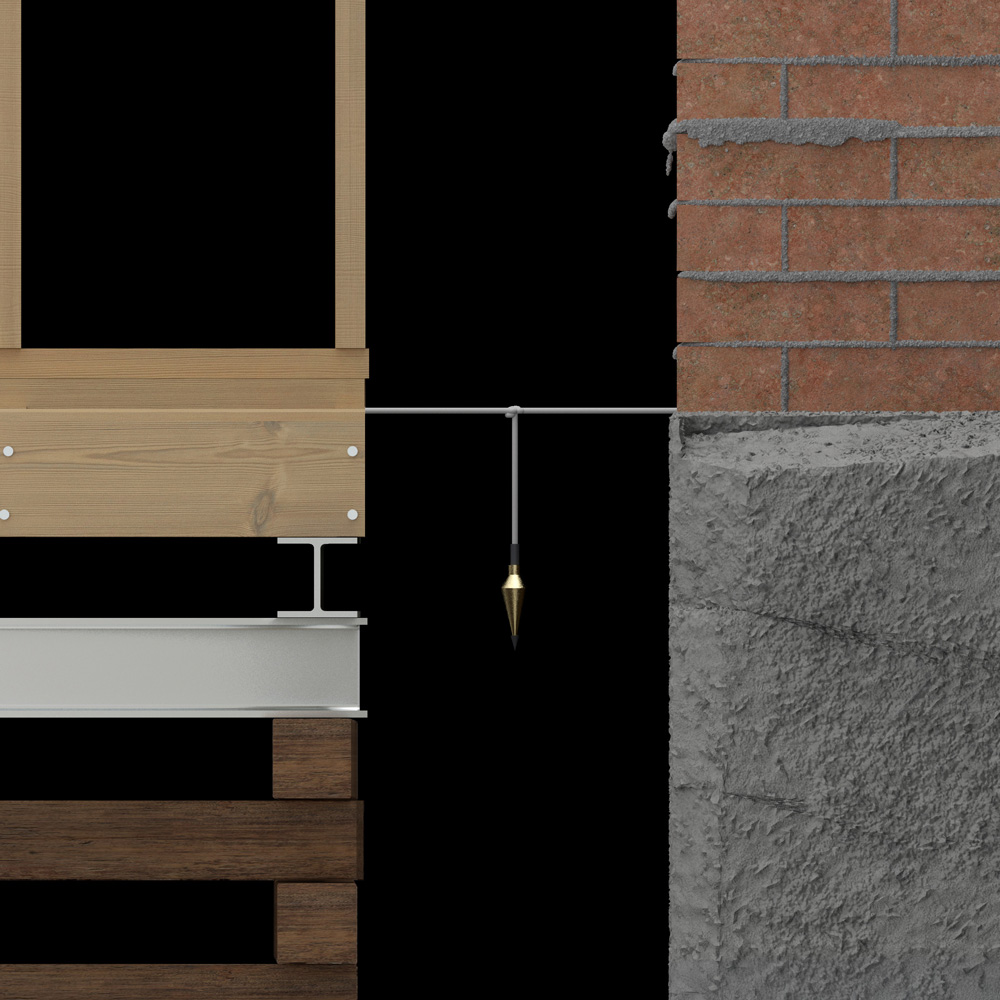
Two Foundations, presented by Alex Yueyan Li (MArch ’21) and Mahsa Malek of 11X17, examines the dichotomy of stability/instability through two everyday construction practices—house lifting and underpinning—that accept instability as a perpetual architectural condition. The installation reconstructs these techniques through a series of technical objects; cribbing stacks, shoring posts, plumb bobs, and formwork are arranged as a structural diagram, enacting the physical operations they are designed to perform. Taken together, they reveal the mechanisms that allow an existing structure to pause, frame, and accommodate acts of repair. In doing so, the installation foregrounds instability as a fundamental aspect of architecture’s life, despite the persistent quest to create stable, unchanging buildings. Aging is a material fact that requires continuous care, and architecture will only endure through ongoing acts of adjustment and maintenance that sustain it over time.

Michael Maltzan (MArch ’88) of Michael Maltzan Architects has contributed materials on 26 Point 2 Apartments to the Inhabit Outhabit exhibition. Completed in 2023 in Long Beach, California, 26 Point 2 Apartments is a five-story permanent supportive housing apartment building that bridges a busy commercial zone and a residential neighborhood, providing 77 units plus amenities, staff, and supportive services that address the needs of chronically unhoused people.
To Inhabit Outhabit MASS Design Group has contributed materials on their Maternity Waiting Village in Kasungu, Malawi. Completed in 2015, this complex offers a housing model for expectant mothers. Alan Ricks (MArch ‘10), Michael Murphy (MArch ’11), and Matt Swaidon (MArch ’12) took part in the design of this project.
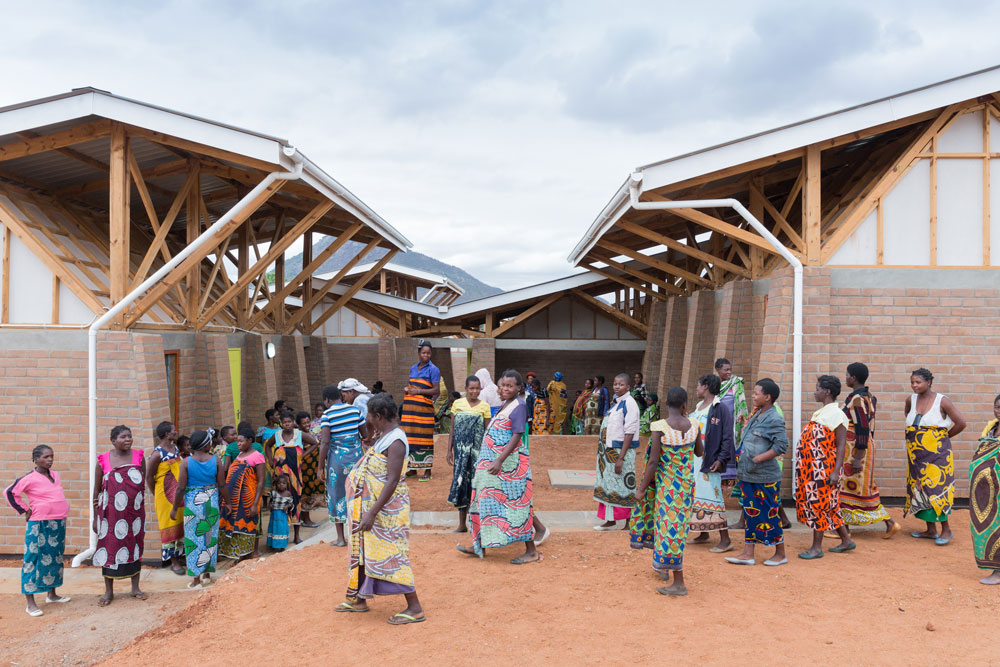
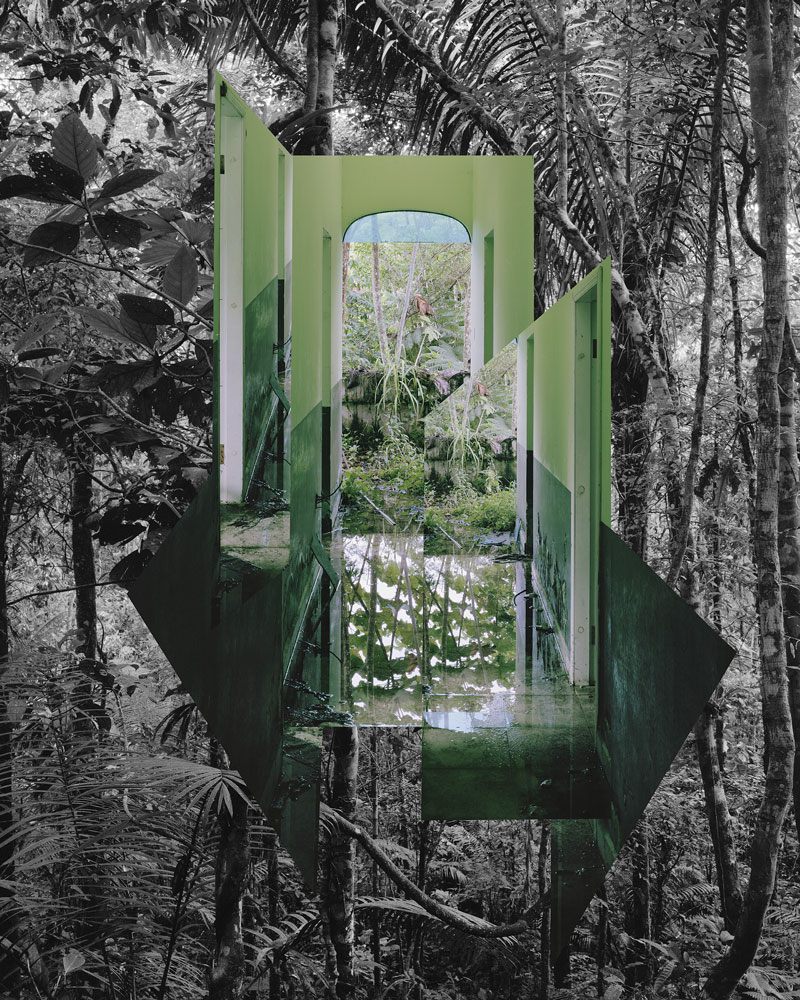
Susannah Sayler (LF ’09) and Edward Morris (LF ’09) of Sayler/Morris present The Crystal Forest, a body of linked works (photography, collage, a short film, animation) that meditates on the Amazon as a mosaic of symbolic meanings and a place where humans and other beings dwell. The work circles around the remains of a building the artists encountered on the edge of the jungle that inspired the title. The Escuela Superior Politécnica Ecológica Amazónica in Tena, Ecuador, was part of an ambitious 1997 endeavor to create a network of universities across the Amazon that would educate indigenous people and other citizens in subjects like business management and computer science. The “modernization” enterprise failed almost immediately, the jungle quickly overgrowing and re-absorbing its remnants, authoring its own architecture of entropy. The title The Crystal Forest also references the Crystal Palace built in London (1851) to house the Great Exhibition of the Works of Industry of All Nations, which has been cited as an epochal moment in the development of integrated world capitalism. In this sense, The Crystal Forest is the inverse or shadow of the Crystal Palace.
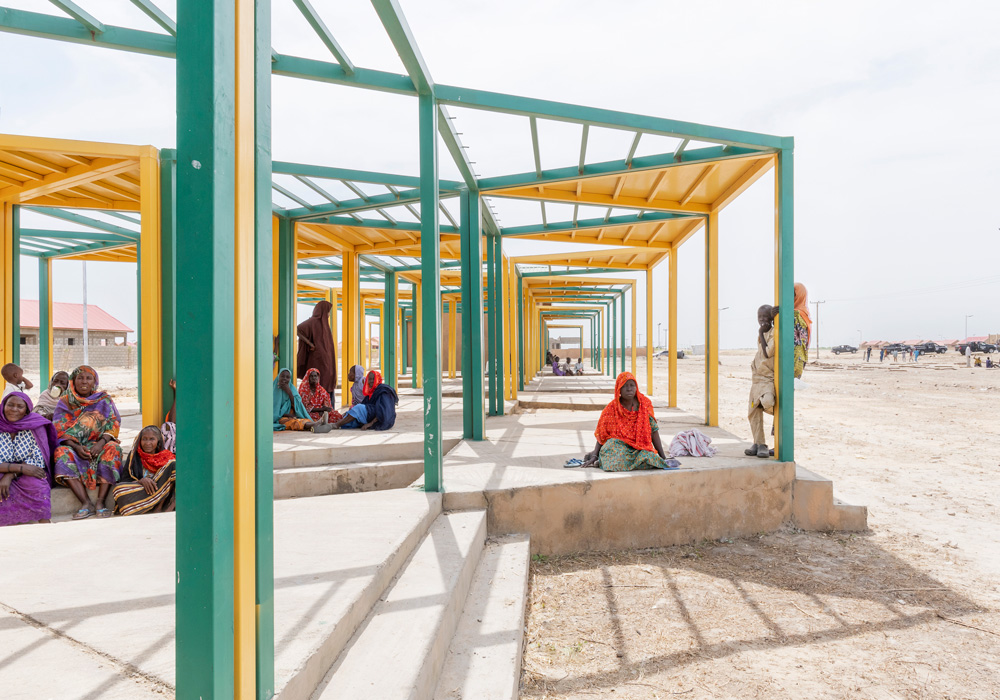
As part of the Inhabit Outhabit exhibition, Tosin Oshinowo (LF ’25) of Oshinowo Studio presents the film Nagarannam: Home Coming, which shares the story of a community displaced by the insurgency group Boko Haram operating in Nigeria, Chad, Niger, Cameroon, and Mali. In addition, to the capsule exhibition Ecologies, opening November 6, Oshinowo has contributed Alternative Urbanism, a continuation of her research exhibit from the 19th Venice Architecture Biennale that explores specialized markets in Nigeria. These markets operate as factories processing “waste” or “end-of-life” items from industrialized economies and showcase the principle of circularity prevalent in African cities through the ingeniousness of iterative self-organizing initiatives. Often foreign to their host environments and not structured by the state, these markets coexist with and may re-appropriate the urban fabric, speaking to the realities that enable the African city to function in modernity.

The Embellished, the Transient, and the Critical, presented by Alejandro Saldarriaga Rubio (MArch ’23) of alsar-atelier, explores an architecture of post-pandemic magical realism within the context of temporary exhibits. The installation uses quotidian plastic pallets as a primary compositional element and speculates on the spatial possibilities behind a single vertical partition built from this ordinary object, critically addressing the economic and environmental implications of experimental ephemeral design. By embracing “off-the-shelfness” and “dryness” as structural principles, the installation embellishes the ordinary, accepts its own impermanence, and challenges norms through critical material choices.
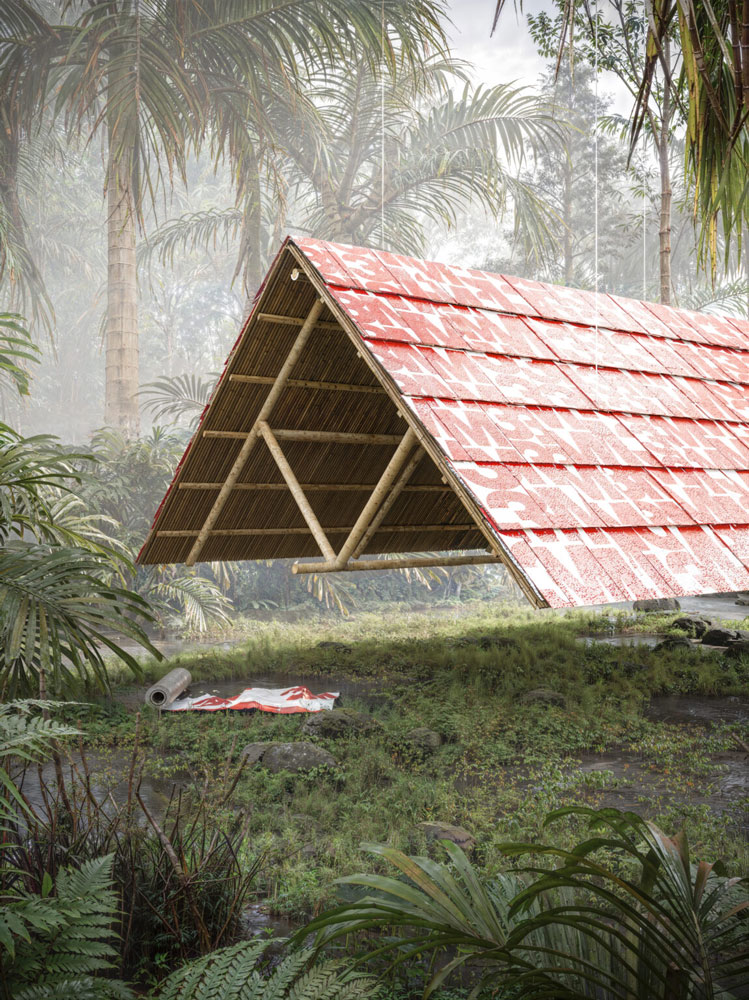
Oscar Zamora (MArch ’23) in collaboration with Michael Koliner worked on AIR VAPOR BARRIER, a piece that juxtaposes vernacular archetypes with Western envelope technologies by reinterpreting the tropical roof through mass-produced air-and-vapor-barrier (AVB) shingles. This material transposition critiques the persistent framing of the tropical as primitive while exposing the entanglement of indigenous practices and imported standards. The project demonstrates how industrial materials gain new significance when recontextualized through local construction logics. Positioned beyond nostalgia or technical determinism, it proposes a “third space” of contradiction, improvisation, and critique, reclaiming the tropical roof as a site of cultural negotiation and architectural imagination.
How GSD Students Design For Wildfire Prevention
Five months after California wildfires killed 29 people and devastated neighborhoods in Los Angeles and surrounding areas, three Graduate School of Design students interned at the Southern California offices of landscape architecture and urban design firm SWA , to learn how to leverage design for fire prevention and remediation. Facundo Soraire (MUP ’26), Enrique Lozano (MAUD ’26), and Eleanor Davol (MLA ’27) spent six weeks learning about complex issues around fire risk, prevention, and remediation, and generated proposals for parcels that sit at the Wildland Urban Interface (WUI) , where human communities meet undeveloped land and fire risks run high. This was the most recent of many collaborations between the firm and members of the GSD.

This summer’s program built on research undertaken by Jonah Susskind (MLA ’17), SWA director of climate and sustainability. Over the last decade, he’s conducted extensive research and taught a series of summer programs at SWA on the connections between climate change and fire risk, and how people and communities can best prepare, resulting in his book, Playbook for the Pyrocene , winner of a 2025 American Society of Landscape Architects (ASLA) merit award in communications. Susskind writes that large segments of the population are moving to city outskirts. While residents once appreciated the suburbs for their access to nature and recreation, now, what draws them is the more affordable housing available further from the city due to “NIMBYism and local zoning restrictions.”

Thus, more and more people are seeking out homes in the WUI, which, because of the dire need for affordable housing, is growing by about 2 million acres per year
. Almost 100 million people in the US, Susskind notes, live in the WUI. This zone is especially vulnerable to wildfires as it’s often populated by “woodpiles, propane tanks, trees and shrubs, roof and gutter and deck debris,”[i]
as well as housing materials that may be especially vulnerable to fire. Susskind writes that, “[d]uring the past three decades, more than 80% of California’s fire-related structure loss has occurred in these high-risk zones.” Millions of people are likely experience the losses inflicted by ever more powerful wildfires.
Planners must “balance affordable housing with environmental conservation,” explains Susskind, especially because “the minute you get into the WUI, you also come up against entrenched histories of environmental conservation.” Susskind argues that suburban land use planning hasn’t changed much since the 1930s, and we need a new “suburban design ethos” that would allow for those communities to be “better resourced” in the face of fire risks and other climate change impacts.
“This is a design and planning challenge as much as it is a policy and economic challenge as much as it is a social and equity challenge,” he noted.
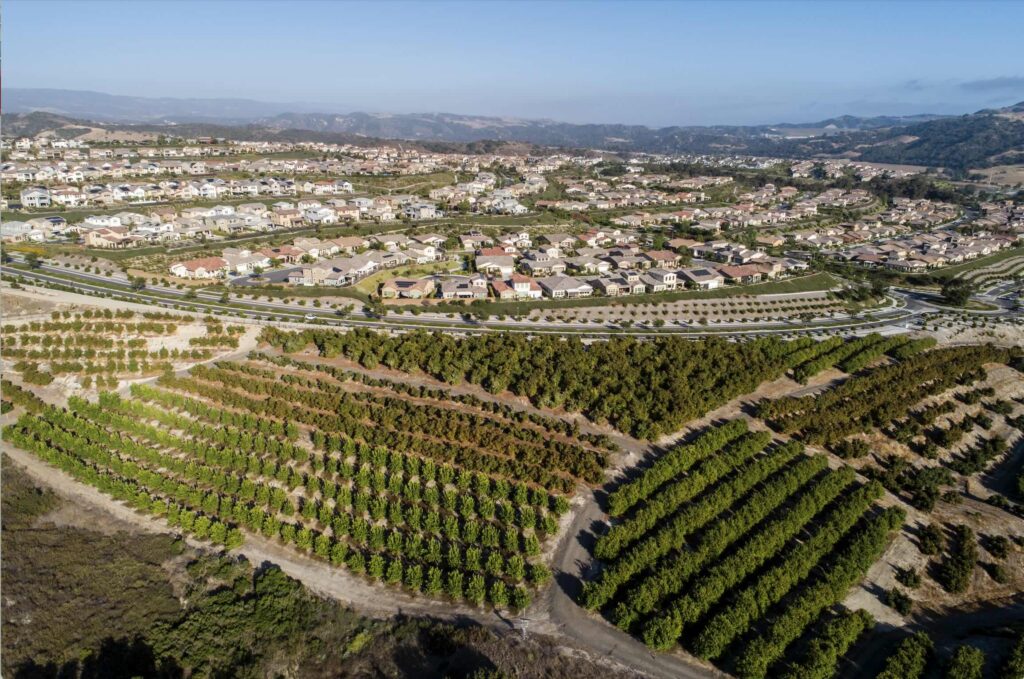
Each of the students in this summer’s cohort focused on a different aspect of wildfire prevention and remediation. Soraire, for example, envisioned a Community Land Trust (CLT) that would be led by the Santa Ynez Chumash tribe NGO, the local Indigenous nation, in support of co-governance and land stewardship that centers on the nation’s ancestral knowledge, including fire management techniques. The project includes affordable housing for the community.

Soraire took inspiration from his home province in Argentina, Jujuy, which borders Bolivia, Chile, and Argentina, and is known as the “lithium triangle,” a mining territory. He investigated questions around land use, extraction, and the role of Indigenous voices in shaping land use. He started by mapping pre-colonial histories around Santa Barbara. Because several communities live in the region, “governance fragmentation and jurisdictional boundaries exacerbate fire risk.” His proposal, therefore, creates a central infrastructure for the many agencies already working in partnership with the Chumash, to share ideas and resources and center the nation’s presence and leadership on the land.

Davol took a different approach, studying soil composition to think about post-fire resiliency for humans and non-humans. In a mega-fire, she explained, the soil’s composition changes, often leaving it impermeable to rainfall. Later, instead of sinking into the soil, rain slides over the slick surface and causes floods and mudslides, further threatening the ecosystem and people’s homes and communities.
“The health of the earth and soil, and its ability to recharge and become permeable again,” she explained, “is really important for the long-term success of these landscapes.”
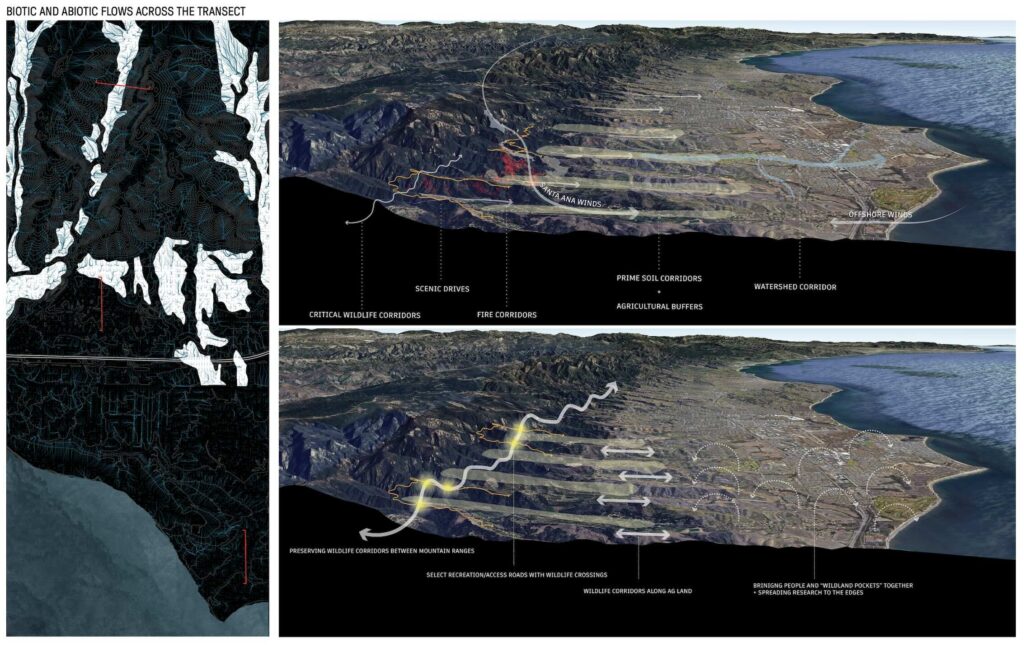
Davol mapped the soil and created corridors both to prevent fire and rehabilitate the earth, for example, with chapparal plantings. The corridors also give species in the region, such as the mountain lion, safe access across human infrastructure in the WUI. “I thought about this region as a “patchwork of green spaces that could be connected for people and wildlife.” As we “expand into the wildlands, we’re often bisecting and covering up and burying natural systems like rivers.” Her project addresses biodiversity loss and interactions between humans and nonhumans.
Finally, Enrique Lozano framed the WUI “not as a liability, but as a multiplier—a design tool that catalyzes infill development while preserving critical open space.” Instead of looking at the WUI as a “zone of vulnerability,” he saw it as an opportunity, using Transfer of Development Rights (TDR) from a nearby golf course to a 327 acre plot called Giorgi Farm. In the process, his proposal would increase affordable housing and restore resident access to Ygnacia Creek while also “enhancing biodiversity, using landscape as a fire buffer, promoting the wildfire corridor, and minimizing greenfield development.”
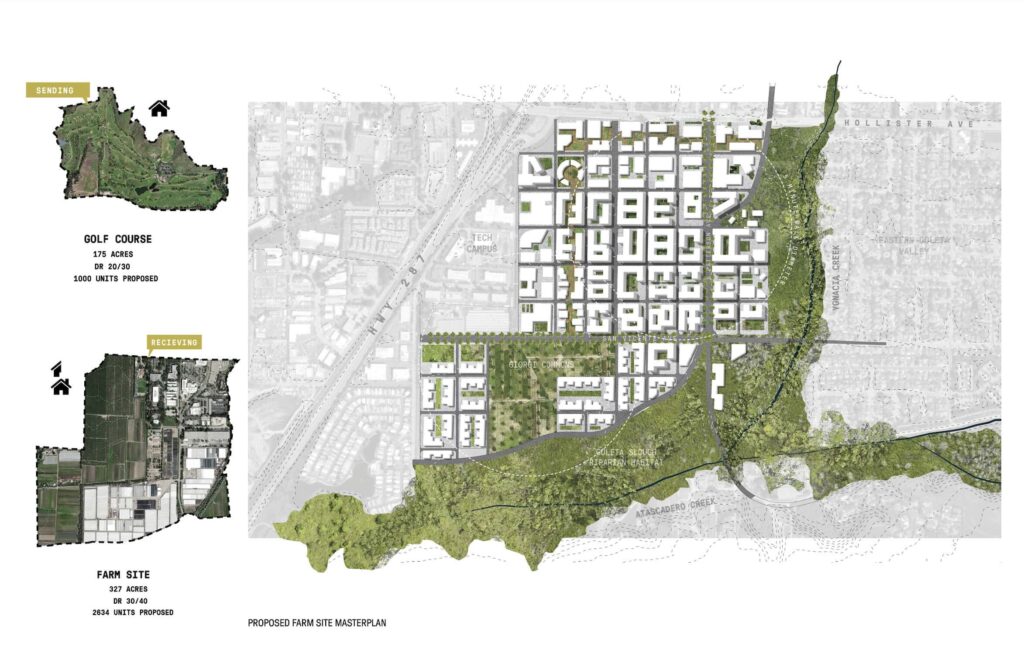
He started by mapping the residents who are most vulnerable to fire risk, and found that it’s the people “pushed out of the urban core, to the peripheries.” In addition, he found that many of the Housing Element updates in the city, which mark new housing units, fell within the WUI. Applying lessons he learned in the MAUD program and a recent Architecture and Real Estate course collaborative, he looked at the site from different scales, studying the territory at large, and using TDR’s to build affordable housing within the city while also increasing biodiversity and usable green spaces.

The complexity of wildfire prevention and remediation that Soraire, Davol, and Lozano address in their projects is why Susskind believes it’s so critical to establish bridges between firms like SWA and academic programs like the GSD. SWA has a long legacy of GSD collaborations, beginning with its founding in the 1950s by GSD professor Hideo Sasaki and his student, Pete Walker (MLA ’57), both of whom went on to prodigious careers. Today, Susskind regularly guest lectures at the GSD in the “Climate by Design” course, and the SWA summer cohorts often include GSD students. For example, in 2022, Slide Kelly (MLA & MDes ’24) worked on fire remediation with Susskind at SWA, and now serves as a design critic in landscape architecture at the GSD.
The GSD has long served as a site of experimentation where designers can explore issues around wildfire management and remediation, with increasing attention in recent years as climate change causes more frequent megafires. In recent years, three professors at the GSD taught classes on wildfires, and this fall, two option studios focus on fires: a new iteration of Silvia Benedito’s option studio, “Canary in the Mine,” co-taught with Kelly, takes students to the Jack Dangermond Nature Preserve in Santa Barbara County as part of their study of the aftermath of the January Los Angeles wildfires. James Lord and Roderick Wylie’s studio “Fireworks,” focuses on the Napa Valley in California, using the di Rosa Center for Contemporary Art to inspire thinking around how art and landscape might, together, create a “speculative vision for the future hand in hand with design.”
These courses, along with the work that GSD students undertook in partnership with SWA this summer, mark significant opportunities for designers to intervene in the climate crisis, alleviating its impacts for humans and nonhumans alike. SWA encouraged students in the summer program to first consider “ecological systems before development,” explained Lozano. He thought first about restorative landscapes and fire buffers, and how to maximize affordable housing and resident mobility and open space, in two sites across the city.
“I wanted to show that, even though the urban core is very dense and active, and then, moving outward, there’s suburbia and then the woodlands—all of these seemingly disparate things are interdependent.” Fire mitigation requires looking at the city and suburbs as a unified system.
[i]
Katherine M. Wilkin, David Benterou, Amanda M. Stasiewicz, “High fire hazard Wildland Urban Interface (WUI) residences in California lack voluntary and mandated wildfire risk mitigation compliance in Home Ignition Zones,” International Journal of Disaster Risk Reduction, Volume 124, 2025, 105435, ISSN 2212-4209, https://doi.org/10.1016/j.ijdrr.2025.105435
.
How a Collaboration Between Design and Real Estate Advances Equity in Mumbai
Students in Rahul Mehrotra’s “Extreme Urbanism Mumbai” Graduate School of Design (GSD) Spring 2025 option studio faced a challenge that was intended to take them “completely outside their comfort level,” said Mehrotra. “We set a wicked problem that exposes them to an unfolding of interconnected issues.”
Mumbai, set on a peninsula on the northwest coast of India, is one of the largest and densest cities in the world, with a population of about 21.3 million residents and more than 36,200 people per square kilometer—most of whom face a stark housing crisis. Approximately 57 percent of Mumbai’s population lives in informal homes, many of whom work in nearby housing complexes where they’re employed by the upper-class residents. Most of the students in the studio had never been exposed to what Mehrotra describes as “extreme conditions, in terms of density, poverty, and the juxtaposition of different worlds in the same space.”

“Mumbai is like nothing I’d ever seen before,” said Enrique Lozano (MAUD ’26), who had previously traveled to other parts of India. “There’s no designed urban form; skyscrapers are scattered throughout the city. It’s on a former wetland, so there are issues with water, one of my research areas.”
He and his classmates were introduced to Mumbai’s coastal Elphinstone Estate neighborhood and a site owned by the Port Authoritiy of Mumbai that includes 40 acres of warehouses as well as iron and steel shipping offices, bounded on one side by a rail line and on the other by the harbor and P D’Mello Road, a major city street. “The Eastern Waterfront will be one of the city’s most contested land parcels to be opened for urban development in the next few years,” writes Mehrotra. “It plays a catalytic role in connecting the city back to the metropolitan hinterland….” The 900 or so people who work in this area and live in sidewalk tenements stand to be displaced once development progresses.
Elphinstone Estate — the site of the studio
Students were tasked with working at three scales: regional, district (the “superblock”), and site (urban development policy). Rather than displacing workers whose lives are strongly rooted in the neighborhood, students were asked to invent schemes that would newly house those 900 families in tenements by “cross-subsidizing from market-value housing.” The studio offered a counterpoint to the government’s designation of the site as a commercial district. Students’ proposals served what Mehrotra terms in reference to his research, “instruments of advocacy,” creating a way to keep the city’s most vulnerable residents where they have always lived, while also offering needed market-value homes.
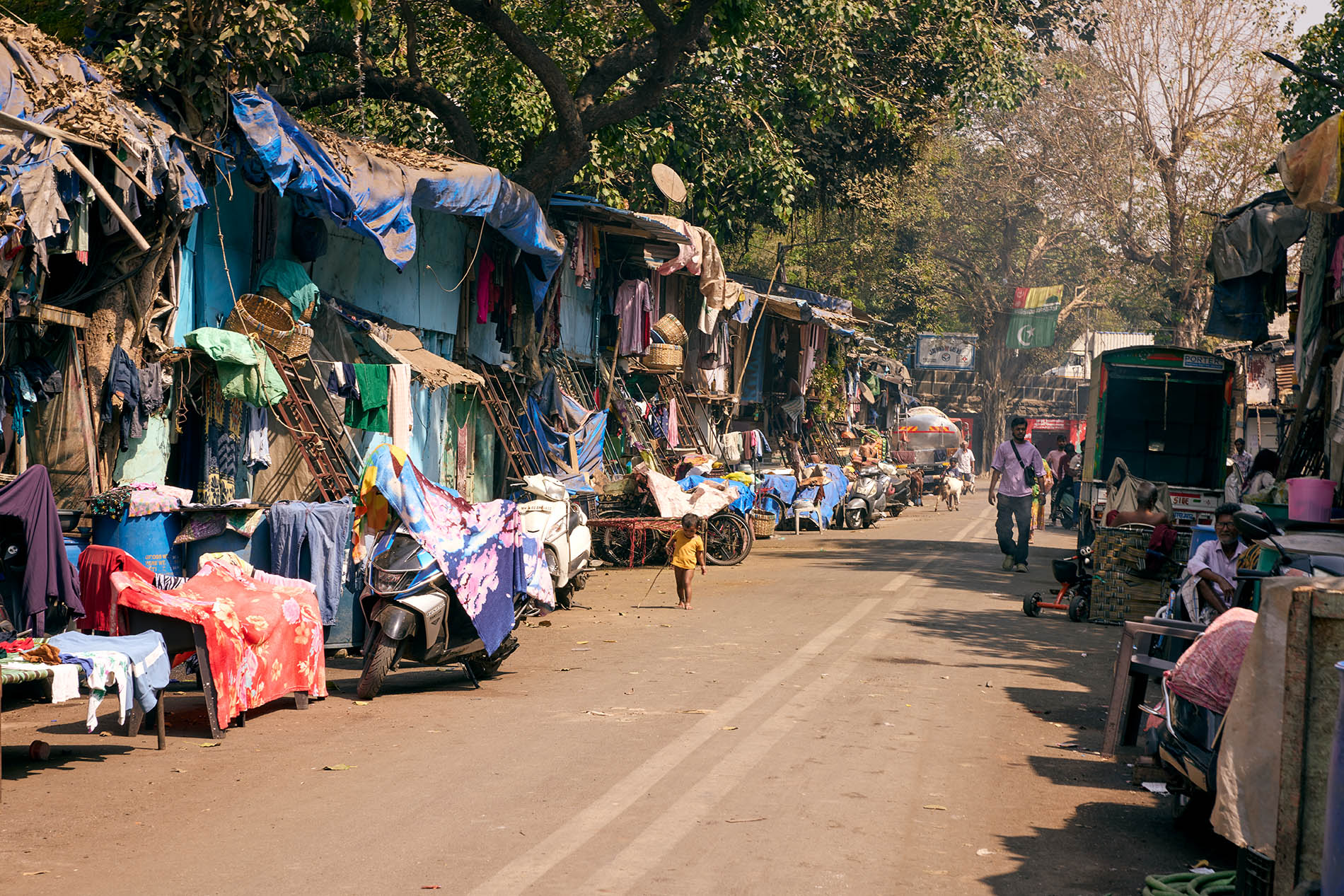
This studio differs from many others at the GSD, in that it involves collaboration between the studio and a Master in Real Estate course titled “The Development Project.” Jerold Kayden, Frank Backus Williams Professor of Urban Planning and Design and founding director of the Master in Real Estate Program, and Mehrotra brainstormed about the idea of such a collaboration and launched the idea in spring 2024. David Hamilton, a real estate faculty member at the GSD, co-instructed this year’s version in the spring 2025 semester.
“I think of real estate as the physical vessel in which people live, work, and play,” Kayden explained. “And if we can apply our multidisciplinary skills and knowledge to shape real estate in ways that create a more productive, sustainable, equitable, and pleasing world, then I can’t think of a more noble cause than that.”

The magic of the combined studio and real estate class, as Kayden, Mehrotra, and Hamilton saw it, was that students from the two programs would be interdependent and could only solve the on-site housing challenges by working together. “The real estate students couldn’t own the problem because the designers didn’t design it in a way that would work in terms of real estate sense,” said Mehrotra. “And the designers couldn’t think of the design unless the real estate folks came up with a model of financing for that cross-subsidy.”

Hamilton concurred that the studio set up a collaborative tension that replicated real-world challenges: “We can imagine a path that gets us from having bright ideas and a beautiful piece of land, to a proposed future that’s both appealing and realistic enough to attract investment capital to be built. Then, we get to what we call stabilization, where the new neighborhood is working physically and financially in a sustainable way. Getting there involves a million different variables, from government action and public subsidies, to the needs of the market and investors and other financial considerations.”
Lozano saw the benefits of designing in Mumbai, where “the street is an even playing ground. Everybody takes the metro, walks the Plaza, buys street food in the markets.” At the same time, like most collaborators, his group had their share of challenges as they moved through the design process. “The entire studio was a negotiation between the students—of judging our values and understanding that the real estate students want to make a return on investment, but the subversion is the social mission, and the designers had to convince them that social space is an asset.”
He described a beautiful 19th-century clock tower on the Elphinstone site, which one of his real estate group members wanted to demolish, and how they negotiated the “iterative design process” and “pushed against the blank slate idea.” They kept the clock tower, which they saw as a cultural asset, and “turned it into an incredible public amenity with restrooms, civic spaces, and movie screenings. It’s an anchor and memory of the site itself, with the maritime history and labor organizing that occurred there.” Through the collaborative process, building trust by drawing and talking through their design plans, the design students developed a final project of which they’re proud.
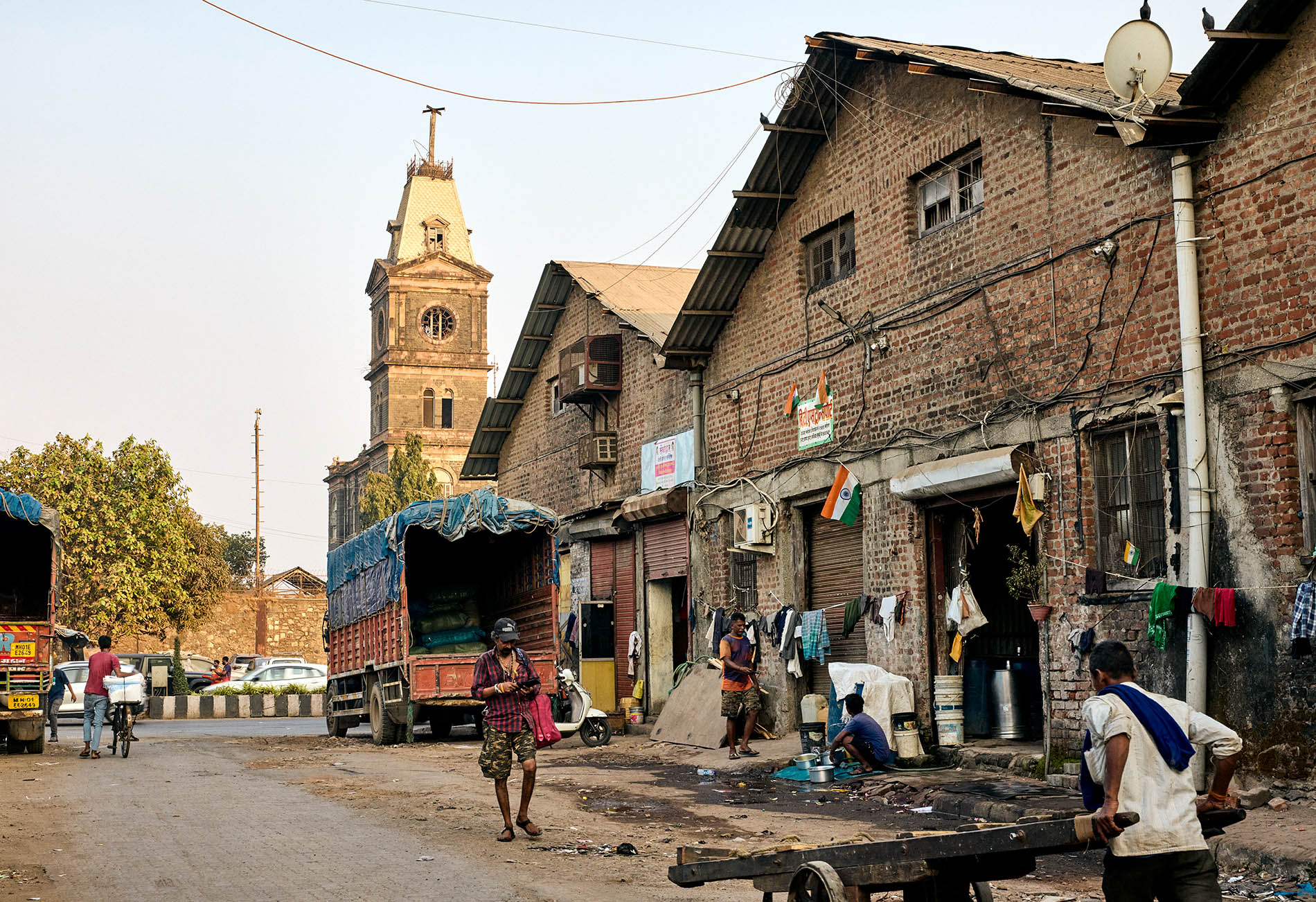
“As we become surrounded by the madness and complexities of the world we inhabit,” said Mehrotra, “it’s important to have multiple perspectives on the same problem, and to synthesize those multiple perspectives into a proposition.”
The final review mirrored the lively discourse the students experienced all semester, as critics discussed the merits of each proposal and the possibilities for the Elphinstone Estate. Sujata Saunik, Chief Secretary of the Government of Maharashtra, participated throughout the final review and helped bring to the conversation a sense of Mumbai’s realities. As the student groups together advocated for shared public access to the site and investing in dignified housing for people living in tenements, they presented to the government a more equitable approach to developing a site that’s unique as well as profitable.
“It’s not the solution,” said Mehrotra, “but it’s a conversation changer.”
Student Propositions

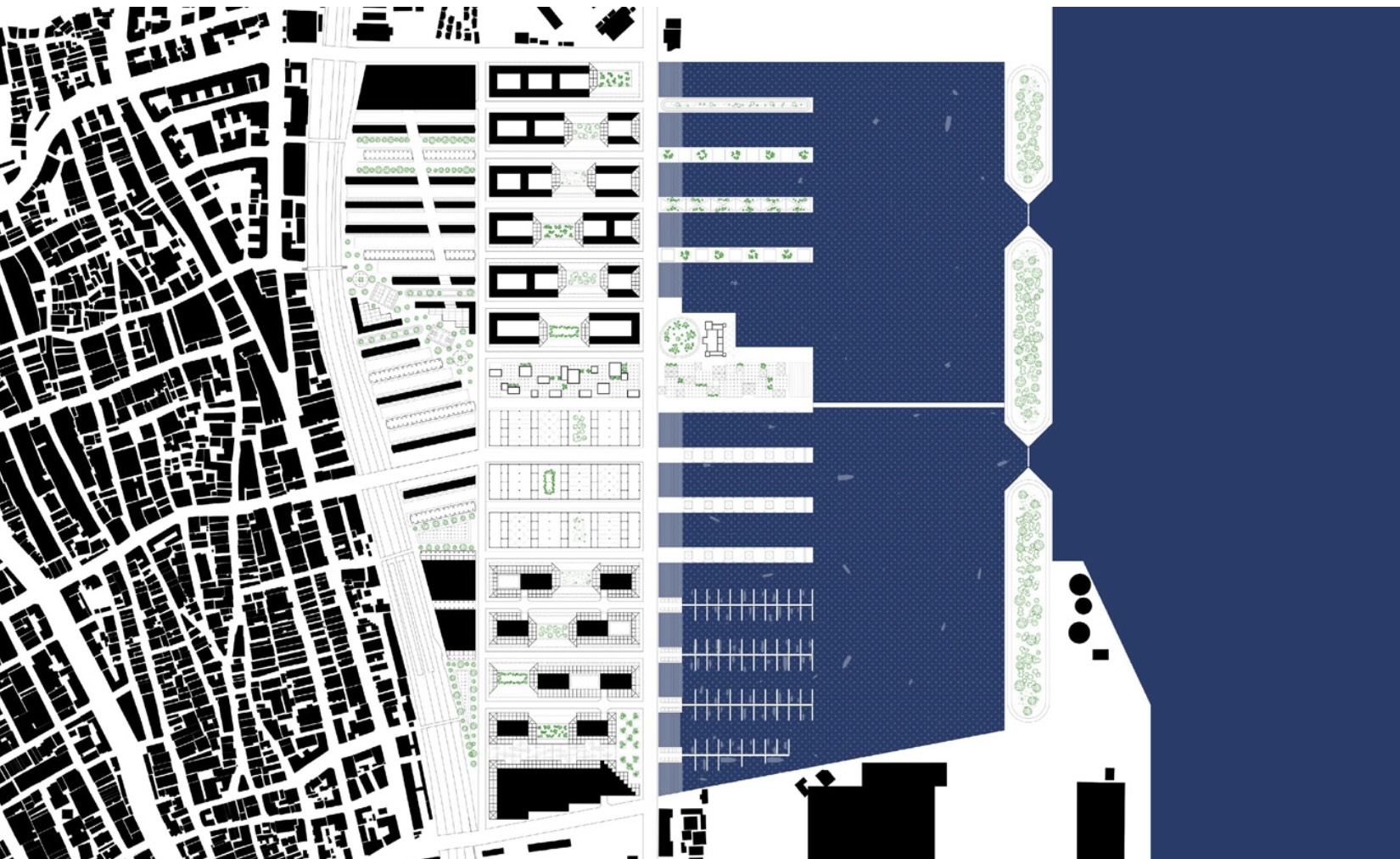
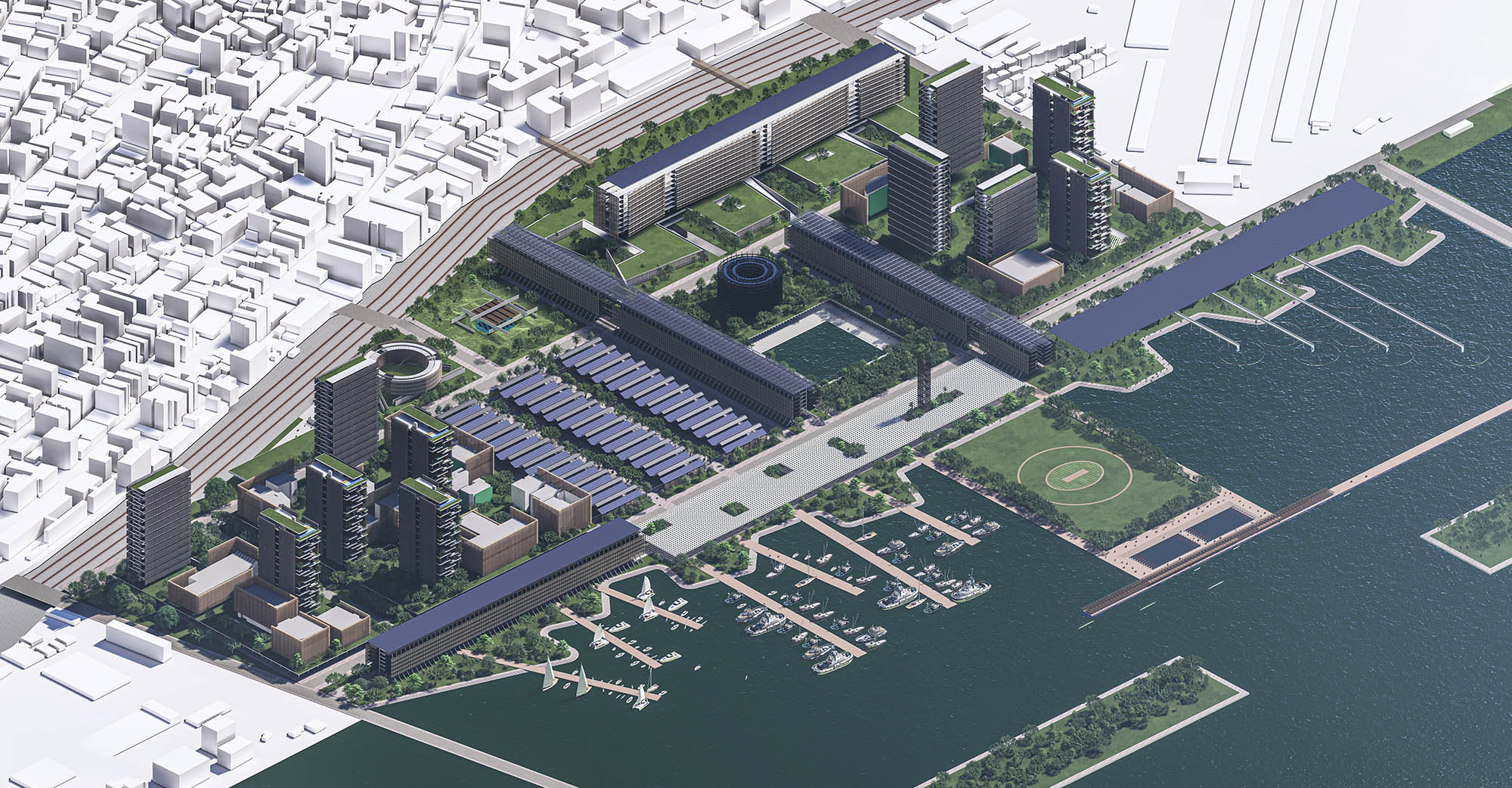
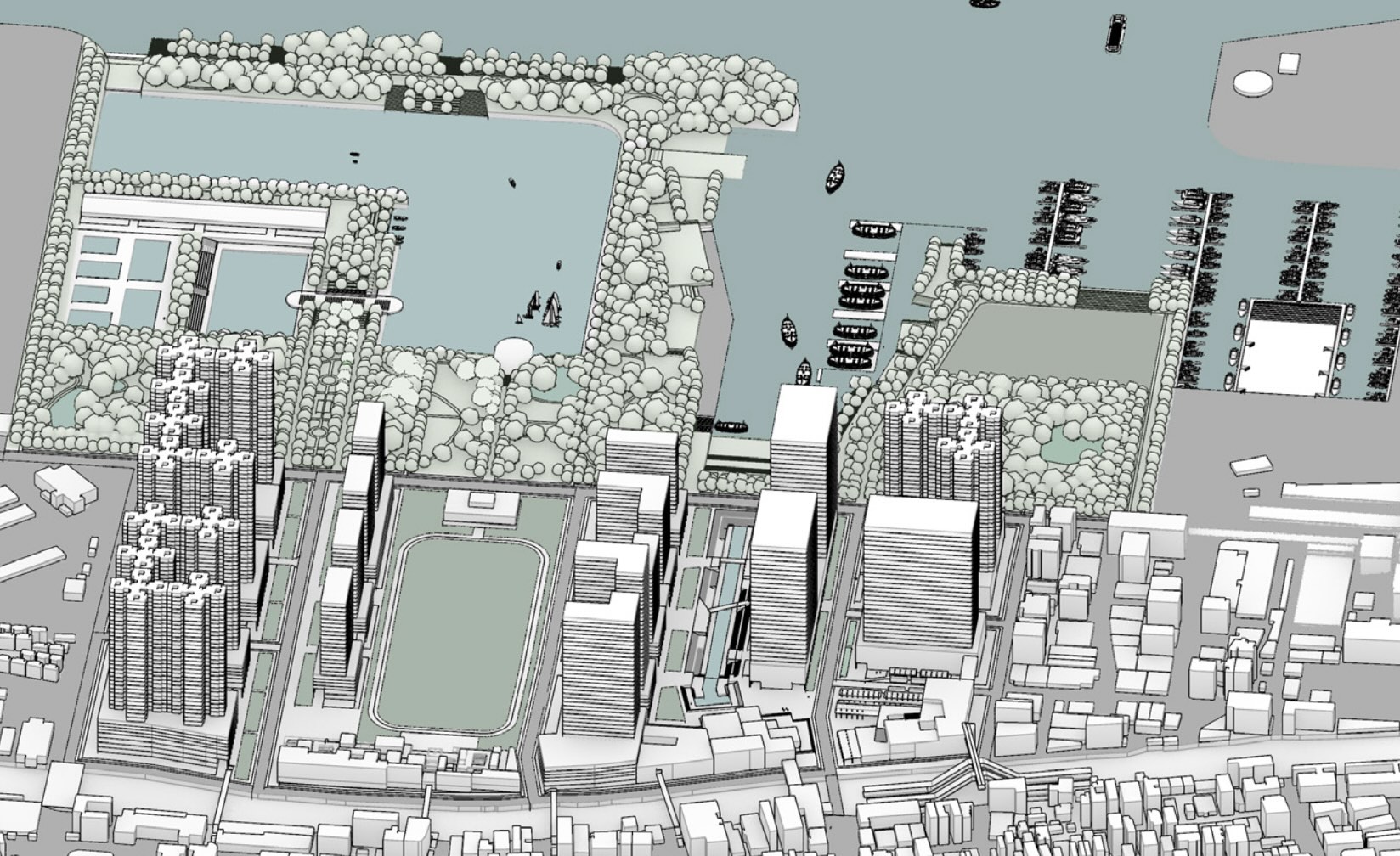
Grafting the Aquarium
Overlooking the Boston Harbor on Central Wharf stands the New England Aquarium, a local landmark and an icon of Brutalist architecture. It is also the subject of “Grafting the Aquarium,” a studio course held during the spring 2025 semester at the Harvard Graduate School of Design (GSD) that addressed complex issues of climate change, aging building stock, and institutional transformation—themes critical to this aquarium and numerous others throughout the world.
The studio’s name, “Grafting the Aquarium,” references the horticultural practice of grafting that has been embraced by Jeanne Gang (MArch ’93), founding partner of Studio Gang and professor in practice of architecture at the GSD, as a model for sustainable design and adaptive reuse. As described in her recent book The Art of Architectural Grafting (Park Books, 2024), “grafting is a design philosophy aimed at upcycling existing building stock by attaching new additions (scions) to old structures (rootstock) in a way that is advantageous to both. The practice of architectural grafting connects the two to create an expanded, flourishing, and distinctive work of architecture.” Rather than engage in the carbon-intensive cycle of demolishing existing buildings and rebuilding from scratch, grafting extends a structure’s life for greater capacity and utility. Taught by Gang and Eric Zuckerman (MArch ’18), project leader in Studio Gang’s New York City office, “Grafting the Aquarium” channeled this design approach to investigate possibilities for the New England Aquarium, a distinguished Boston organization with a celebrated past and an uncertain future.
The New England Aquarium, Then and Now
A cornerstone of the city’s waterfront revitalization plan, the New England Aquarium opened in 1969 to much fanfare. The robust concrete edifice, designed by Peter Chermayeff (MArch ’62) with Cambridge Seven Associates, sits a mere half mile from another Brutalist paragon, Boston City Hall (1963).1
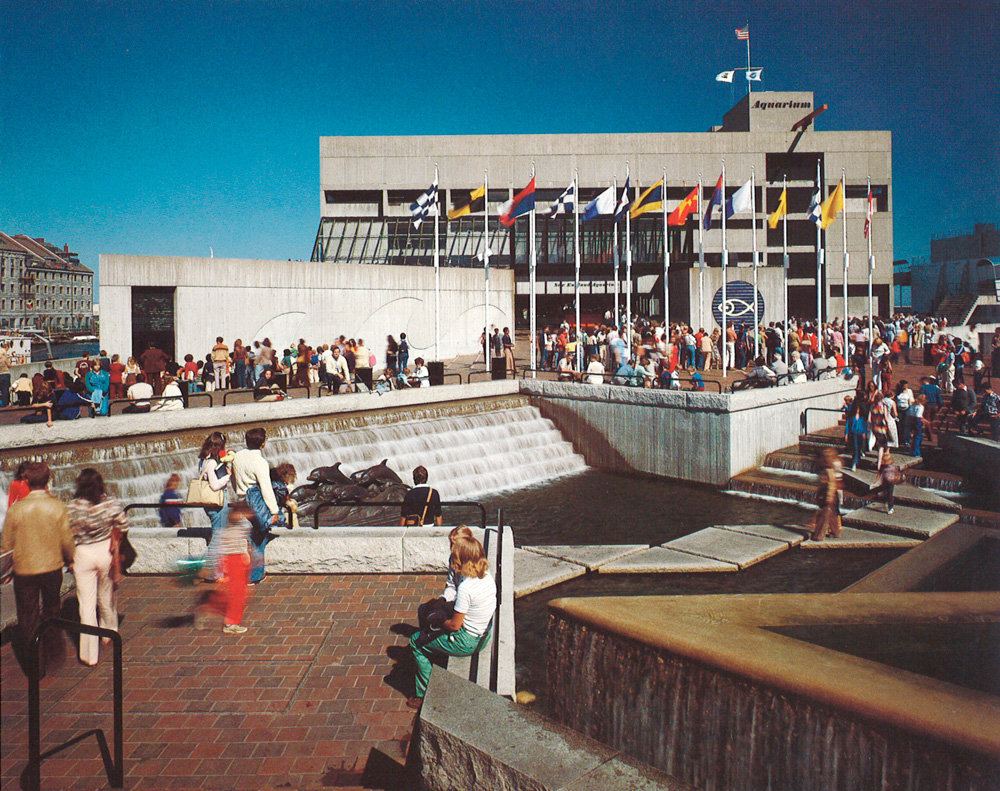
The aquarium’s central feature, around which African and southern rockhopper penguins caper, is the cylindrical Giant Ocean Tank, 40-feet wide and four-stories tall, home to Caribbean marine life ranging in size from tiny reef fish to a 550-lb green sea turtle.2 Nearly five hundred thousand locals and tourists visited the aquarium the year after it opened; now, more than 1.3 million people annually frequent this regional attraction.
To accommodate more visitors and create space for new exhibits, the aquarium has grown in the past half-century, with the original building remaining largely untouched. The Marine Mammal Pavilion appended to the water-facing (east) facade accommodates sea lions; a metal-paneled addition to the west (by Schwartz/Silver Architects, completed in 1996) provides a harbor seal habitat, external ticketing windows, lobby, gift shop, café, and additional exhibit spaces; and the Simons IMAX Theater (2001), constructed on the southwestern portion of the wharf, boasts a six-story 3-D film screen and 378 seats.
Alongside these physical changes to its Central Wharf site, the New England Aquarium’s mission has evolved over the years, moving beyond the expectation for aquariums to serve, first and foremost, as venues for human entertainment. Aquariums previously offered a glimpse into elusive underwater realms; today, images and videos of these foreign ecosystems are accessible through the internet, with the click of a mouse. Furthermore, in recent decades, ethical concerns around keeping animals in captivity, especially incredibly sentient and intelligent species like dolphins and octopuses, have prompted shifts in aquarium programming, as has growing awareness of the deleterious impact of climate change on the ocean and its inhabitants. For these and other reasons, many aquariums—including the New England Aquarium—have become increasingly focused on research and conservation operations.

With this expanded scope come financial and spatial demands that exceed the limited facilities currently available at Central Wharf. Thus, the aquarium’s rescue and rehabilitation site in Quincy, 10 miles south of Boston, houses ethical breeding programs and acute care for injured animals (whether they be ailing residents or cold-stunned wild turtles). Another struture on the coast of Maine serves as homebase for a multi-decade North Atlantic Right Whale research project, one of the aquarium’s many marine science efforts. Mindful of the need for more revenue and additional space, aquarium leadership is keen to explore potentially advantageous programming and partnership opportunities beyond those that currently exist.
Underscoring the mandate for increased funding is the stark reality that the New England Aquarium’s Central Wharf properties require interventions to address the near- and long-term impacts of climate change—in particular, rising sea levels and storm surges. These days the aquarium experiences regular basement flooding, which threatens the animals’ mechanical and filtration life-support systems, and erosion around the Simons Theater’s foundational pilings requires mitigation. Recent resiliency planning calls for flood protection systems to withstand the inevitable tidal and storm flooding that will accompany the rising seas, predicted by 2050 to exceed four feet over current day levels. This knowledge goes hand in hand with climate-driven questions around how and when to protect against, accommodate, or retreat from the water. Consequently, in tandem with refining the institution’s mission and increasing revenue, aquarium officials must contend with aging buildings that need attention to remain operational and survive into the future.
Grafting the 21st-Century Aquarium
Under the guidance of Gang and Zuckerman, twelve GSD students from the master of architecture, landscape architecture, and urban design programs undertook an in-depth analysis of the New England Aquarium. Visits to its facilities, discussions with its leadership, targeted design exercises, and expert-led workshops informed the students about the aquarium and its site as they grappled with the complex themes surrounding the project, ranging from considerations of embodied carbon and vulnerability to sea level rise to designing for biodiversity and non-human species.
The main aquarium building posed an additional challenge. Consultations with Chermayeff provided rare insight into the design intent that shaped the concrete building, the first of the many aquariums in the architect’s portfolio. With its carefully choreographed interior circulation (winding around the Giant Ocean Tank) and its distinct, otherworldly interior (sans daylight, with strategic accent lighting), the New England Aquarium set the standard for Chermayeff’s aquariums that followed, including the National Aquarium (1981) in Baltimore, Maryland, and the Oceanarium (1998) in Lisbon, Portugal. Thus, as they devised their grafting operations to address the New England Aquarium’s future needs, students had to parse Chermayeff’s original vision for the building alongside its historic significance, material nature, environmental impact, and future needs.
As a design philosophy, architectural grafting is especially well suited to urban contexts, which are often marked by decades—if not centuries—of accretion. In her book, Gang notes that, in terms of environmental impact, “all renovations are better than building new. However, certain approaches prove more effective in reducing carbon pollution than others. In order to end greenhouse emissions in the critical period leading up to 2050, delaying the demolition of buildings saves the most carbon over any other single strategy, followed closely by increasing existing buildings’ intensity of use.”3 This holds true for the Brutalist New England Aquarium, making it and its Central Wharf campus perfect candidates for grafting. Following a strategic assessment of the existing site, the benefits it brings, and the challenges it faces, the designer then crafts sustainable solutions that honor the past, minimize carbon expenditure and waste, and build toward a resilient future. This compelling approach merges preservation and innovation to create a new whole greater than its parts.
Building on the concept of grafting, the students’ projects address climatic, economic, and spatial concerns, designs differ in terms of resiliency strategies, envisioned revenue streams, and physical interventions within the Central Wharf site.4 Yet, despite the diversity of approaches, the projects all position architecture as a key force in responding to these pressing issues and in shaping the New England Aquarium’s future. Whether establishing a greater connection with the city or the islands offshore, or highlighting education and animal care, the resulting designs foreground the aquarium as a steward of the marine environment and its resident species, the health of which impacts us all.
Diverse Approaches for a New Age
“Aquatic Symphony”
“Flood-Ready Common Ground”
“Landform to Islands”
“Spectacle & Care”
- Cambridge Seven continues to work with the New England Aquarium. ↩︎
- The aquarium opened in 1969, before completion of the Giant Ocean Tank, which became operational the following year. ↩︎
- Jeanne Gang, The Art of Architectural Grafting (Park Books, 2024), 17. ↩︎
- In May, the students presented their final designs at an end-of-semester review held at the GSD’s Gund Hall. Aside from Gang and Zuckerman, the jury during included Chermayeff, New England Aquarium vice-president of campus operations and facilities Ferris Batie, and GSD faculty members Iman Fayyad, assistant professor of architecture; David Fixler, lecturer in architecture; Stephen Gray, urban design program director; Gary Hilderbrand, Peter Louis Hornbeck Professor in practice of landscape architecture; Toshiko Mori, Robert P. Hubbard Professor in architecture; and Chris Reed, professor in practice of landscape architecture and co-director of the master of landscape architecture in urban design program. Working in pairs or individually, the students proposed an array of design schemes for the New England Aquarium. ↩︎
The Art in Architecture
Spanning the length of Gund Hall’s sunny back patio stands a life-size black-and-white drawing of a stone wall, a cluster of students and critics squinting to assess its merits. This is the final review for Ewa Harabasz’s Graduate School of Design (GSD) course “Drawing for Designers 2, Human Presence: Appearance in Natural and Built Environments.” Students spent the semester observing closely and developing drawing techniques, capping off their work with the final collaborative stone wall project. Each student created a single frame 1:1 scale drawing on large sheets intended for watercolor—bumpy and uneven, creating more texture—which were then pieced together to create a continuous wall.

The range in styles that students developed this semester is evident in the shifting image of the whole from section to section. Tosin Oshinowo , a practicing architect and 2024–2025 Loeb Fellow at the GSD who was enrolled in the class, aimed to capture the “materiality of the stone,” she said, “without copying its patterns of darkness and lightness.” Junye Zhong (MLA ’25) relied on the texture of the paper and the bumpy tack board on top of which it was created to layer texture and strong contrasts, emphasizing the cuts in the stone. One student captured in meticulous detail the ivy at the top of the wall; another portrayed the patches of sunlight on the stones, encouraging the eye to move across the drawing.

The project is the culmination of what Harabasz defined as a semester-long focus on “an expressive and playful supplement to computer-based labor.” Because architecture and design students inevitably spend hours working with various software systems that help them realize their designs, meticulously mapping out structures and landscapes on computer screens, said Harabasz, it’s equally as important that they develop their creativity and drawing skills.
“I want students to gain sensitivity and imagination,” she added, “and to strengthen their perception of the human body and architectural space and design.” She noted that the skills they develop by observing closely and learning to draw will enrich their work across the span of their careers.
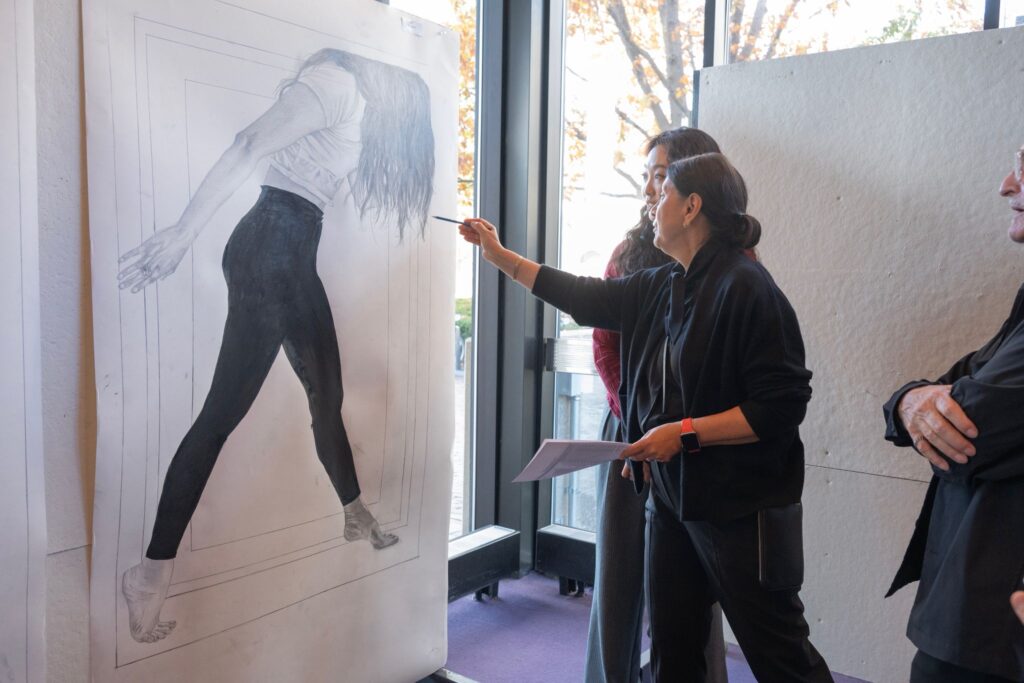
Harabasz is a working artist who hails from Poland. Her drawings, paintings, and mixed-media projects are part of the permanent collection of the National Museum in Poznań, Poland, and have been exhibited in museums around the world, including the Museum of Modern Art in Vaasa, Finland and the Kulturzentrum bei der Minoriten in Graz, Austria. Much of her work is created in large-scale formats, and deals with the violence of war and domestic abuse. Her recent series, “Icons,” for example, features stark photographs of people in the midst of conflict and grief, set on top of gold-leaf backgrounds. The images are reminiscent of medieval portraits of saints, the Madonna, and other religious figures, perhaps inspired in part by her work, earlier in her career, restoring paintings and frescoes in Poland and Italy.

This semester’s work in “Drawing for Designers 2” began with charcoal drawings. Harabasz asked students to home in on an emotional experience, gathering photographs to prompt memories, and to use charcoal in an “additive/subtractive process”—layering it onto the page as a gray base, and then erasing it to create highlights. The subject matter students chose to focus on ranged widely. Oshinowo explained that she had used charcoal in the past, “but never for abstraction.” In composing an image of a braid, she appreciated the challenge to approach the project with a different aesthetic in mind. Sabrina Madera (MArch I ’25) used the assignment to reveal to the group a recent surgery. “I felt I had to show the drawing publicly,” Madera explained. “Drawing the self-portrait forced me to have it out there.”
To offer more insight into the artistic process, Harabasz invited Polish abstractionist Urszula Śliz , PhD, to speak with the class from Poland, via Zoom. Śliz’s work, in mediums from drawing and painting to sculpture and collage, has been exhibited in museums around the world, including the Pavilion of the Four Domes Wroclaw Poland, the Nowich Museum UK, and many other cultural institutions in Europe.
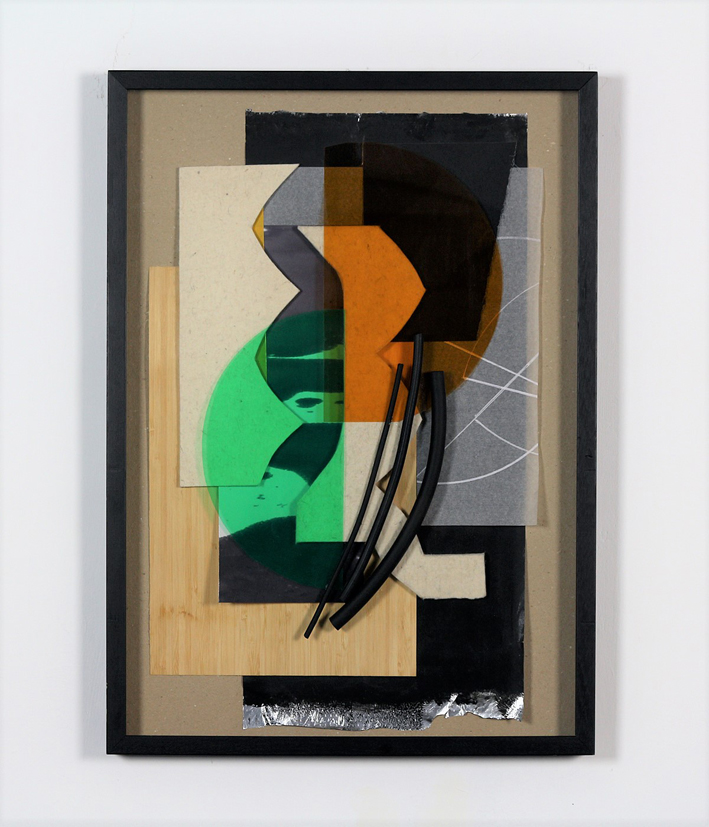
For the last ten years, she’s been working on “Transposition,” a series of collages made from her own photographs of everyday materials, such as construction tape. In one collage, the tape, with red, pink, and white stripes, is criss-crossed over flowers fallen on the ground. Viewers might make their own associations—for Śliz, the red and white make her think of her Polish roots—but, she says, the tape creates its own random shapes and forms, and the photograph serves to re-process the large-scale collage. Part of her inspiration, she explained, was the first known photograph, View from the Window at Le Gras (1826 or 1827) by Nicéphore Niépce, which, she says, transforms the black-and-white rooftops and buildings into abstract forms, estranging the houses from reality—abstract art. Śliz walked students through her process so that they could think about their own place in the art world, sources of inspiration, and how their own work might evolve across mediums.

As Harabasz instructs students on how to quickly and accurately reveal what they see, she also encourages them think about perspective and form in public contexts. Each semester, she and her class install collaborative, mind-bending spatial experiences on the fifth floor of Gund Hall. This winter, their black-and-white optical illusions were made by painting stripes and laying down tape to change the perceived shape of the walls and floors: Here, a new door appears. There, a bulge pushes out. A blue cat perches at the top of wall, playing with a spool of strings. Step to the left or right, and it splits apart on a corner. The installation invites a sense of play, and engagement with other students, faculty, and staff in the space.
For the stone wall critique, several former students of Harabasz’s returned to share their insights. Paul Mok (MArch I ’18) a New York–based architect and artist who was named 2024-2025 GSD Alumni Mentor of the Year , showed the class an in-process drawing that he created using a technique he developed back in 2017, during an independent study with Harabasz (one of four courses he took with her). He’s completed two other highly detailed pen and ink drawings with the same methods, starting with marking the page with unplanned strokes, and then slowly filling to make the image.
“We always ask design students what their concepts are,” he explained, “and critique whether their designs are justified by their rationales. But what about intuition? I started this process of putting random strokes on paper without any preconceived ideas.”
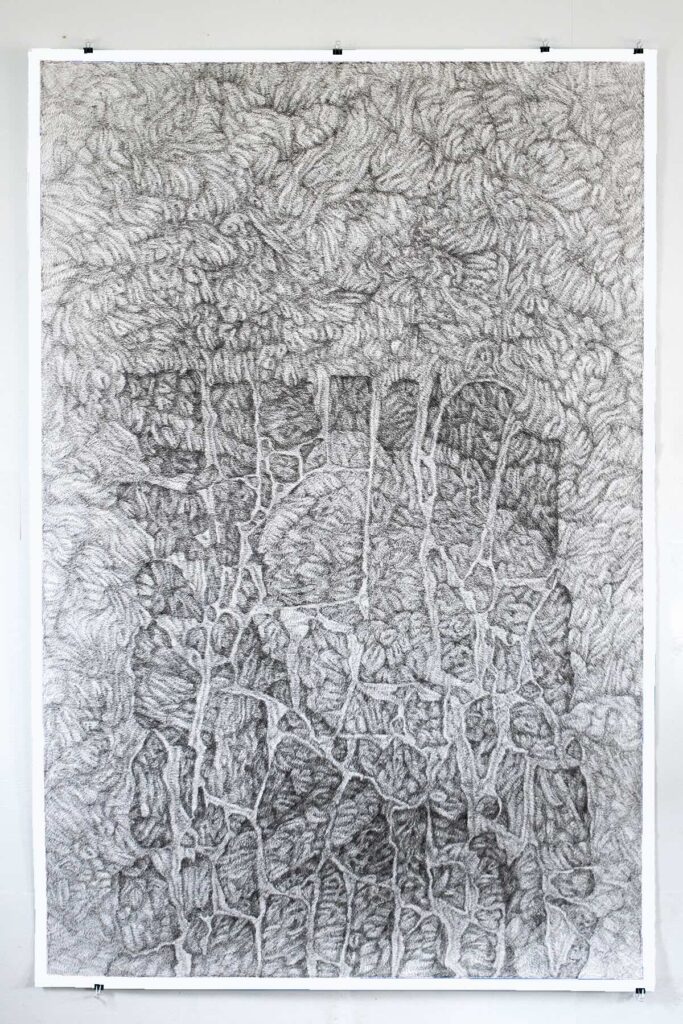
For Mok, drawing is about “letting the mind wander,” an internal counterpoint to his work as an architect creating well-planned structures for others to inhabit. Similarly, two of Harabasz’s former students, Yuetong Li (MDes ’25) and Eva Cao (MDes ’25), spoke to the importance of the drawing classes they took at the GSD in developing their ability to “look not just at one part of an image,” said Li, “but to see the picture as a whole.” Cao appreciated the sense of narrative she developed in the course, combining image and text. They both found that drawing by hand is a useful tool, in addition to digital drawing.
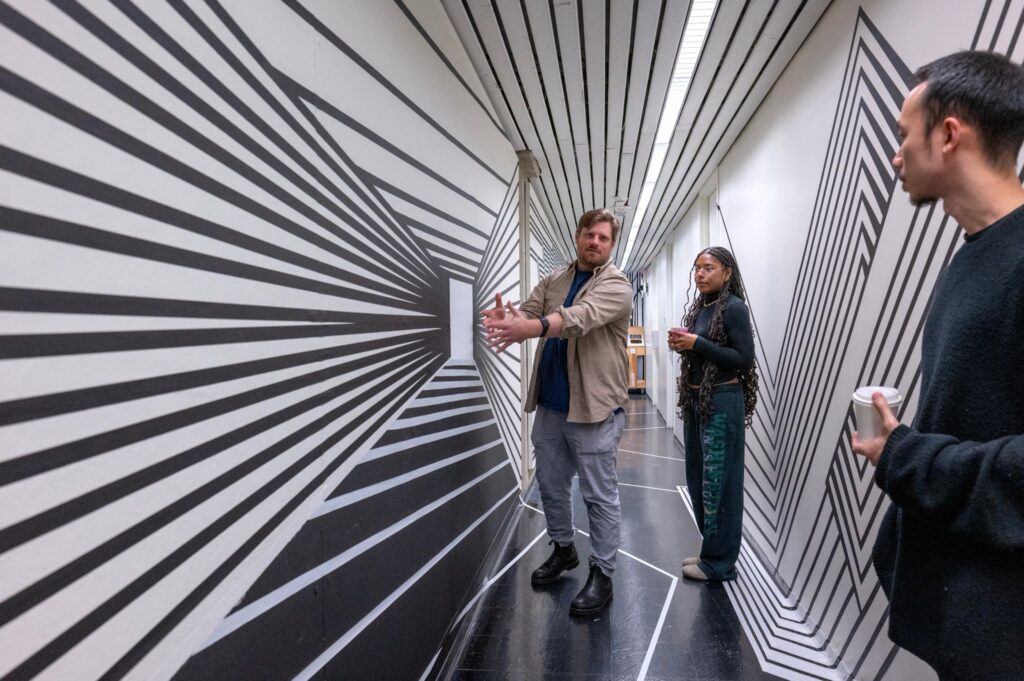
Harabasz argued that developing their hand drawing skills grants designers the power to more clearly share their vision with others, and, perhaps even more importantly, to express who they are and what they value: “How do you view the world? What’s important? What do you see first, and second? How do we push the viewer to read the image as we want them to? This is what I teach.”
When the High Tech Abounds, the Low Tech Shines: A Review of the 2025 Venice Architecture Biennale
Across from the main entrance to the 2025 Venice Architecture Biennale stands a courtyard lined with bamboo scaffolding. An ancient Chinese structure fashioned with lashed bamboo poles, such scaffolding dates back thousands of years and remains ubiquitous throughout Hong Kong, wherever construction is underway.
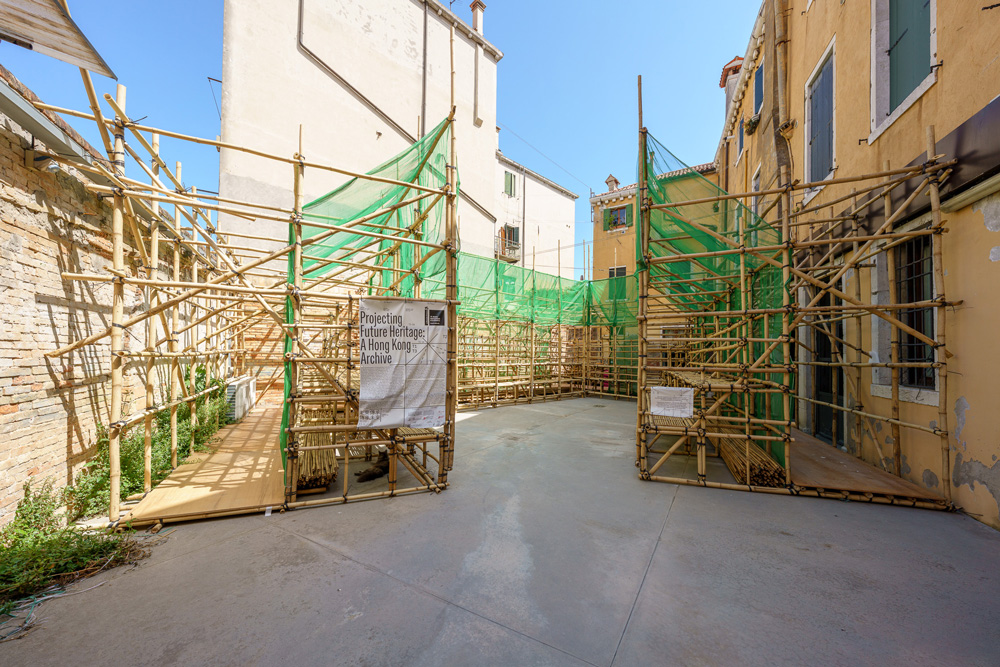
This particular bamboo scaffolding, erected in a Venetian courtyard, serves a different purpose: it is both set piece and enticement, part of a collateral event called Projecting Future Heritage: A Hong Kong Archive , curated by GSD alumni Fai Au (MDes ’11) and Ying Zhou (MArch ’07) with Sunnie Sy Lau. The scaffolding draws in visitors, showcasing its artful existence while leading to an adjacent warehouse-turned-gallery that catalogs examples of Hong Kong’s post-war building typologies and infrastructures.1 Employing natural materials and collective practices, the bamboo scaffolding evokes a sense of ingenuity and timelessness.
This year’s architecture biennale, also known as the 19th International Architecture Exhibition, carries the theme “Intelligens. Natural. Artificial. Collective. ” Explaining this title, curator Carlo Ratti aligned the Latin intelligens with multiple forms of knowledge available to humankind. (Gens, after all, is Latin for people). Nevertheless, since the biennale opened last month, reviews—including “A Tech Bro Fever Dream” and “Can Robots Make the Perfect Aperol Spritz?” — have largely focused on the omnipresence of technology. True, the high tech abounds in a range of guises, from algae-infused building materials to sensor-ladened space skins. Yet, even as the dangling automatons and LiDAR maps underscore the “Artificial,” an expansive understanding of intelligence, one that embraces the “Natural” and the “Collective,” remains palpable, especially among contributions by members of the GSD community. This undercurrent surfaces through visitors’ “low tech” experiences with sensorial input, animal encounters, and communal engagement.
A Multisensory Biennale
The 2025 Architecture Biennale encompasses 300 installations, 66 National Pavilions, and 11 collateral events (as well as more than 100 GSD-affiliated contributors). Given this concentration of projects, one would anticipate an array of sights, sounds, scents, and atmospheric conditions. What appears striking, however, is the number of projects that rely on visitors’ immersive and multisensory involvement for full effect.
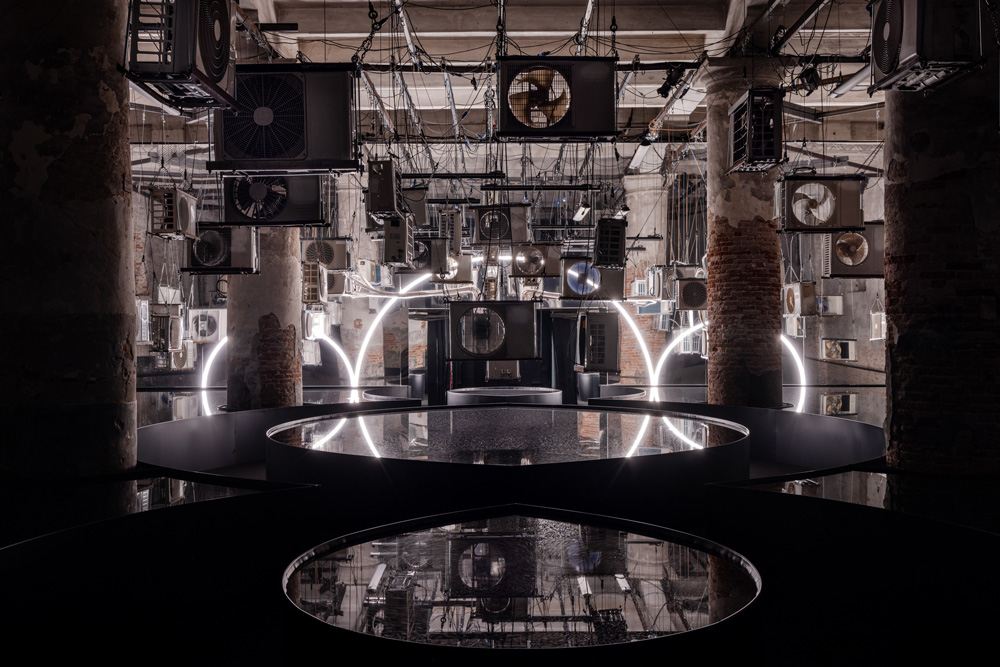
While most installations discourage hands-on interaction (“non toccare!”), tactile sensation nonetheless reigns supreme. This begins with Ratti’s main exhibition, staged primarily in the Arsenale’s Cordiere (a former rope factory/warehouse), which opens with the project Terms and Conditions . Here visitors move from the bright Venetian sunlight to a dim, muggy vestibule containing the waste heat from the air conditioning system that maintains the vast hall beyond at a comfortable 23 degrees Celsius (73.4 degrees Fahrenheit). The oppressive heat envelops visitors, offering them a glimpse of Venice’s projected future climatic conditions as they move beneath suspended air conditioning units, finally emerging into the Cordiere’s cool, light-filled, low-humidity interior where hundreds of exhibits await.
The immersive experiences continue with installations that cloak visitors in sound—dripping water; awe-inspiring music reminiscent of Stanley Kubrick’s 2001 Space Odyssey; humming frequencies, and more. One such exhibit—Oxyville by Jean-Michel Jarre, Maria Grazia Mattei, and GSD professor Antoine Picone—uses electronic music to explore the relationship between 3D audio and architecture. Within a space illuminated by glowing blue lights, visitors experience soundtracks that conjure different “sonic architectures,” such as that of a cathedral or, perhaps, a nightclub.
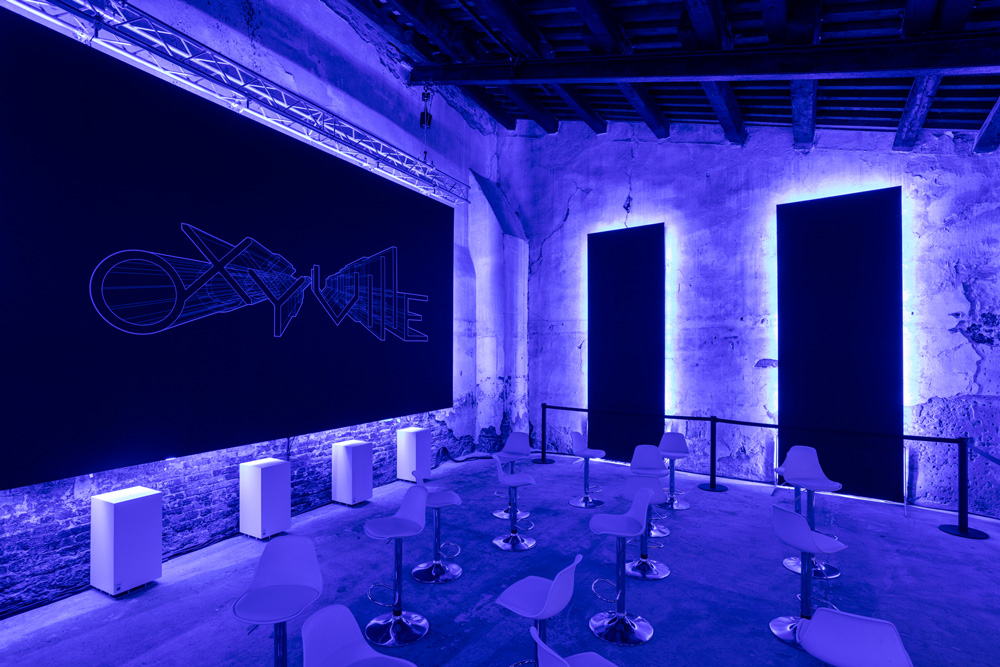
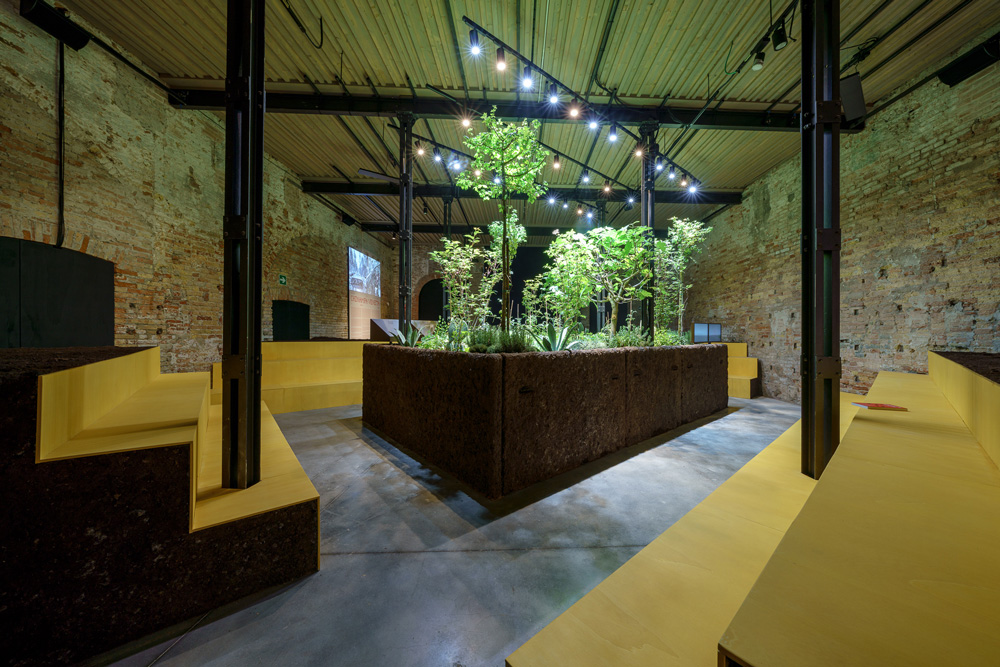
Other exhibits involve perceptible odors. Their inclusion isn’t necessarily intentional, although it is for some installations, such as Sound Greenfall and Grounded , the Türkiye Pavilion. Still, in many circumstances, discernable aromas become integral experiential components of a given project. For example, with its dense concentration of indoor microclimate-producing plants, Building Biospheres —the Belgium Pavilion, curated by GSD professor Bas Smets and Stefano Mancuso—proves incredibly fragrant. Meanwhile, the rectangular blocks of earth (chinampas) that populate Chinampa Veneta , the Mexico Pavilion, evoke the shallow-water environments in which these life-supporting landscape elements traditionally float.
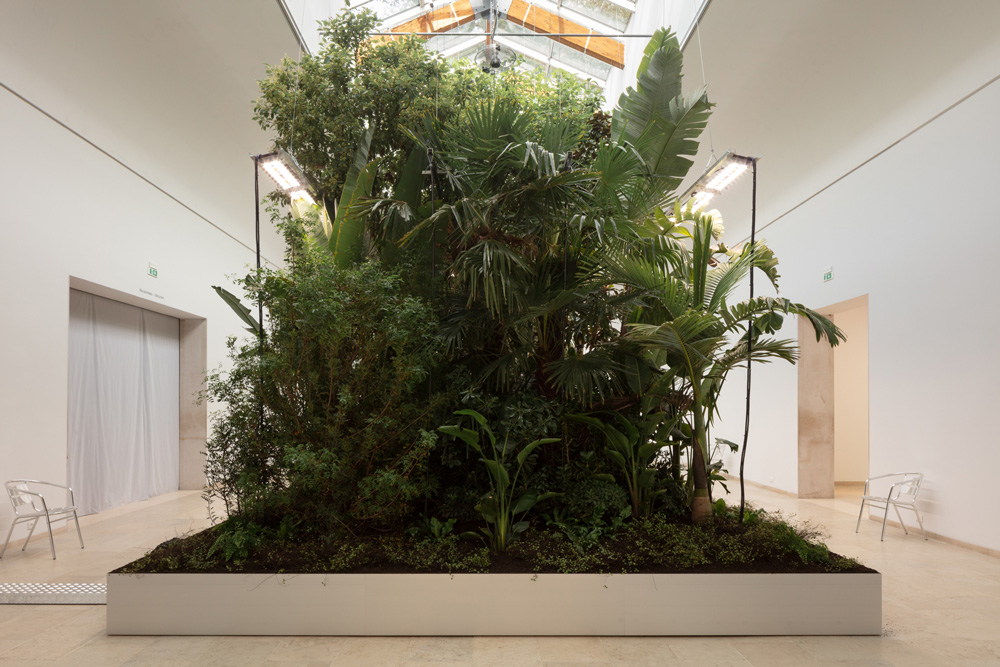
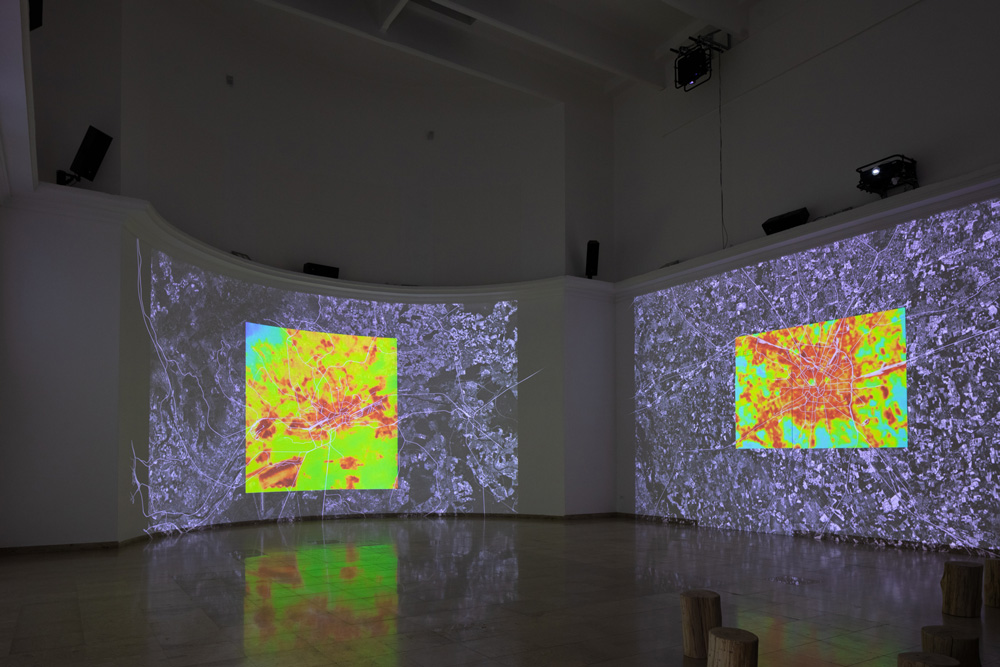
The exhibits are diverse visually, with intriguing dynamic elements and textured surfaces—smoke, water, lava, wood, vegetation—to catch one’s eye. Film features prominently, at times animating wrap-around enclosures to immerse visitors in the imagery. Stresstest , the German Pavilion (which includes a projects by GSD alumni Frank Barkow [MArch ’90], Regine Leibinger [MArch ’91], and design critic in landscape architecture Silvia Benedito [MAUD ’04]), employs this strategy, filling three walls of the pavilion’s soaring main space with infrared heat maps and alarming news footage of warming city centers. (A tolling bell—our planet’s death knell?—sounds in the background). Former GSD Loeb Fellow Tosin Oshinowo (LF ’25) harnesses a similar approach on a smaller scale for Alternative Urbanism: The Self-Organized Markets of Lagos . This installation’s screens surround visitors with the bustling activity of three Nigerian markets that recirculate so-called waste items from industrialized societies (clothing, auto parts, and more)—repairing, altering, and reusing them to create a sustainable system that transcends conventional patterns of consumption.
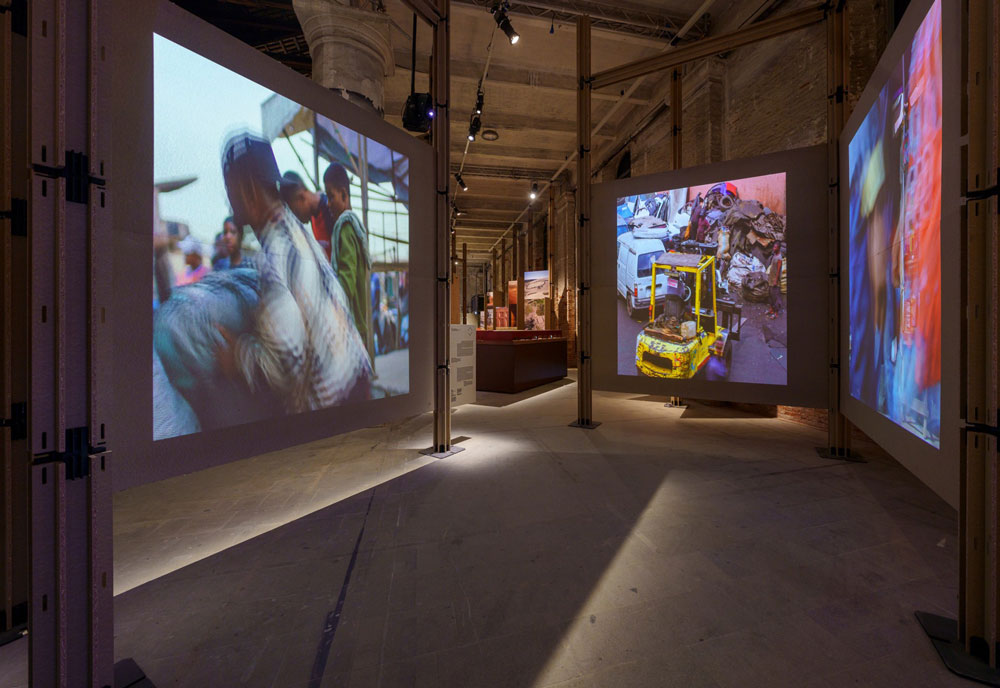
While planning the 19th International Architecture Exhibition, Ratti and his curatorial team no doubt recognized that all this sensory input could prove overwhelming. Perhaps this is one reason behind the minimalist AI descriptions that appear, in English and Italian, alongside the designers’ longer project explanations. Some may be disturbed by these pared-down depictions, at times a mere two sentences versus the designers’ original multi-paragraph text; have critical nuances been lost? Is this a commentary on the human attention span? Does architectural discourse really require such CliffsNotes? All these may well be the case. Yet, after experiencing a few dozen installations and realizing hundreds more await, it becomes clear that, whatever else they may be, the AI descriptions are a kindness, a “low-power mode” for visitors’ mental stamina as they undertake this endurance event. An added bonus: the AI text ruthlessly eliminates the discipline’s notorious archi-speak, in theory making the biennale more accessible to the public, including the mass of tourists who roam the Venetian cobblestone streets.
Animal Encounters
Aside from thieving seagulls and Piazza San Marco’s iconic winged lion, animals aren’t often associated with Venice, by said tourists or locals. A number of biennale installations seek to change this, including The Living Orders of Venice by Studio Gang, led by GSD professor Jeanne Gang. This project uses iNaturalist , a citizen science app, to enact a Biennale Bioblitz : a crowd-sourced field study to document local animal activity during the show’s 6-month run. In addition, the firm’s exhibit in the Cordiere showcases prototypical habitats to accommodate Venice’s non-human residents—the birds, bats, and bees displaced throughout centuries of construction, which destroyed their natural architectures. Instrumental for the planet’s health, these creatures require appropriate homes in increasing crowded urban centers, and Studio Gang proposes species-specific abodes to complement Venice’s existing classical architecture.

Architecture for animals likewise plays a role in Song of the Cricket , which models a rehabilitation effort for endangered species—in this case, the Adriatic Marbled Bush-Cricket, believed extinct for fifty years before its 1990s rediscovery in the wetlands of northeastern Italy. Alongside integrated research and monitoring programs, Song of the Cricket offers modular, floating islands as portable breeding stations that reintroduce healthy cricket populations to the Venetian Lagoon. Emblazoned with “BUSH-CRICKETS ON BOARD,” these temporary habitats support multiple cricket lifecycles, reducing threats of predation and disease. Other components of the project include a sound garden featuring the crickets’ song, described “as a bioindicator of ecosystem health,” unheard in Venice for over a century.

Similarly, animals emerge as crucial contributors in the Korea Pavilion, titled Little Toad, Little Toad: Unbuilding A Pavilion . With the project Overwriting, Overriding , exhibitor/GSD alumna Dammy Lee (MArch ’13) turns to the structure’s non-human occupants—a large honey locust tree and Mucca, “the [cow-spotted] cat who roams the space as if it were its own home”—to interrogate the pavilion’s history, highlighting the “hidden entities that have silently coexisted with the pavilion.” The installation 30 Million Years Under the Pavilion , by artist Yena Young, complements this narrative with a camera mounted beneath the structure to document unexpected visitors. The footage reveals that Giardini critters regularly frequent this and presumable all pavilions, which typically remain closed to the public when a biennale is not in session. (One is reminded of Remy the Cat, the unofficial GSD mascot who trapses through Gund Hall at will.) Thus the Korea Pavilion, built in 1995 yet reminiscent of Le Corbusier’s designs of the 1920s, serves as a home for not just the architects, artists, curators, and works they produce, but also cats (Mucca and two others), mice, birds, spiders, flies, and even a hedgehog—all cataloged by hand in pencil below wall-mounted Ipads that depict their visits. Amid the hi-tech fanfare that characterizes much of the 2025 Architecture Biennale, the ease, simplicity, and whimsy of Lee’s and Young’s projects, in conception and execution, feels particularly powerful.
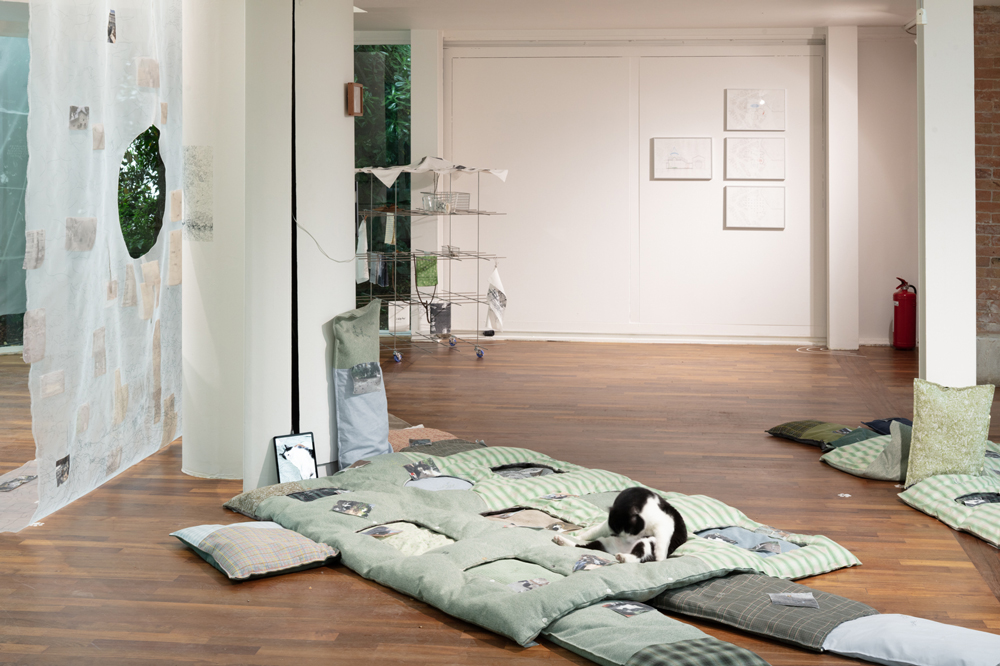
The Power of Community
The Polish Pavilion, Lares and Penates: On Building a Sense of Security in Architecture , offers another commanding and clever presentation that shines among the National Pavilions. Infused with its own dose of whimsy, this exhibition zeros in on the ways in which architecture creates a sense of security, relying on two concepts from two very different communities: solutions derived from conventional building and health regulations, such as roofs, electrical codes, and evacuation signs; and others rooted in traditional Slavic cultural practices like brandishing dowsing (divining) rods to determine fortuitous home placement, installing horseshoes in doorways for luck, and burning smudge sticks to banish negative energy from a space. Lares and Penates, defensive household deities of Ancient Rome, lend their name to the exhibition while its designers present these security-bestowing practices as equally valid, complementary elements that, as a brochure accompanying the pavilion states, “help people feel more secure in a swiftly changing reality.” This non-judgmental approach is exemplified by the placement of a bright red fire extinguisher at the heart of a stone-and-shell encrusted niche. Fire codes, after all, are sacred in their own way.
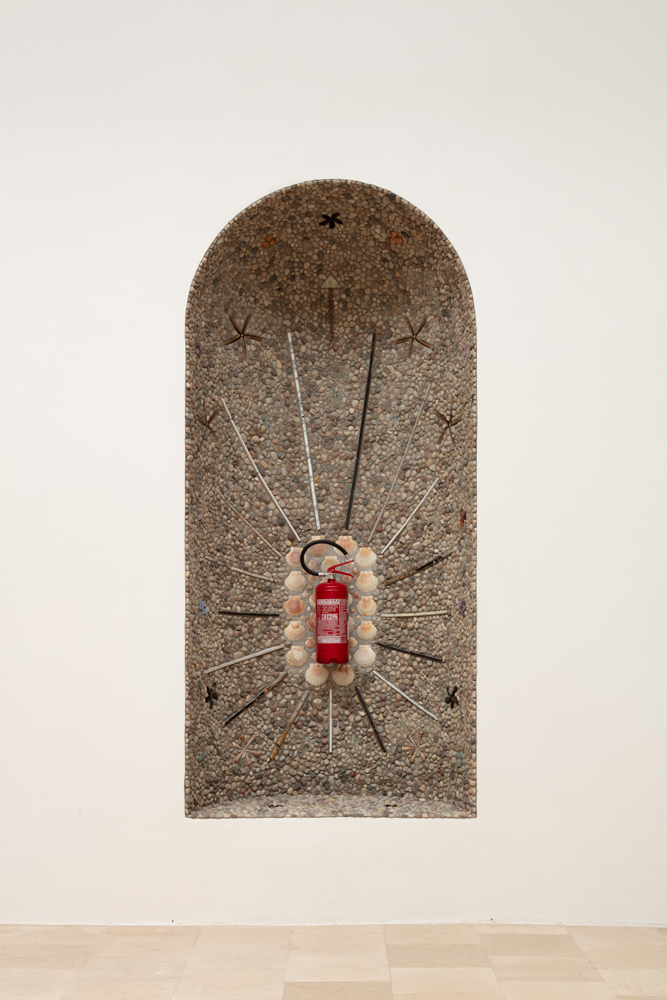
While highlighting the human desire for security, the Polish Pavilion also alludes to our innate tendency to find strength in community, to connect with others to share ideas, resources, and support. Since its inception in 1980, Venice’s International Architecture Exhibition has embodied this urge for the cultivation of community on a global scale. That people today continue to congregate for the biennale, even though digitalization makes it possible to distribute knowledge without transcontinental trudging, indicates that many still yearn for actual (versus virtual) contact. Two installations openly address this impulse, as they provide platforms for present-day gathering and discussion. At the same time, they offer clear connections to the biennale’s communal past.
The Speakers’ Corner , by Christopher Hawthorne, former Loeb Fellow Florencia Rodriguez(LF ’14), and GSD design critics Sharon Johnston (MArch ’95) and Mark Lee (MArch ’95), who comprise the firm Johnston Marklee, offers a forum for workshops, lectures, and panels within the Cordiere. The inspiration for this sixty-person grandstand, made of unfinished white pine, stems from the 1980 Architecture Biennale—specifically, I Mostri d’Critici, curated by architectural historians/critics Charles Jencks, Christian Norberg-Shulz, and Vincent Scully, underscoring the disciplinary role of criticism and discourse. Throughout the 2025 biennale’s run, the Speakers’ Corner is hosting a series of events focused on future possibilities for architecture criticism—including those posed by the emerging role of artificial intelligence, as signaled by the biennale’s AI project descriptions.

The other installation that highlights collective gathering and this biennale’s connection with the past is Aquapraça by CRA – Carlo Ratti Associati and Höweler + Yoon (founded by GSD professor Eric Höweler and alumna J. Meejin Yoon [MAUD ‘02]). Envisioned as a floating plaza to prompt discussions around climate change, this 400-square-meter entity will debut in the Venice Lagoon on September 4 before migrating across the Atlantic Ocean to join COP30 in Belém, Brazil, in November of this year. (A large model of the floating platform is currently on display in the Cordiere.) Aquapraça’s pure geometries recall those of Aldo Rossi’s Teatro del Mondo of 1979, a floating wooden theater that became an icon of the First Architecture Biennale before traveling via tugboat to Dubrovnik.
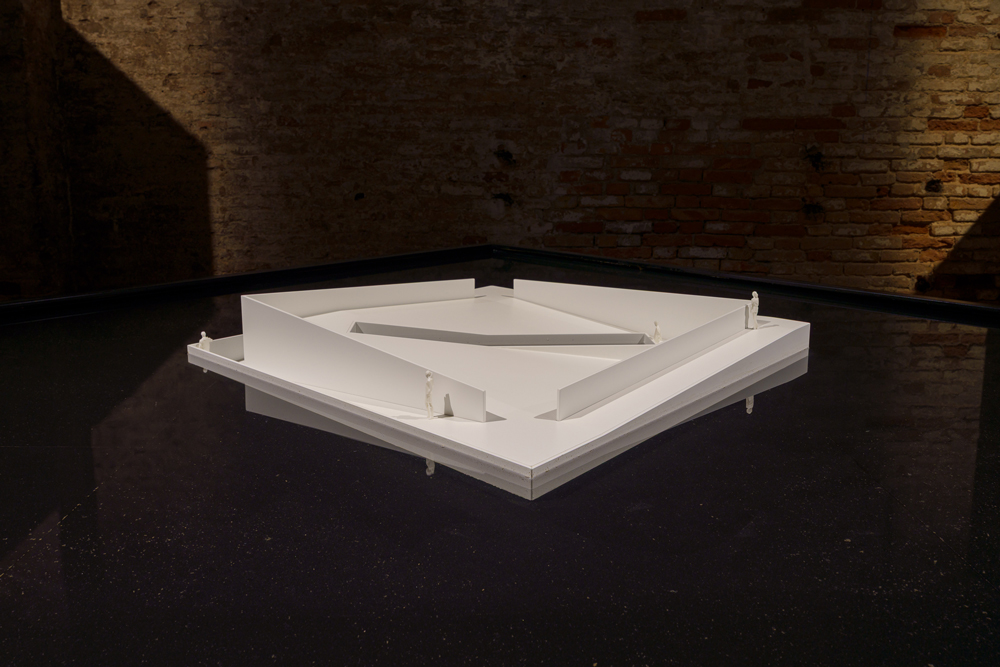
It is no accident that both the Speakers’ Corner and Aquapraça echo the aesthetic simplicity and communal intent of Rossi’s aquatic building. These projects illustrate the human desire to gather, to experience sights, sounds, and environments in real life. The sustained existence of the biennale attests to the continued significance of collective intelligence as well as creating places and events that bring people together.
- In addition to Fai Au (MDes ’11) and Ying Zhou (MArch ’07), Projecting Future Heritage includes many GSD affiliates. Jonathan Yeung (MArch ’20) and Wing Yuen (MArch ’22) are part of the curatorial team. Exhibitors include Max Hirsh (PhD ’12) and Dorothy Tang (MLA ’12) with Airport Urbanism: Remaking Hong Kong, 1975–2025; Su Chang (MArch ’17) and Frankie Au (MArch ’16) of Su Chang Design Research Office with Made in Kwun Tong: Between Type and Territory; and Betty Ng (MArch ’09), Chi Yan Chan (MArch ’08) and Juan Minguez (MArch ’08) of Collective with Pixelated Landscapes. ↩︎
